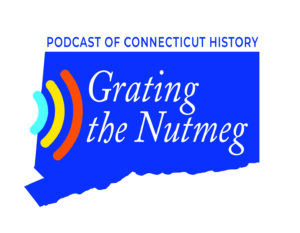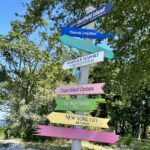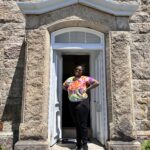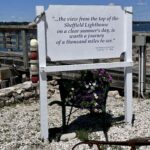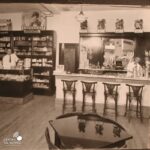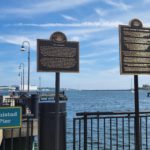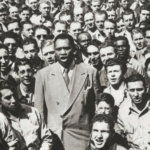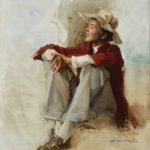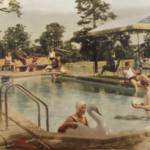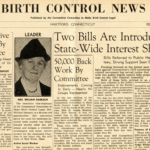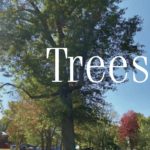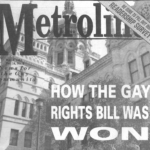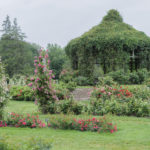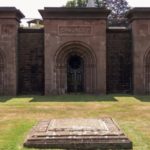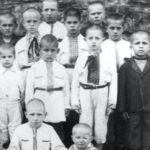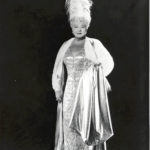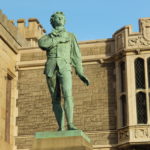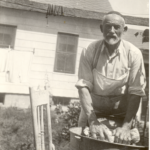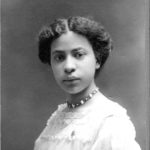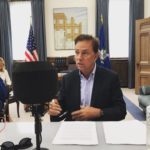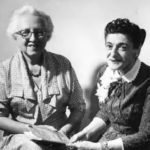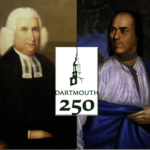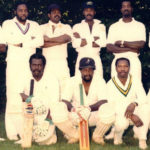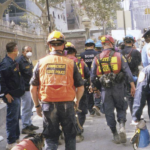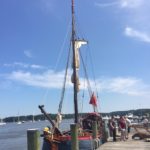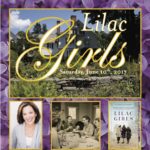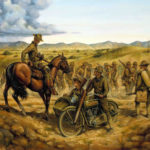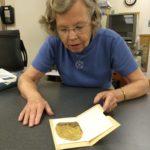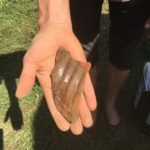Brought to you by Connecticut Explored
LISTEN HERE
Grating the Nutmeg offers stories about Connecticut history that you can listen to on your phone, tablet, or computer whenever you want.
To hear more episodes of Grating the Nutmeg subscribe on iTunes, IHeartRadio, GooglePlay, Spotify or at gratingthenutmeg.libsyn.com.
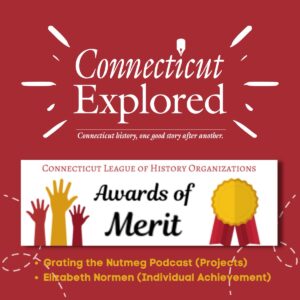 Fresh episodes of Grating the Nutmeg are brought to you every two weeks with support from our listeners. We’ve just launched our Facebook and Instagram pages, so please follow us on social media to get the scoop on new episodes, behind the scenes photos, and information on upcoming programs: https://www.facebook.com/GratingTheNutmegPod
Fresh episodes of Grating the Nutmeg are brought to you every two weeks with support from our listeners. We’ve just launched our Facebook and Instagram pages, so please follow us on social media to get the scoop on new episodes, behind the scenes photos, and information on upcoming programs: https://www.facebook.com/GratingTheNutmegPod
______________________________________________________________________
Would you like to MAKE A DONATION to Grating the Nutmeg? We’re in the process of adding GTN to the Connecticut Digital Archive (CTDA), and while our podcasts our free, the production costs are on us. Your generous donations defray those costs and we’re so appreciative of your support!
______________________________________________________________________
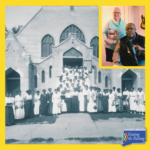 181. Hartford and the Great Migration, 1914-1950
181. Hartford and the Great Migration, 1914-1950
n the February 4, 2024 issue of the New York Times, journalist Adam Mahoney describes the Great Migration as a time when millions of Black people left the South to escape segregation, servitude and lynching and went North in search of jobs and stable housing. In this episode, host Mary Donohue will discuss Hartford and the Great Migration with Dr. Stacey Close. Connecticut Explored’s book African American Connecticut Exploredpublished by Wesleyan University Press has just celebrated its 10th anniversary. Dr. Close served as one of the principal authors for this groundbreaking volume of essays that illuminate the long arc of Black history in Connecticut.
A native of Georgia, Dr. Close has worked in higher education for more than 25 years. A professor of African American history at Eastern Connecticut State University, Close received his Ph.D and M.A. from Ohio State University and his B.A. from Albany State College, a Historically Black College in Georgia. He is currently working on a book project entitled Black Hartford Freedom Struggle, 1915-1970.
Thanks to my guest Dr. Stacey Close. Read his article published in Connecticut Explored here:
https://www.ctexplored.org/southern-blacks-transform-connecticut/
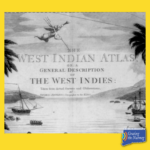 180. Colonial Connecticut: Sugar, Slavery and Connections to the West Indies
180. Colonial Connecticut: Sugar, Slavery and Connections to the West Indies
Although Connecticut sometimes seems like such a small, isolated place on the map, it was connected to the far-flung, complex, cosmopolitan British empire even in the 17th century. This year on Grating the Nutmeg, we’re going to explore Connecticut’s maritime history with episodes on Colonial Connecticut’s trade with the British colonies of the Caribbean, privateering during the American Revolution and the whaling ships sent around the globe in the nineteenth century. Connecticut’s maritime entrepreneurs made fortunes by sending ships to sea and employed sailors, shipbuilders, traders, drovers, provisioners, and more.
In this episode, we talk about sugar. Sugar production in the tropical climate of the British islands of the West Indies made men tremendous fortunes. But to cultivate and process sugar cane into sugar required vast amounts of labor. As my guest Dr. Matt Warshaurer wrote in the Summer 2023 issue of Connecticut Explored, “The fields and mills of the Caribbean were worked by African peoples stolen from their homes, placed in shackles and delivered to British colonies in North American and the Caribbean.” Connecticut’s ships delivered food and building materials to the islands and returned with sugar, rum and molasses. These were then traded for finished goods from England-furniture, china, glass, textiles. We’ll hear today about how the trade route known as the “Triangle Trade” moved people, products, and goods across the Atlantic Ocean, helping to make British plantation owners as well as some Colonial Connecticut families rich.
My guests today are Dr. Matt Warshauer, professor of history at Central Connecticut State University and Dr. Katherine Hermes, the publisher of Connecticut Explored. The author of five books and countless articles and reviews, Warshauer has written extensively on Andrew Jackson, slavery and the Civil War. Dr. Warshauer serves on the editorial board for Connecticut Exploredmagazine and in the Summer 2023 issue authored the feature story “Connecticut’s Sweet Tooth: The Sugar Trade and Slavery in the West Indies”. Hermes is the director and historian for the award-winning public history project “Uncovering their History: African, African-American, and Native-American Burials in Hartford’s Ancient Burying Ground, 1640-1815”. She recently completed two new projects for the Ancient Burying Ground Association including one telling the stories of people with connections to the West Indies and one on women-Black, White and Indigenous-who rest in the Burying Ground.
To read this story, please go to https://www.ctexplored.org/connecticuts-sweet-tooth-the-sugar-trade-and-slavery-in-the-west-indies/
To read more about these projects, please go to:
https://ancientburyingground.com/projects/telling-new-stories/
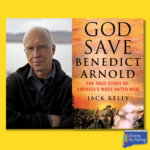 179. Connecticut’s Benedict Arnold: America’s Most Hated Man
179. Connecticut’s Benedict Arnold: America’s Most Hated Man
This is our first new episode for 2024 and we’ve got some big news! Thanks to you-our listeners-we had 30,106 downloads in 2023! That’s our best year ever! We have brand new Facebook and Instagram pages under Grating the Nutmeg-please follow us and you’ll get behind the scenes photos, sneak peeks of new content, and info on how to purchase our new merchandise!
In today’s episode, we discuss one of the most well-known sons of Connecticut and one that is one of the most perplexing! My guest is Jack Kelly, historian and author of the new book God Save Benedict Arnold: The True Story of America’s Most Hated Man. Kelly believes a reevaluation of Arnold’s career with his string of heroic achievements as well as his betrayal of the American patriot cause is needed. In Connecticut, Benedict pivots from being a greatly admired hero of the Battle of Ridgefield on the American side to being the commander of the British troops that burned New London and massacred American militia men at Fort Griswold. How could this happen?
Jack Kelly is an award-winning historian and novelist. His books about Revolution and early America include Band of Giants and Valcour. Kirkus Reviews described his latest book, God Save Benedict Arnold: The True Story of America’s most Hated Man as “a dazzling addition to the history of the American Revolution.”
Jack has received the DAR History Medal. He is a New York Foundation for the Arts fellow in Nonfiction Literature and has appeared on NPR, C-Span and the History Channel. He lives and works in New York’s Hudson Valley.
To find out more, go to his website: https://JackKellyBooks.com
and newsletter: https://jackkellyattalkingtoamerica.substack.com
To find out more about Benedict Arnold, check out these Connecticut Explored stories-
https://www.ctexplored.org/benedict-arnold-and-the-battle-of-ridgefield/
https://www.ctexplored.org/benedict-arnold-turns-and-burns-new-london/
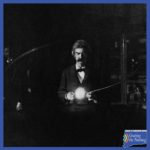 178. Mark Twain, Spiritualism and Ghost Stories
178. Mark Twain, Spiritualism and Ghost Stories
Did you ever think the universe was trying to tell you something? I just finished reading Anderson Cooper’s book on the Vanderbilt family. In it, he describes family patriarch Commodore Vanderbilt’s interest in Spiritualism and clairvoyance. Cooper writes “Evidence suggests that the Commodore had begun attending seances as early as 1864, but given the mainstreaming of Spiritualist practices in the 1860s and ‘70s, this was not as unusual as it may sound. The period immediately after the Civil War had seen a dramatic rise in the Spiritualism movement and other alternative modes of healing and perception, driven largely by the staggering loss of life experienced during the Civil War.” We explored heiress Theodate Pope Riddle’s obsession with Spiritualism in Grating the Nutmeg episode #109 but what did Hartford’s most famous resident of the Gilded Age, Mark Twain, think about it? And what about the ghosts seen in the Twain House? Whether you believe in the afterlife, don’t believe in it at all, or just want to come to your own conclusions, this is an episode for you!
Guests today are Mallory Howard, Assistant Curator at The Mark Twain House & Museum and Dr. Jason Scappaticci, historian and Associate Dean of Student Affairs at Connecticut State Community College Capital in Hartford.
And if you need more ghostly insight after listening to this episode, the Mark Twain House is sponsoring a book talk on Dec. 14, 2023 at 7:30pm with television’s Ghost Hunters Adam Berry and Steve Gonsalves in conversation discussing their debut books. Tickets are available on the museum’s website at marktwainhouse.org
If you want more Spiritualism and ghost stories, check out Grating the Nutmeg Episode 109. Communicating with the Spirits: Theodate Pope Riddle. Listen here: https://gratingthenutmeg.libsyn.com/109-communicating-with-the-spirits-theodate-pope-riddle
You can purchase author Steve Courtney’s book “We Shall Have Them With Us Always” The Ghosts of the Mark Twain House at the Mark Twain House Museum gift shop.
Dr. Jason Scappaticci can be reached at jason.scappaticci@gmail.com
image: Samuel Clemens experimenting in Nicola Tesla’s lab in 1894. Courtesy of The Mark Twain House & Museum, Hartford, Connecticut.
This episode of Grating the Nutmeg was produced by Mary Donohue and engineered by Patrick O’Sullivan at https://www.highwattagemedia.com/
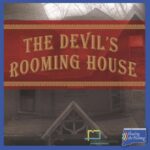 177. Murder on Prospect Street
177. Murder on Prospect Street
In this episode of Grating the Nutmeg, Natalie Belanger sits down with acclaimed crime writer M. William Phelps to get to the bottom of a notorious early 20th century Connecticut murder story. In the 1910s, Amy Archer Gilligan operated an innovative business in Windsor: a convalescent home for the ill and elderly. Her benevolent facade, however, hid a deadly purpose: a business plan that depended on constant inmate turnover, aided by arsenic poisoning. You’ll hear all about how the case was broken by a neighbor who happened to write for the Hartford Courant, in a story involving midnight graveyard autopsies, poisoned lemonade, a shady doctor, and the birth of the Connecticut State Police. And oh yeah, the story got turned into a blockbuster Broadway comedy and a 1944 movie starring Cary Grant.
Find more historical true crime content in the latest exhibition at the Connecticut Museum of Culture and History. Called “Connecticut’s Bookshelf,” the exhibit covers 300 years of reading, writing, and publishing in our state. A “true crime” section in the exhibit features stories that document Connecticut’s centuries-old fascination with criminal mayhem. Go to connecticutmuseum.org for details.
Thanks to our guest! M. William Phelps is the author of 45 books; exec-producer, writer and host of the #1 true-crime podcast franchise Paper Ghosts; a frequent television consultant and contributor, and more.
Contact Natalie Belanger at the Connecticut Museum of Culture and History, Hartford, Connecticut.
This episode of Grating the Nutmeg was produced by Natalie Belanger and engineered by Patrick O’Sullivan at https://www.highwattagemedia.com/
 176. Witchcraft Uncovered: New Discoveries and Exonerations
176. Witchcraft Uncovered: New Discoveries and Exonerations
Witchcraft accusations began in Connecticut in May, 1647, with the trial and execution of Alice Young of Windsor, 45 years before the better-known witch trials in Salem, Massachusetts. Connecticut had witchcraft accusation outbreaks in the early 1660s in Hartford and again in Fairfield in 1692, with criminal trials ending in 1697. In colonial Connecticut, dozens of women, and some men associated with them, were accused of witchcraft. The colony hanged eleven people.
In May, 2023, Connecticut’s General Assembly moved to clear the names of all those accused of witchcraft in the state and issue an apology. State lawmakers, descendants of the accused, and local historians organized to present testimony and pass a resolution declaring the accused innocent. House Joint Resolution 34, “Resolution Concerning Certain Witchcraft Convictions In Colonial Connecticut,” passed 376 years after the state put Alice Young to death.
Today, Dr. Kathy Hermes talks with Beth Caruso about the history of witchcraft and the exoneration project, and with Sarah Morin about newly discovered evidence that accusations of witchcraft continued well into the 1700s in Connecticut.
Beth Caruso is a Windsor author who writes historical novels, including her novel One of Windsor about Alice Young, and has published original research about the Connecticut witch trials. She and Katherine Hermes are the authors of “Between God and Satan: Thomas Thornton, Witch-Hunting, and Religious Mission in the English Atlantic World, 1647–1693.” Connecticut History Review 61, no. 2 (2022): 42-82.
Sarah J. Morin is a project archivist at the Connecticut State Library. She has processed institutional and manuscript collections at the Connecticut State Library, the University of Connecticut, and two historical societies in Massachusetts
Kathy Hermes is the publisher of Connecticut Explored and professor emerita in history at Central Connecticut State University.
This episode of Grating the Nutmeg was produced by Kathy Hermes and engineered by Patrick O’Sullivan at https://www.highwattagemedia.com/
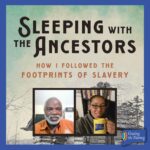 175. Sleeping with the Ancestors in Connecticut
175. Sleeping with the Ancestors in Connecticut
Podcast host and historic preservationist Mary Donohue started following a project on Facebook four or five years ago. It was based on a very simple idea-sleeping overnight in historic buildings-but it was also genius. The project was the Slave Dwelling Project. Joseph McGill,Jr., a Black historic preservationist and Civil War reenactor based in South Carolina, had begun this groundbreaking project to sleep overnight in the countless and very underappreciated former slave dwellings that still stand across the country. What has this to do with Connecticut? McGill not only sleeps at residences across the South but the North and West too. In Connecticut, he has slept at buildings owned by the Greenwich Historical Society and in New London at the Hempstead Houses owned by Connecticut Landmarks. At each stop, events and campfires are held to explore with the public the way the history of the enslaved has been told.
When Donohue discovered that Joe had a new book coming out in the summer of 2023, she immediately pre-ordered it and read it the week she received it. Sleeping with the Ancestors How I Followed the Footprints of Slavery authored by Joseph McGill, Jr. and journalist Herb Frazier was published by Hachette Books.
In this episode, Donohue interviews author Joe McGill, Jr. and Nicole Thomas. Thomas was born and raised in New London. She gained in interest in local history 20 years ago after her mother purchased a historic home.
Nicole works for Connecticut Landmarks as the Assistant Site Administrator at the Hempsted Houses Museum and is also a researcher for New London’s Black Heritage Trail. The New London Black Heritage Trail was honored as a History Gamechanger Project by Connecticut Explored in 2022.
Thanks to our guests author and historic preservationist Joe McGill, Jr. and historian and site manager Nicole Thomas.
To find out more about the Slave Dwelling Project, go to their website at slavedwellingproject.org and follow Joe on Facebook on the Slave Dwelling Project page. His book is available on Amazon.
To find out more about upcoming events at the Hempsted Houses go to ctlandmarks.org and follow them on Facebook at The Hempsted Houses. I highly recommend booking a tour with Nicole to experience the place where this history happened.
To read more about enslaved man Adam Jackson at the Hempsted Houses, click here: https://www.ctexplored.org/adam-jacksons-story-revealed/
For more information on the Greenwich Historical Society’s recreation of an enslaved person’s sleeping area, visited by McGill in 2012, read more here:
https://www.ctexplored.org/slave-quarters-in-bush-holley-house/
And for more articles that explore the long arc of Black history in Connecticut, find out more here:
https://www.ctexplored.org/african-american-history-in-connecticut-2/
https://www.ctexplored.org/slavery-in-connecticut/
This episode of Grating the Nutmeg was produced by Mary Donohue and engineered by Patrick O’Sullivan at https://www.highwattagemedia.com/
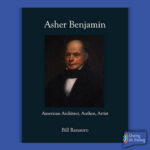 174. Asher Benjamin, Connecticut’s Early Builder and Architect 1773-1845
174. Asher Benjamin, Connecticut’s Early Builder and Architect 1773-1845
From the rural backwater of Hartland, Connecticut in 1773, Asher Benjamin rose to become one of the most important figures of early American architecture. In this episode, architectural historian Mary Donohue interviews guests William Ranauro, author of Asher Benjamin, American Architect, Author, Artist, published by Outskirts Press in 2021 and Lynn Mervosh, Site Administrator for the Phelps-Hatheway House and Garden in Suffield, Connecticut. Mr. Ranauro is one of the speakers for the upcoming Asher Benjamin Symposium.
Today’s episode is inspired by an upcoming symposium sponsored by Connecticut Landmarks to celebrate the work and legacy of Asher Benjamin, one of the most influential members of the first generation of American architects. Take in a full day of learning and gorgeous Fall foliage at the site of his first formal architectural commission, the Phelps-Hatheway House & Garden in Suffield, Connecticut. The symposium is on October 7th, 2023-to find out more and to register go to ctlandmarks.org
Thank to guests William Ranauro and Lynn Merosh. To find out more about upcoming events at the Phelps-Hatheway House and Garden, go to ctlandmarks.org. And don’t forget to register today for the upcoming Asher Benjamin Symposium at ctlandmarks.org. William Ranauro’s book Asher Benjamin American Architect, Author, Artist is available on Amazon.com
This episode of Grating the Nutmeg was produced by Mary Donohue and engineered by Patrick O’Sullivan at https://www.highwattagemedia.com/
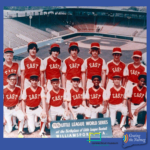 173. Baseball Runs in the Springer Family
173. Baseball Runs in the Springer Family
This fall the Connecticut Museum is hosting the Smithsonian traveling exhibition ¡Pleibol! In the Barrios and the Big Leagues / En los barrios y las grandes ligas. It explores the historic role that baseball has played as a social and cultural force within Latino communities across the world, and how Latinos in particular have influenced and changed the game.
This episode of Grating the Nutmeg was produced by Natalie Belanger and engineered by Patrick O’Sullivan at https://www.highwattagemedia.com/
You can learn more about the Springer family and the Pleibol exhibition at connecticutmuseum.org. The exhibition is open through November 5, 2023. =
image: 1976 Forestville Little League World Series team, George Springer Jr. pictured, courtesy of the Bristol Sports Hall of Fame.
 172. Connecticut Lighthouses: Lifesaving Beacons Along the Shore
172. Connecticut Lighthouses: Lifesaving Beacons Along the Shore
In this episode, Executive Producer Mary Donohue interviews guests Susan Tamulevich, Executive Director of the New London Maritime Society since 2008, during which time the NLMS became the steward of three area lighthouses, and Jordan Jackson, a Grating the Nutmeg listener and lighthouse fan who shares her first-hand account of visiting the Sheffield Island Lighthouse in Norwalk Harbor administered by the Norwalk Seaport Association. The photos below were taken by Jordan.
- The view from the ferry to Sheffield Island
- Landing at Sheffield Island
- Jordan Jackson on Sheffield Island, 2023
In any gift shop in New England, you’ll probably find lighthouses pictured on tea towels and tee shirts and in snow globes. Lighthouses are fondly thought of as community landmarks and icons. Connecticut has fourteen active lighthouses, two of which are maintained as private aids to navigation; six are standing but inactive.
There are many ways to visit Connecticut’s lighthouses. In the summer, the New London Maritime Society takes visitors by boat to see both the interior and exterior of its two lighthouses located in the Long Island Sound. The Norwalk Seaport Association also schedules summer boat trips out to Sheffield Island. The Cross Sound Ferry from New London has a cruise that includes sailing by eight lighthouses available until October 9th. Lighthouse Point Park in New Haven is open until November 1st-a perfect place for a close look at an early lighthouse, a walk on the beach or a sandwich.
For more information, visit these websites: https://www.nlmaritimesociety.org/ and https://www.seaport.org/
New London photo courtesy of New London Maritime Society and Sheffield Island Lighthouse photos courtesy of Jordan Jackson.
This episode of Grating the Nutmeg was produced by Mary Donohue and engineered by Patrick O’Sullivan at https://www.highwattagemedia.com/
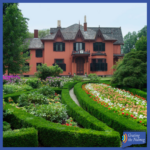 171. Connecticut’s Very Pink House-Roseland Cottage
171. Connecticut’s Very Pink House-Roseland Cottage
It’s the summer of Barbie. Barbiecore, an homage to the stylish doll, is everywhere in fashion and home furnishings. It’s time to think pink!
So this episode is on Connecticut’s own Victorian Barbie Dream House – Roseland Cottage in Woodstock. How many shades of pink has Roseland Cottage been? We’ll find out! Executive Producer Mary Donohue talks to Laurie Masciandaro, site manager of Roseland Cottage museum owned by Historic New England.
Laurie holds a Masters Degree in American History from the University of Connecticut and is a frequent speaker on Connecticut’s historic gardens. Read more in this Connecticut Explored article written by Laurie at https://www.ctexplored.org/sample-article-a-presidential-july-4th/
To find out more about upcoming events at Roseland Cottage go to roselandcottage.org
This episode of Grating the Nutmeg was produced by Mary Donohue and engineered by Patrick O’Sullivan at https://www.highwattagemedia.com/
170. Connecticut Senator George McLean Protects America’s Wild Birds
Connecticut Senator George P. McLean’s crowning achievement was overseeing passage of one of the country’s first and most important wildlife conservation laws, the Migratory Bird Treaty Act of 1918. The MBTA, which is still in effect today, has saved billions of birds from senseless killing and likely prevented the extinction of entire bird species.
In this episode, Executive Producer Mary Donohue interviews Will McLean Greeley, author of A Connecticut Yankee Goes to Washington, Senator George P. McLean, Birdman of the Senate, published by the Rochester Institute of Technology Press in 2023. It is his first book. The new book puts McLean’s victory for birds in the context of his distinguished forty-five-year career marked by many acts of reform during a time of widespread corruption and political instability. McLean rose from obscurity as a Connecticut farm boy to serve as Governor of Connecticut and as a senator from Connecticut in Congress where he advised five US presidents and helped lead change and shape events as a US senator from 1911 to 1929.
Senator George P. McLean established the McLean Game Refuge in 1932 as a life sanctuary to preserve over 3,000 acres of meadows and forests he feared would be lost to development and resource exploitation. Today the wildlands have grown to over 4,400 acres, and protect hundreds of animal species. For more information, go to https://mcleancare.org/game-refuge/
To contact the author or to schedule a book talk, please go to: https://willgreeley.com
To purchase your copy of A Connecticut Yankee Goes to Washington, Senator George P. McLean, Birdman of the Senate, please go to the independent bookstores shown below:
- RJ Julia (all locations)
- Breakwater Books, Guilford, CT
- Books on the Common, Ridgefield, CT
- Byrd’s Books, Bethel, CT
To order online go to the RIT Press website: https://press.rit.edu/search-results-grid/?keyword=Mclean.
This episode of Grating the Nutmeg was produced by Mary Donohue and engineered by Patrick O’Sullivan at www.highwattagemedia.com/
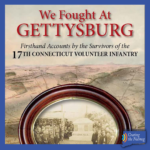 169. Connecticut’s 17th Regiment Volunteer Infantry at the Battle of Gettysburg
169. Connecticut’s 17th Regiment Volunteer Infantry at the Battle of Gettysburg
This episode was recorded on July 5th, 2023 just two days after the 160th anniversary of the Battle of Gettysburg-the turning point of the American Civil War. With more than 50,000 estimated casualties, the three-day engagement was the bloodiest single battle of the conflict. It’s been said that there are over 5,000 books written about the three-day battle-what more can be uncovered? GTN Executive producer Mary Donohue interviews Bridgeport historian Carolyn Ivanoff, author of We Fought at Gettysburg, Firsthand Accounts by the Survivors of the 17th Connecticut Volunteer Infantry, published in 2023 by Gettysburg Publishing. We Fought at Gettysburg follows the 17th Regiment through the Gettysburg Campaign and beyond in June and July of 1863. The book contains first-hand accounts of men who lived through the trauma of combat and survived to write about it. They describe what they saw, thought and felt on the battlefield.
For more information contact author Carolyn Ivanoff, P.O. Box 3294, Gettysburg, PA 17325
PH: (203) 735-8739, website: https://sites.google.com/site/carolynivanoff/
To order your copy of We Fought at Gettysburg, please go to gettysburgpublishing.com
This episode of Grating the Nutmeg was produced by Mary Donohue and engineered by Patrick O’Sullivan at https://www.highwattagemedia.com/
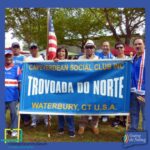 168. Connecticut’s Cape Verdean Community
168. Connecticut’s Cape Verdean Community
In this episode of Grating the Nutmeg, Natalie Belanger of the Connecticut Museum of History and Culture chats with some members of Connecticut’s Cape Verdean community to learn about the culture’s deep roots in the state. Roberta Vincent has been a passionate advocate for the Cape Verdean community in her home town of Norwich, Connecticut for decades. Educator Koren Paul grew up in Stratford and is President of the Cape Verdean Women’s Club of Bridgeport. Both women describe the origins of the community in New England and to talk about their personal experiences maintaining their cultural heritage. The conversation also includes Lynne Williamson, the mutual friend who introduced Belenger to Roberta and Koren. Williamson is the former director of the Connecticut Cultural Heritage and Arts Program, the state’s official folk and traditional arts initiative. CCHAP merged with the Connecticut Museum in 2015.
This episode of Grating the Nutmeg was produced by Natalie Belanger and engineered by Patrick O’Sullivan at https://www.
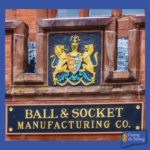 167. New Lives for Old Factories: Cheshire’s Ball & Socket Arts
167. New Lives for Old Factories: Cheshire’s Ball & Socket Arts
What’s being done to save the state’s industrial history? In today’s episode, Producer Mary Donohue talks to Renee Tribert, Preservation Services Coordinator for adaptive reuse and redevelopment for industrial buildings at Preservation Connecticut. Podcast audio engineer Patrick O’Sullivan and Donohue share some of their favorite places to go around the state where you can see old mills and factories that are being used for fun new uses and we hear from Ilona Somogyi, co-founder of Ball & Socket Arts in Cheshire, Connecticut about an old mill with a Cinderella story that will open this summer.
Connecticut was at the forefront of the Industrial Revolution in the United States. Small brooks and rivers were dammed to create waterpower that turned machinery and the state’s textile, precision manufacturing and metal casting industries were born. Thousands of products were produced and the state attracted investors, inventors and immigrants to work in the factories. But as industry moved out in the last half of the 20th century, these cathedrals of industry become vacant and abandoned across the state.
For more information about organizations and museums mentioned in this episode, go to:
Preservation Connecticut https://preservationct.org/
Mills https://preservationct.org/mills
This episode of Grating the Nutmeg was produced by Mary Donohue and engineered by Patrick O’Sullivan at https://www.highwattagemedia.com/
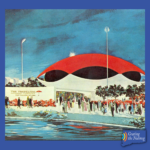 166. Connecticut at the 1964 New York World’s Fair
166. Connecticut at the 1964 New York World’s Fair
It’s almost summertime and kids everywhere are already dreaming about their summer vacation. In 1964, Jimmy O’Sullivan of Cheshire, Connecticut had his heart set on a family outing from Connecticut to the see the World’s Fair in New York City’s Flushing Meadows Park with its futuristic, space-themed exhibits and “Peace Through Understanding” overarching theme. A short drive down Connecticut’s Merritt Parkway and over to Flushing Meadow Park put the O’Sullivan family squarely into the heart of the fair. O’Sullivan still has a photograph of himself at 9 years old in front of the fairs’ Unisphere, a 12-story-high stainless steel globe. The 1964-65 New York World’s Fair attracted approximately 50 million visitors including many from Connecticut during its two April-to-October seasons.
The guest for this episode is Dr. Jason Scappaticci, historian and Associate Dean of Student Affairs at Capital Community College in Hartford. Not only does Dr. Scappaticci have a keen interest in all things World’s Fair but he is an avid collector of souvenirs and mementos from the fair.
This episode of Grating the Nutmeg was produced by Mary Donohue and engineered by Patrick O’Sullivan at https://www.highwattagemedia.com/
Traveler’s Insurance Pavilion postcard image courtesy of the Connecticut Historical Society.
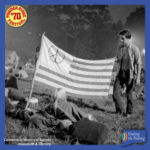 165. Connecticut’s Would-Be Woodstock: The Powder Ridge Festival
165. Connecticut’s Would-Be Woodstock: The Powder Ridge Festival
In this episode of Grating the Nutmeg, Natalie Belanger of the Connecticut Historical Society takes you back to the greatest rock concert that never happened.
In 1970, a planned 3-day rock concert at Powder Ridge in Middlefield was cancelled after an injunction by the town. But tens of thousands of young people showed up anyway and proceeded to have one hell of a party. Belanger speaks with filmmaker Gorman Bechard, who’s working on a documentary about Powder Ridge. Gorman peels back the many layers of this story, including a shady promoter, the town’s grudge against a property owner, and the one famous musician who braved the police to show up and perform — with an amp hooked up to a Mister Softee truck.
Click here to watch a trailer for the film and support its completion!
Thanks to Gorman Bechard and What Were We Thinking Films. If you haven’t seen their 2019 film about New Haven pizza — sorry, that’s ‘apizza’ — check out “Pizza A Love Story.”
This episode was produced by Natalie Belanger of the Connecticut Historical Society and engineered by Patrick O’Sullivan of https://www.highwattagemedia.com/
 164. Philip Johnson’s Glass House
164. Philip Johnson’s Glass House
“Lifestyle site Thrillist set out to find the most beautiful building in each state and Philip Johnson’s New Canaan Glass House got the nod for Connecticut,” reported CT Insider. The Glass House, internationally famous for its design is also a landmark in the history of historic preservation and the history of the LGBTQ community. To celebrate May as historic preservation month and June as LGBTQ Pride month, here’s the story of its owner and designer Philip Johnson and his Glass House in New Canaan, Connecticut.
https://www.ctinsider.com/living/article/Glass-House-named-most-beautiful-building-in-6777524.php
Our guest for today’s episode is Gwen North Reiss, who has conducted many interviews for the Glass House oral history project and worked for several years as an Educator, conducting tours of the 49-acre National Trust for Historic Preservation site. Her article for CT Explored—”Philip Johnson’s 50-year Experiment in Architecture and Landscape”—was published in the winter of 2020. She has written many articles on modern architecture in New Canaan especially during the early 2000s when New Canaan’s experimental modern houses were being demolished.
Read her story here: https://www.ctexplored.org/philip-johnsons-50-year-experiment-in-architecture-and-landscape/
Read more about Philip Johnson here: https://www.ctexplored.org/philip-johnson-in-his-own-words/
To learn more about the Glass House and to book a tour, go to theglasshouse.org
Photo Credit: Michael Biondo
This episode of Grating the Nutmeg was produced by Mary Donohue and engineered by Patrick O’Sullivan at www.highwattagemedia.com/
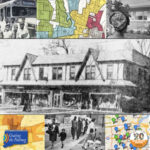 163. How Connecticut Got Zoning (CTE Game Changer Series)
163. How Connecticut Got Zoning (CTE Game Changer Series)
You may have heard the phrase “it’s not zoned for that” as in “Can I build a factory next to my house?” or “Can I put a trailer park in my north forty?” But we may not understand the difference between the town’s master plan, land use requirements and zoning regulations. So let’s break that down. The State of Connecticut mandates that every ten years each community adopt its master plan as a blueprint for aspirations for growth, preservation, and sustainability. The master plan details in broad terms how land can be used-land use-for housing, retail, transportation, education and recreation. It also identifies environmentally sensitive areas like wetlands that should not be built on as well as historically significant areas like historic districts whose architectural character should be safeguarded. But it’s the town’s zoning regulations that pinpoint exacting what can be constructed and where.
But zoning also has a dark side. What is “exclusionary zoning”?
In this episode, Dr. Jack Dougherty, Professor and Director of the Educational Studies Program at Trinity College, is going to uncover the story of how Connecticut passed legislation that allowed zoning in the 1920’s and how West Hartford became the first town to adopt zoning regulations. He and his students use tools from digital history, data visualization, and web writing to explore the relationship between cities, suburbs, and schools in metropolitan Hartford, Connecticut. Read more about this in his feature article in the Spring 2023 issue of Connecticut Explored magazine https://www.ctexplored.org/game-changer-the-rise-of-exclusionary-zoning-in-connecticut/
And read his feature article about redlining in this Connecticut Explored article here https://www.ctexplored.org/the-federal-government-and-redlining-in-connecticut/
This episode of Grating the Nutmeg was produced by Mary Donohue and engineered by Patrick O’Sullivan at highwattagemedia.com Donohue may be reached at marydonohue@comcast.net
Listen to his Grating the Nutmeg episode on redlining here https://gratingthenutmeg.libsyn.com/43-the-challenge-of-fair-housing-in-cts-suburbs
Dougherty is a Connecticut Explored 20 x 20 Innovation in Connecticut History Honoree for his work in On The Line: How Schooling, Housing, and Civil Rights Shaped Hartford and its Suburbs a digital-first, open-access book-in-progress. It is available online at https://ontheline.trincoll.edu/
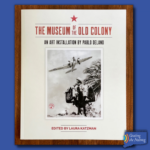 162. Picturing Puerto Rico in Conceptual Art: The Museum of the Old Colony by Pablo Delano (CTE Game Changer Series)
162. Picturing Puerto Rico in Conceptual Art: The Museum of the Old Colony by Pablo Delano (CTE Game Changer Series)
Connecticut and Puerto Rico have strong ties. The guest for this episode is Pablo Delano, a visual artist, photographer, and educator recognized for his use of Connecticut and Puerto Rican history in his work, including his 2020 book of photography Hartford Seen published by Wesleyan University Press, a Connecticut Book Award 2021 “Spirit of Connecticut” finalist. Born and raised in Puerto Rico, he is the Charles A. Dana Professor of Fine Arts at Trinity College in Hartford. His work has been shown in solo exhibitions in museums and galleries in the U.S., Europe, Latin America, and the Caribbean.
Over the course of 20 years Delano amassed a substantial archive of artifacts related to a century of Puerto Rican history. Using this material, including three-dimensional objects, newspaper clippings, and photographs, he created The Museum of the Old Colony, a dynamic, site-specific art installation that examines the complex and fraught history of U.S. colonialism, paternalism, and exploitation in Puerto Rico. The title is a play on words, referencing both the island’s political status and Old Colony, a popular local soft drink. The work is also deeply personal, a means for Delano to better understand and come to terms with the troubling history of Puerto Rico. Pablo was chosen by Connecticut Explored as a Connecticut History Game Changer Honoree in celebration of the magazine’s 20th anniversary in 2022-23. Professor Delano has been featured on Grating the Nutmeg in episode 123 discussing his book of photographs Hartford Seen and in episode 152 Hartford and Puerto Rico: A Conversation between Delano and Puerto Rican historian Elena Rosario. He has an article in the Spring 2023 issue of Connecticut Explored – read here: www.ctexplored.org/game-changer-topsy-in-the-tropics/
While we might not be able to travel to see the exhibition in person, the University of Virginia Press has published a beautiful full-color catalog that includes a collection of very insightful essays edited by Laura Katzman as well as photos of the exhibition. It’s available for purchase on Amazon-The Museum of the Old Colony, An Art Installation by Pablo Delano, 2023.
For more about Delano’s work, go to his website at http://museumoftheoldcolony.org/about/curatorial/To see his photo essay on Hartford’s Puerto Rican streetscapes- https://www.ctexplored.org/visually-breathtaking-hartford-explored/
This episode of Grating the Nutmeg was produced by Mary Donohue and engineered by Patrick O’Sullivan at www.highwattagemedia.com/ Donohue may be reached at marydonohue@comcast.net
161. Carbonated Connecticut
In this episode of GTN, Natalie Belanger and Elena Peters of the Connecticut Historical Society take a look at the beginnings of our national obsession with soft drinks. Here in Connecticut, people have been drinking carbonated drinks for a long time, maybe longer than you’d expect. Today, the soda industry is dominated by just a couple of corporations, but a hundred years ago, Connecticut was home to an astonishing number of soda bottlers. Listen to their conversation to learn about the origins of the soda craze, its relation to Prohibition, and the stories of the oldest surviving Connecticut bottlers. You’ll also hear about some really weird flavor combinations you could once order at Connecticut’s soda fountains, such as the Hot Beef Egg, which is exactly what it sounds like. This episode is best enjoyed with the soda of your choice!
Read more about Connecticut’s soda companies here:
Want to have a soda at one of Connecticut’s vintage food shacks? Read more here:
https://www.ctexplored.org/shack-attack/
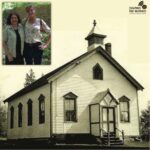 160. Saving Jewish Farming History in Chesterfield
160. Saving Jewish Farming History in Chesterfield
Masses of Eastern European Jews began immigrating to the United States in the 1880s. Between 1881 and 1924, more than two and a half million Jews arrived in America. Many settled in large cities such as New York. But some were aided in becoming farmers and land- owners by the philanthropy of the Baron de Hirsch, a wealthy German Jew who amassed a fortune in building railroads. Funded by de Hirsch, the American Jewish Agricultural Society helped Jews to buy farmland, provided money for synagogues, published a Yiddish farm magazine and had Jewish farm agents. In Connecticut, an early Jewish farm community was established in Chesterfield in the town of Montville northwest of New London. In this episode, we hear more about how this early Jewish community’s history was saved by a group of descendants and how the site of the group’s first synagogue and creamery was preserved as an archeological site.
Author and historian Mary Donohue interviews Nancy Savin, the 2022 winner of Preservation Connecticut’s Harlan H. Griswold Award presented by Preservation Connecticut and the Connecticut State Historic Preservation Office. Harlan Griswold once said, “To me, preservation is more about my grandchildren than about my grandparents.” Her award citation reads “Through her selfless preservation efforts, both small and large, Nancy Savin is helping to build a better future for our children and grandchildren.”
A college graduate in voice and music history, Nancy spent 17 years at Connecticut Public as award-wining producer/host of arts and culture programming. But she is also the great-great granddaughter of Hirsch Kaplan, an Eastern European immigrant who arrived in New York City in 1887. So how did he end up in tiny Chesterfield as a Jewish farmer? And what was the New England Hebrew Farmers of the Emanuel Society? We’ll find in this episode.
Visit the website of the New England Hebrew Farmers of the Emanual Society here: https://www.newenglandhebrewfarmers.org/
Read more about the New England Hebrew Farmers in Nancy’s article in Connecticut Explored’s Winter 2022 issue here: https://www.ctexplored.org/the-new-england-hebrew-farmers-of-the-emanuel-society/
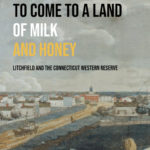 159. Stories from Connecticut’s Western Reserve in Ohio
159. Stories from Connecticut’s Western Reserve in Ohio
Why did the State of Connecticut feel entitled to part of Ohio? Where was Connecticut’s Western Reserve and how was it settled? The Litchfield Historical Society is opening a new exhibition on Connecticut’s Western Reserve on April 22, 2023 entitled “Come to a Land of Milk and Honey.”
In this episode, author and historian Mary Donohue interviews Alex Dubois and Linda Hocking from the Litchfield Historical Society about what they’ve found out about the peoples of the Western Reserve.
Alex Dubois is the Curator of Collections. At the Society, Alex oversees the development and care of the institution’s collection of material culture and art, and serves as project lead for the Society’s exhibitions.
Linda Hocking has served as the Curator of Library & Archives since 2002 where she oversees all aspects of acquisitions, description, and access to the Society’s library and archives.
Read more from Connecticut Explored here:
https://www.ctexplored.org/west-of-eden-ohio-land-speculation-benefits-connecticut-public-schools/
https://www.ctexplored.org/whats-connecticuts-role-in-westward-expansion-2/
Visit the Litchfield Historical Society website for more information on the exhibition and programs:
https://www.litchfieldhistoricalsociety.orgThis episode of Grating the Nutmeg was produced by Mary Donohue and engineered by Patrick O’Sullivan of High Wattage Media at www.highwattagemedia.com/
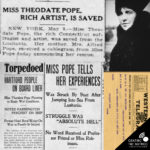 158. Theodate Pope Survives the Sinking of the Lusitania
158. Theodate Pope Survives the Sinking of the Lusitania
Theodate Pope, the architect and owner of what is now the Hill-Stead Museum in Farmington, Connecticut, was a passenger on the Lusitania. Why did she sail on a British ship when Britain was at war? The ship was hit by a German submarine torpedo and sank within an hour. Why wasn’t Pope in a lifeboat? Why did she jump from the ship into the water? And how did Pope survive and what were the after effects? In this episode, author and historian Mary Donohue interviews Melanie Bourbeau, Senior Curator at the Hill-Stead Museum.
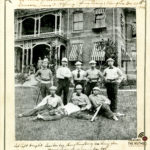 157. Journeys: Boys of the Chinese Educational Mission
157. Journeys: Boys of the Chinese Educational Mission
Journeys 旅途: Boys of the Chinese Educational Mission is on view at the Connecticut Historical Society (CHS) through July 2023. This exhibition honors the 150th anniversary of the Chinese Educational Mission (CEM), a cultural and educational exchange program from 1872 – 1881. Headquartered in Hartford, the CEM enabled 120 Chinese boys, most of whom were barely teenagers, to study in New England with the goal of modernizing China by educating its future leaders abroad. It is a story of hopes, dreams, sacrifice, and the life-changing experience of international exchange.
In this episode of Grating the Nutmeg, Museum Educator Natalie Belanger talks to Karen Li Miller and Henry Qu about their work on Journeys. The CEM collection at the CHS was a well-known resource, but contained Chinese-language materials that had never been translated….until Henry Qu, himself an international student, made an unexpected stop at CHS on his way from New Jersey to Massachusetts. Three years later, Henry’s detour resulted in a fresh telling of the Mission’s story, using the boys’ newly-translated first-person accounts of their experience in Connecticut. What was it like to be uprooted as a teenager to live in a place that your language didn’t even have a word for? What did these teens in the 1870s have in common with teenagers today? And what motivated Henry Qu to make that serendipitous stop at CHS? Listen to find out!
The Exhibition Journeys: Boys of the Chinese Educational Mission will be on view at the Connecticut Historical Society through July, or you can take a 3D tour online at chs.org. Keep an eye on upcoming programming related to this topic at the CHS in spring of 2023!
Read more about the CEM in Connecticut Explored magazine here:
https://www.ctexplored.org/chinese-exchange-students-in-1880s-connecticut/
https://www.ctexplored.org/wong-kai-kah-comes-of-age-in-connecticut/
Fresh episodes of Grating the Nutmeg are brought to you every two weeks with support from our listeners. We’ve just launched our Facebook and Instagram pages-please follow us on social media to get the scoop on new episodes, behind the scenes photos and information on upcoming programs. https://www.facebook.com/GratingTheNutmegPod
This episode of Grating the Nutmeg was produced by Natalie Belanger, Museum Educator at the Connecticut Historical Society and engineered by Patrick O’Sullivan of High Wattage Media at https://www.highwattagemedia.com/
 156. The Legendary Toad’s Place Nightclub in New Haven
156. The Legendary Toad’s Place Nightclub in New Haven
Wall-to-wall posters, sticky floors, a small stage and the stale-beer smell give Toad’s Place its enduring character as a live-music shrine. Authenticity can’t be faked. Opened as a restaurant in 1975, Toad’s has welcomed hundreds of musical acts from the pioneers of the Blues like B.B. King, to today’s megastars Drake and Cardi B. But what does it take to run a nightclub? And have it be successful for almost half a century?
Author and historian Mary Donohue interviews Randall Beach, co-author with Toad’s Place owner Brian Phelps, of the new book The Legendary Toad’s Place, Stories from New Haven’s Famed Music Venue, published in 2021 by Globe Pequot Press. Beach was the rock music critic for the New Haven Register from 1978 to 1984, covering many shows at Toad’s Place. He later wrote about rock music for the New Haven Advocate, the Hartford Courant, and Billboard magazine. He currently writes a column for Connecticut magazine.
Read more about Toad’s Place in the photo essay published in Connecticut Explored at https://www.ctexplored.org/what-these-walls-have-heard-a-photo-essay-on-new-havens-legendary-toads-place/
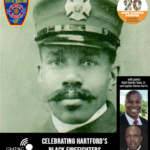 155. Celebrating Hartford’s Black Firefighters (CTE Game Changers Series)
155. Celebrating Hartford’s Black Firefighters (CTE Game Changers Series)
When was the color line broken in the Hartford Fire Department? And how did a high school dropout and a Vietnam vet both become distinguished firefighters in the Hartford Fire Department? Hear their inspiring first-hand stories of growing up in Hartford’s African American community in the North End in and dive into the detective work done to uncover the story of William Henry Jacklyn, Hartford’s first Black firefighter.
Both of the guests in this episode, Chief Charles Teale, Sr. and Captain Steven Harris were honored as Connecticut History Game Changers by Connecticut Explored magazine and both are passionate avocational historians. Chief Teale served as a member of the Hartford Fire Dept. from 1982-2010, retiring as chief. Always interested in Hartford’s history even as a teenager, Chief Teale researched and documented the many outstanding accomplishments of the Hartford Fire Dept to the fire service profession throughout its 221-year history. This included uncovering the William Henry Jacklyn story. Captain Steven Harris began his career as a fire fighter in 1970, retiring in 1997 as a captain in the department and was voted Firefighter of the Year in Connecticut. In 2021, the Hartford Public Library partnered with Captain Harris to create a mural honoring Jacklyn on the Phoenix Society building at 729 Windsor St. in Hartford. The mural was painted by artists Lindaluz Carrillo and Kayla Farrell with an intergenerational group of community members.
Connecticut Explored magazine is celebrating its 20th anniversary and our Grating the Nutmeg podcast its 7th anniversary. Neither of these milestones could have been reached without your support! Please make a gift to our new Fund for Excellence in Publishing at https://www.ctexplored.org/subscribe/friends-of-connecticut-explored/
We need to ask our listeners for your help! This podcast is part of our “20 for 20: Innovation in Connecticut History” series, and we’d like your feedback. Take our 5-minute survey and get a free copy of Connecticut Explored magazine. Thank you! https://www.surveymonkey.com/r/HARTEA12
This episode of Grating the Nutmeg was produced by Mary Donohue and engineered by Patrick O’Sullivan of High Wattage Media at https://www.highwattagemedia.com/
Donohue has documented the built environment and pop culture for over 30 years. Contact her at marydonohue@comcast.net
 154. Numbers to Names: Restoring Humanity to CT Valley Hospital Cemetery
154. Numbers to Names: Restoring Humanity to CT Valley Hospital Cemetery
Connecticut Explored magazine is celebrating its 20th anniversary and our Grating the Nutmeg podcast it’s 7thanniversary. Neither of these milestones could have been reached without your support! Please make a gift to our new Fund for Excellence in Publishing at https://www.ctexplored.org/subscribe/friends-of-connecticut-explored/
For over a century, almost 1700 people buried in the cemetery at the Connecticut Valley Hospital were identified with gravestones bearing only a number instead of a name. In the 1990s, names of the deceased were restored to the site. In this episode of Grating the Nutmeg, Natalie Belanger of the Connecticut Historical Society (https://chs.org/) is taking a look at a digital history project that will help expand our understanding of the lives of the people buried in that cemetery and of mental health care in Connecticut’s past. Kaitlyn Oberndorfer, CREC history teacher and graduate student, has undertaken a project that will link genealogical and demographic information to the names in the cemetery, restoring some of the residents’ lost humanity.
Look for Kaitlyn’s finished project to go live online sometime in 2023. For a detailed history of the Connecticut Valley Hospital Cemetery, you can read the application that placed the site on the National Register of Historic Places.
This episode of Grating the Nutmeg was produced by Natalie Belanger, Adult Programs Manager at the Connecticut Historical Society and engineered by Patrick O’Sullivan of High Wattage Media at https://www.highwattagemedia.com/
You can click here to learn about the “Uncovering Their History” project that inspired “Numbers to Names.” Read more here: https://www.ctexplored.org/unburying-hartfords-native-and-african-family-histories/
And listen to our podcast episode here: https://gratingthenutmeg.libsyn.com/78-uncovering-african-and-native-american-lives-in-17th-18th-century-hartford
For more about the treatment of Civil War soldiers at the Connecticut Valley Hospital, read more here:https://www.ctexplored.org/civil-war-soldiers-heart/
And for more about the treatment of mental illness in Connecticut, read more here: https://www.ctexplored.org/treating-the-mind-in-times-past/
Join Connecticut Explored’s 20th anniversary celebration by subscribing at ctexplored.org
New subscribers can get 6 issues for the price of 4 with our Holiday sale before 12/31/2022 with the code HOL22.
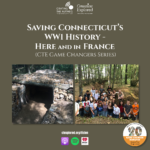 153. Saving Connecticut’s World War 1 History-Here and in France (CTE Game Changers Series)
153. Saving Connecticut’s World War 1 History-Here and in France (CTE Game Changers Series)
How did 15 Connecticut high school students find themselves in French World War 1 trenches and what were they doing there? Find out in today’s episode! This podcast is part of our “20 for 20: Innovation in Connecticut History” series, and we’d like your feedback. Take our 5-minute survey and get a free copy of Connecticut Explored magazine. You’ll find the survey link below. Thank you!
 https://www.surveymonkey.com/r/CTWW1
https://www.surveymonkey.com/r/CTWW1
This episode of GTN features Christine Pittsley, Special Projects Director for the Connecticut State Library and Katy Hitson, a Connecticut student who participated in the trench restoration in France when she was in high school. Pittsley has directed several award-winning World War 1 programs, including the Digging Into History trench restoration project and the Remembering World War One Digitization program, and has been recognized as a leader in the nation’s WW1 commemorative efforts.
 152. Hartford and Puerto Rico: A Conversation with Elena Rosario and Pablo Delano (CTE Game Changer Series)
152. Hartford and Puerto Rico: A Conversation with Elena Rosario and Pablo Delano (CTE Game Changer Series)
In this episode, recorded at the Park Street Library@the Lyric on Sept. 21, 2022 to a full house, two of our Connecticut History Game Changer Honorees discuss their work. The conversation was hosted by Jasmin Agosto, Community Outreach Coordinator for the Hartford History Center at the Hartford Public Library.
We are asking our listeners for your help! We need your thoughts and ideas about the podcasts that highlight our 20 Connecticut History Game Changers in the field of Connecticut history. This 5-minute survey will help us plan episodes that you want to hear! As a thank you, we will send you a free, introductory copy of our print magazine or if you are already a subscriber, we will add a free issue to your existing subscription. I hope you will share your thoughts on the podcast by going to the Shownotes for this episode and clicking the link here https://www.surveymonkey.com/r/DELROS to take the survey. Thank you!
What can we learn about Hartford’s Puerto Rican community today through art and history?
Photographer and Trinity College Fine Arts professor Pablo Delano and emerging scholar and public historian PhD candidate Elena Rosario explore their work in the context of Hartford’s Puerto Rican history and the broader United States-Puerto Rico relationship.
Thank you to our guests Pablo Delano, Elena Rosario and Jasmin Agosto.For more about Pablo Delano’s work, go to his website at http://museumoftheoldcolony.org/about/curatorial/
And for more about the Hartford History Center at the Hartford Public Library, visit https://hplct.ent.sirsi.net/client/en_US/history/
Connecticut Explored, the nonprofit organization that publishes Connecticut Explored magazine, announced its “20 for 20: Innovation in Connecticut History,” series highlighting 20 “Game Changers” whose work is advancing the study, interpretation, and dissemination of Connecticut history. The initiative, funded by Connecticut Humanities and sponsored by Trinity College, is the centerpiece of Connecticut Explored’s year-long celebration of its 20th anniversary. Subscribe at https://www.ctexplored.org/subscribe/
The episode of Grating the Nutmeg was produced by Mary Donohue and engineered by Patrick O’Sullivan of High Wattage Media www.highwattagemedia.com/
Donohue has documented the built environment and pop culture for over 30 years. Contact her at marydonohue@comcast.net
 151. Little Liberia: The Mary and Eliza Freeman Center (CTE Game Changer Series)
151. Little Liberia: The Mary and Eliza Freeman Center (CTE Game Changer Series)
Connecticut Explored is celebrating its 20th anniversary with “20 for 20: Innovation in Connecticut History,” a series of articles, podcasts, and public programs that highlight 20 “Game Changers” in the field of Connecticut history. The insights and ideas we gather through this five-minute survey will help individuals and organizations who are committed to keeping Connecticut history vibrant and relevant. Thank you for your time!
https://www.surveymonkey.com/r/OCT1FREEMAN
Today’s episode is about Game Changer Honoree the Mary & Eliza Freeman Center for History and Community. The Center is restoring and preserving the historic Mary and Eliza Freeman Houses in Bridgeport’s Little Liberia community, built about 1822 and some of the oldest houses built by African Americans in Connecticut. Mary Donohue, Asst. Publisher Emeritus, interviews guests Maisa Tisdale, President and CEO of the Center and Dr. Sarah Sportman, CT State Archeologist at the University of Connecticut.
To learn more about the Freeman Center, visit their website at https://freemancenterbpt.org/
And to learn more about the Office of the Connecticut State Archeologist, visit the website at https://osa.uconn.edu/
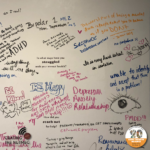 150. Common Struggle, Individual Experience: How Can Museums Talk About Mental Health? (CTE Game Changer Series)
150. Common Struggle, Individual Experience: How Can Museums Talk About Mental Health? (CTE Game Changer Series)
Photo: Courtesy of Tom Schuch
149. New London and the Middle Passage (CTE Game Changer Series)
The Speedwell arrived in New London on July 17, 1761, after a journey of several months from Western Africa to the Americas. The boat departed with 95 enslaved persons. Only 74 survived the journey.
The captain of the Speedwell, Timothy Miller, sailed up the Connecticut River to Middletown after a few days in New London. Although the ship’s records don’t show where the Africans aboard the Speedwell ended up, the probate record of Normand Morison, a Hartford physician who owned 7/16th of the Speedwell, shows 21 enslaved West Africans were placed on his farm in Bolton, CT. Morison died in 1761 and the fate of the people on the Bolton farm is not yet known.
In this episode, Kathy Hermes, Lonnie Braxton, and Tom Schuch discuss Morison and the Speedwell, the Black Heritage Trail and its significance, and the impact of the slave trade on Connecticut and its trading networks.
Connecticut Explored is celebrating its 20th anniversary with “20 for 20: Innovation in Connecticut History,” a series of articles, podcasts, and public programs that highlight 20 “Game Changers” in the field of Connecticut history. The insights and ideas we gather through this five-minute survey will help individuals and organizations who are committed to keeping Connecticut history vibrant and relevant. Thank you for your time! Visit: www.surveymonkey.com/r/PODCAST1
This episode of Grating the Nutmeg was produced by Dr. Kathy Hermes and engineered by Patrick O’Sullivan of High Wattage Media www.highwattagemedia.com/
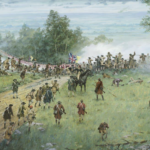 148. Rediscovering the Battle of Ridgefield
148. Rediscovering the Battle of Ridgefield
45 minutes. Release date: August 15, 2022
The discovery of four 18th century male skeletons thought to be possible soldiers in the April 27, 1777 Battle of Ridgefield prompted perhaps the most in-depth research into that crucial Revolutionary War conflict ever undertaken. In this presentation to the town sponsored by the Ridgefield Historical Society earlier this year, state historian Walt Woodward, historian Keith Jones, state archaeologist emeritus Nick Bellantoni, state archaeologist Sarah Sportman, archeologist Kevin McBride, and Historian David Naumec report on their discoveries to date.
Read more!
“Benedict Arnold and the Battle of Ridgefield,” Winter 2017-2018
“Fairfield Set Ablaze,” Spring 2009
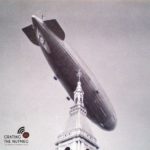 147. The Hindenburg Flies Over Connecticut
147. The Hindenburg Flies Over Connecticut
37 minutes. Release date: Aug. 1, 2022
The airship Hindenburg passed over Connecticut 21 times during its 17-month service between 1936-37. In the 1930s, air travel across the Atlantic Ocean between Europe and North America was in its infancy. The vast airships of the German Zeppelin Company, zeppelins or dirigibles, took an early lead, competing not with airplanes but luxury ocean liners. In this episode, Asst. Publisher Mary Donohue, talks to historian Alexander Rose, author of Empires of the Sky, Zeppelins, Airplanes, and Two Men’s Epic Duel to Rule the World (Random House, 2020). And you’ll hear from Bridgeport historian Carolyn Ivanoff, author of the article “The Hindenburg Flies over Bridgeport” in the Summer 2022 issue of Connecticut Explored. Find out more about why the Nazi swastika is visible in many of the photos taken over Connecticut.
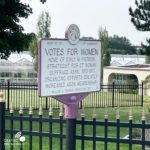 146. Votes (and Markers) for Women!
146. Votes (and Markers) for Women!
37 minutes. Release date: July 15, 2022
Natalie Belanger of the Connecticut Historical Society talks with Joanie DiMartino, Connecticut State Coordinator for the National Votes for Women Trail. They discuss the origin of the trail’s marker program, and the criteria that went into choosing the Connecticut people and places honored with a marker. DiMartino shares her thoughts on why the markers matter, and what the story of the suffrage movement can teach us about social justice movements today. Visit the National Votes for Women Trail for an interactive map of trail sites throughout the United States.
The National Votes for Women Trail marker program is made possible through the William G. Pomeroy Foundation. The Connecticut Historical Society has partnered with the Pomeroy Foundation to feature Connecticut cultural heritage on roadside markers at sites across the state. Learn more
Thanks to Joanie DiMartino for participating! This episode was produced by Natatlie Belanger of the Connecticut Historical Society, and engineered by Patrick O’Sullivan of High Wattage Media, highwattagemedia.com
Read more!
Find all of our stories about the fight for women’s suffrage in Connecticut on our TOPICS page.
145. Activists Paul and Eslanda Robeson in Connecticut
39 minutes. Release date: July 1, 2022
Hear Summer 2022 author and historian Steve Thornton of the Shoeleather History Project talk about the story of the internationally-renown activist, actor, and singer Paul Robeson and his wife Eslanda, an anthropologist, author, and activist in her own right. The Robeson’s home from 1941 to 1953 in Enfield is on the Connecticut Freedom Trail and the National Register of Historic Places.
Read more!
“Site Lines: The Robesons Move to Enfield,” Summer 2022
144. A Visit to the Katharine Hepburn Museum at “The Kate” in Old Saybrook
35 minutes. Release date: June 15, 2022
Join Walt Woodward on a visit to the Katharine Hepburn Museum at the Katharine Hepburn Cultural Arts Center (“The Kate”) in Old Saybrook. His interview with Executive Director Brett Eliott and Director of Community Relations Robin Andreoli about this gem of a museum for America’s most Oscar-winning actor (and long-time Saybrook resident) should convince you to put both the Katharine Hepburn Museum and “the Kate” on your must-see-this-summer list.
Read more!
“Katharine Hepburn, Local Girl,” Spring 2015
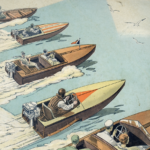 143. The Need for Speed on the Connecticut River
143. The Need for Speed on the Connecticut River
31 minutes. Release date: June 1, 2022
In this episode, CTExplored publisher Elizabeth Normen talks with Connecticut River Museum curator Amy Trout about the museum’s summer exhibition Speed: Hydroplane Racing on the Connecticut River, 1900 – 1940. Trout tells us what a hydroplane is and why racing them became popular in the midst of the Great Depression. As opposed to yachting, she explains, hydroplane racing was an everyman’s sport that people flocked to the riverfront to watch. She talks boat design, which outboard engines were popular, and who the stand-out racers of the 20s and 30s—a number of whom were young women—were. Speed is on view through October 9, 2022.
Read more!
“Pleasure Boating on the Connecticut River,” Summer 2018
“Full Steam Ahead: Steamboat Travel in Connecticut,” Spring 2009
Episode 37. Aboard the First Yacht that Sailed the Connecticut River . . . in 1614
142. The Institute of Living at 200
47 minutes. Release date: May 15, 2022
The Hartford Retreat for the Insane was chartered in 1822 as one of the first mental health centers in the United States, and the first hospital of any kind in Connecticut. In 2022 the CHS is exploring the story of mental health in our state with the special exhibition Common Struggle, Individual Experience. In this talk held at the CHS, Dr. Harold (Hank) Schwartz spoke about the history of the Hartford Retreat, renamed the Institute of Living in the 20th century. His presentation took us through the state of mental health care in the early 1800s, the reasons for the founding of the Hartford Retreat, and its place in the development of modern psychiatry.
“The Institute of Living,” Feb/Mar/Apr 2004
141. Saving the Merritt Parkway
30 minutes. Release date: May 3, 2022
Most people in the tri-state area have driven the Merritt Parkway with its extraordinary bridges and landscaped vistas. But can a roadway built during the Great Depression survive in the 21st century without losing its charm? In celebration of Historic Preservation Month, we learn how the Merritt Parkway, the state’s most heavily visited National Register historic district, was saved from modernization and restored to its original design. In this episode Assistant Publisher Mary Donohue talks with her guests Christopher Wigren and Wes Haynes. Wigren is deputy director of Preservation Connecticut and author of Connecticut Architecture: Stories of 100 Places. He co-wrote the National Register of Historic Places nomination for the parkway and serves on the DOT’s Merritt Parkway Advisory Committee. Wes Haynes is the Executive Director of the Merritt Parkway Conservancy, a non-profit organization committed to the preservation, revitalization, and stewardship of the Parkway.
Read More!
“Preserving the Merritt Parkway,” Spring 2008
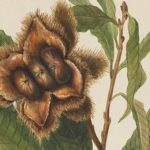 140. New Hope For a Connecticut Champion
140. New Hope For a Connecticut Champion
40 minutes. Release date: April 15, 2022
For more than 2,000 years, the American chestnut was the tallest, largest, and most omnipresent tree in Connecticut. It’s a tree for which a hundred hills, countless streets, and at least one Connecticut town were named, whose nuts we sing about on the holidays, and which was used to build houses, furniture, fences, train tracks, and utility lines. In this episode, Jack Swatt, President of the Connecticut chapter of the American Chestnut Foundation, talks with state historian Walt Woodward about the tree’s long history, its destruction by chestnut blight, and the efforts by scientists to restore this functionally extinct species to its former place in Connecticut’s woodlands.
Read More!
“Trees as Memorials & Witnesses to History,” Spring 2021
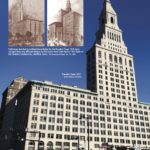
Travelers Tower, Hartford, 2021. photo: Mary M. Donohue. Insets: Donn Barber’s preliminary sketches for Travelers Tower, 1918. Donn Barber, “The Tower of the Travelers’ Insurance Co., Hartford, Conn.” The American Architect, vol. 114, 1918.
139. Architect Donn Barber Designs Hartford’s Early Skyscrapers
30 minutes. Release date: April 1, 2022
Assistant Publisher Mary Donohue, an architectural historian and author of the Spring 2022 issue’s “Hartford Gets its First Skyscrapers,” and podcast engineer Patrick O’Sullivan explore the Hartford work of early 20th century architect Donn Barber, especially his magnificent Connecticut State Library building and two of the city’s early skyscrapers. Donohue’s guest, retired Connecticut State Librarian Ken Wiggin, explains how Barber got the plum commission to design the Connecticut State Library. Barber, a New York City architect, could be called the “Father of Hartford Skyscrapers.” He designed Hartford’s first skyscraper, the Hartford National Bank in 1911, and another, the Travelers Tower in 1919, that reigned as the tallest in New England for decades.
This episode of Grating the Nutmeg was produced by Mary Donohue and engineered by Patrick O’Sullivan, High Wattage Media, LLC.
Read More!
“Connecticut State Library: George Godard Gets His Building,” Fall 2010
“Saving Face: The Hartford Times Building,” Spring 2018
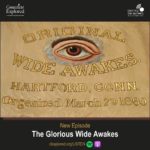 138. The Glorious Wide Awakes
138. The Glorious Wide Awakes
32 minutes. Released March 15, 2022
Spurred by Abraham Lincoln’s campaign stop in Hartford in March 1860, the Wide Awake movement spread from Connecticut throughout the North like wildfire. In this episode, the Connecticut Historical Society’s Natalie Belanger takes a look at this pivotal youth movement of the Civil War era. Listen to find out how this home-grown political movement and their signature torchlit parades helped to redefine American democracy on the eve of the Civil War.
This topic was inspired by “Albert’s Odd Jobs,” an exhibition on view at the CT Historical Society through April 16, 2022. It covers the life of Glastonbury’s Albert Walker, a farmer, skilled artisan, amateur magician, and, of course, a Wide Awake. You can take a virtual 3D tour of “Albert’s Odd Jobs” on the museum’s website, chs.org.
Special thanks to guest Jon Grinspan, the Curator of Political History at the Smithsonian’s National Museum of American History. Grinspan studies the deep history of American democracy, especially the wild partisan campaigns of the 1800s. He frequently contributes to the New York Times, and his work has been featured in The New Yorker, the Washington Post, The Atlantic, and elsewhere. His most recent book is The Age of Acrimony: How American Fought to Fix Their Democracy 1865-1915. This episode of Grating the Nutmeg was produced by Natalie Belanger and engineered by Patrick O’Sullivan.
Read More!
“Albert Walker, A Touch of Magic,” Winter 2007-2008
“Connecticut in the Civil War”
“Glimpses of Lincoln’s Brilliance,” Fall 2005, tells about the Wide Awakes, with several images
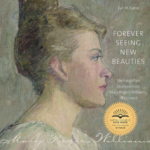 137. An American Woman Artist Abroad — Mary Rogers Williams
137. An American Woman Artist Abroad — Mary Rogers Williams
37 minutes. Released March 1, 2022
March is Women’s History Month and in this episode, publisher Elizabeth Normen talks with author Eve Kahn about her 2019 book, Forever Seeing New Beauties: The Forgotten Impressionist Mary Rogers Wiliams,1857 – 1907 (Wesleyan University Press, 2019). It’s a rare insider view of the challenges women artists faced in the late 19th century. Kahn drew from a collection of Williams’s gossipy letters home in which she describes her desperation to escape her teaching job at Smith College to paint and travel abroad. Hear how Williams talked her way into artist James McNeil Whistler’s London home, and about drawing from a cadaver at the Ecole des Beaux Arts in Paris.
Find out about Eve Kahn’s upcoming author talks at https://www.evekahn.com and read her story in the Winter 2021-2022 issue of CTExplored.
Read More!
“Mary Rogers Williams: “We Shall Want to do a Lot of Rambling,” Winter 2021-2022
“An Art School Forged in the Gilded Age,” Spring 2003
Read all of our stories about Connecticut’s art history on our TOPICS page
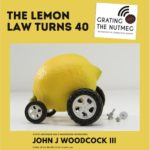 136. The Lemon Law Turns 40
136. The Lemon Law Turns 40
50 minutes. Released February 15, 2022
Forty years ago, John J. Woodcock, III, a freshman legislator in the Connecticut General Assembly, wrote and engineered passage of one of the most important pieces of consumer protection legislation in history—The Lemon Law (actually two laws passed in 1982 and 1984) that required automobile manufacturers to repair defective vehicles in a timely manner, replace the vehicle with a new one, or refund the customer’s purchase price. Today Lemon Laws are in place in every state of the union and countries around the world. Woodcock, father of the Lemon Law, tells the story of the law’s creation, passage, and the years-long battle with car manufacturers to preserve its integrity. Produced by Walter Woodward.
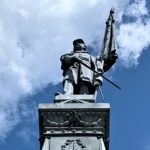 135. Zinc Gravestones – Bridgeport’s Monumental Bronze Company
135. Zinc Gravestones – Bridgeport’s Monumental Bronze Company
24 minutes. Released February 1, 2022
Assistant Publisher Mary Donohue explores the history of an unusual and unique Connecticut company that made highly popular grave markers after the Civil War out of zinc. Affectionately known by cemetery buffs as “Zinkies,” these bluish-grey metal markers were infinitely customizable, affordable, made in Bridgeport, and shipped across the country. The company’s slogan was “As enduring as the pyramids,” but was that true or just boosterism? Find out with author and Bridgeport historian Carolyn Ivanoff whose story about the Monumental Bronze Company comes out in the forthcoming Spring 2022 issue. You can find her Bridgeport history blog at https://bportlibrary.org/hc/business-and-commerce/monuments-everlasting-bridgeports-monumental-bronze-company/#more-14000
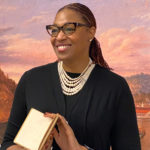 Episode 134. “Another Name for Happiness:” The Life of Ann Plato
Episode 134. “Another Name for Happiness:” The Life of Ann Plato
38 minutes. Released January 15, 2022
In this episode, Connecticut Historical Society’s Natalie Belanger, frequent contributor to Grating the Nutmeg, talks with Antoinette Brim Bell, Professor of English at Capital Community College, about Ann Plato, one of the first Black women to publish a book in the United States. Ann Plato is part of Capitol Community College’s NEH-funded Hartford Heritage Project which highlights the history of the Talcott Street Church, the first Black congregation in Hartford and where Plato was a teacher. Visit the Hartford Heritage Project’s website for more information. Ann Plato’s book, Essay: Including Biographies and Miscellaneous Pieces, in Prose and Poetry, has been digitized by the New York Public Library and is available to read online. This episode was produced by Natalie Belanger and engineered by Patrick O’Sullivan.
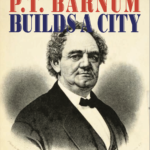
Frontispiece page, “Struggles and Triumphs:
Or Forty Years’ Recollections of P. T. Barnum” (1872 edition).
Episode 133. P.T. Barnum Builds a City
26 minutes. Released January 7, 2022
Is there a sucker born every minute? We don’t have the answer but that saying is attributed to one of Connecticut’s most famous residents, circus showman P. T. Barnum. Barnum made and lost several fortunes, helped to create the American circus, exhibited a phony mermaid cobbled together from a monkey and a fish, and he loved Bridgeport! Mary Donohue, Assistant Publisher of Connecticut Explored, finds out more about Barnum’s over the top life and his lasting mark on Bridgeport with her guest Bruce Hawley, author of “P. T. Barnum Builds a City” in the Winter 2021 issue of Connecticut Explored. Hawley is a board member the Barnum Museum Foundation, the Circus Historical Society, and the Circus Fans Association of America. He is a distant cousin of P.T. Barnum.
The Barnum Museum, originally called The Barnum Institute of Science and History, was just designated a National Historic Landmark by the US Dept of the Interior. Plan your visit at https://barnum-museum.org/.
This episode was produced by Mary Donohue and engineered by Patrick O’Sullivan.
 This episode of Grating the Nutmeg received support from the State Historic Preservation Office of the Dept of Economic and Community Development with funds from the Community Investment Act of the State of Connecticut.
This episode of Grating the Nutmeg received support from the State Historic Preservation Office of the Dept of Economic and Community Development with funds from the Community Investment Act of the State of Connecticut.
Read More!
“Tom Thumb and the Age of Celebrity,” Spring 2015
And see GTN episodes 30 (parts I, II, and III), and 60.
Episode 132. “John Norton’s Vagabond,” A Victorian Christmas Story
69 minutes. Released December 15, 2021
In the spirit of the season, state historian Walt Woodward presents a Victorian-era Christmas story written by the celebrated 19th century author from Guilford Rev. William Henry Harrison Murray. In “John Norton’s Vagabond,” from Murray’s 1897 Holiday Tales: Christmas in the Adirondacks, a rustic woodsmen, the trapper John Norton, who decides, in counsel with his dogs Rover and Sport, to hold a Christmas dinner to which he will invite even vagabonds. In Norton’s trapper’s world the word vagabond meant a person who stole other men’s traps and poached their furs, in short, the worst of the worst.
Special thanks to the Free Music Archive, Creative Commons, and these amazingly talented artists for the use of this wonderful music: Borrtex, “Christmas Memory,” “Christmas Tree,” Poddington Bear, “Angels We Have Heard on High,” Rue Royale, “Snow on Snow.” This episode was produced by Walter Woodward.
More Holiday Episodes!
Episode 85: Connecticut Christmas Stories & Song
Episode 62: Three Centuries of Christmas at the Webb-Deane-Stevens Museum
Episode 21: Holiday Episode 2: A Connecticut Christmas Story
Episode 20: Holiday Episode 1: Soup and Stories
READ MORE:
“Christmas in Connecticut,” Winter 2010/2011
Episode 131. When Contraception Was a Crime: Griswold v. CT
35 minutes. Released December 1, 2021
Natalie Belanger of Connecticut Historical Society is joined by historian Barbara Sicherman, the William R. Kenan Jr. Professor Emerita at Trinity College, to discuss the landmark reproductive rights case, Griswold v. Connecticut. Professor Sicherman talks about the origins of the lawsuit, what it meant for women in our state, and its long-term influence on civil rights rulings.
This episode of Grating the Nutmeg was produced by Natalie Belanger and engineered by Patrick O’Sullivan.
Read more!
“Connecticut Women Fight for Reproductive Rights,” Fall 2017
“Women Who Changed the World,” Summer 2011
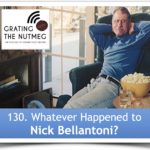 Episode 130. Whatever Happened to Nick Bellantoni?
Episode 130. Whatever Happened to Nick Bellantoni?
55 minutes. Released November 15, 2021
Recently Connecticut State Historian Walt Woodward announced he will be retiring July 1, 2022. To find out what “historical” retirement is like, Woodward sat down with Nick Bellantoni, who retired as state archaeologist in 2014, and is now Connecticut’s state archaeologist emeritus. The resulting conversation was a fascinating discussion of archaeological sites in Connecticut, Nick’s successor state archaeologists, and Nick’s own career of amazing discoveries.
Read more!
“Nick Bellantoni: 30 Years of Great Finds,” Summer 2014
“Sites Underwater Worth Preserving, Too,” Spring 2009
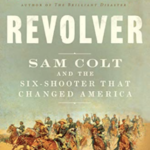 Episode 129. Revolver: Sam Colt and the Six-Shooter That Changed America
Episode 129. Revolver: Sam Colt and the Six-Shooter That Changed America
37 minutes. Released November 1, 2021
What more do we need to know about Sam Colt? In Hartford we have the iconic blue-domed Colt Armory, Colt Park, the Colt addition to the Wadsworth Atheneum, the Church of the Good Shepard, and Colt’s home Armsmear. But it turns out that we may not have known much about Colt’s life before he became fabulously wealthy—he traveled with a novelty act, womanized, drank, smuggled guns to Russia, bribed politicians, and blew up ships in New York Harbor with electricity.
Mary Donohue, Asst. Publisher of Connecticut Explored, digs into these stories with Jim Rasenberger, author of Revolver: Sam Colt and the Six-shooter that Changed America. Rasenbeger is the author of three other books—The Brilliant Disaster, America, 1908, and High Steel—and has contributed to the New York Times, Vanity Fair, Smithsonian, and other publications. Find out more at https://www.jimrasenberger.com/
Coltsville, Sam’s industrial village including the Colt Armory, workers housing, and his estate, have been listed as a National Historic Landmark and authorized as a National Historical Park under the guidance of the National Park Service. For more history and self-guided tours, go to their website at nps.gov/colt.
![]() This episode was produced by Mary Donohue and engineered by Patrick O’Sullivan. This episode received support from the State Historic Preservation Office of the Dept of Economic and Community Development with funds from the Community Investment Act of the State of Connecticut.
This episode was produced by Mary Donohue and engineered by Patrick O’Sullivan. This episode received support from the State Historic Preservation Office of the Dept of Economic and Community Development with funds from the Community Investment Act of the State of Connecticut.
Read more!
“The Suspicious Colt Armory Fire,” Fall 2006
“Sam Colt Mines the Arizona Territory,” Winter 2016/2017
“Making a Success of Coltsville” Winter 2005/2006
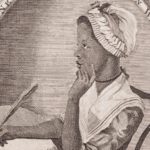 Episode 128. A Connecticut Historian Makes History: Recovering Phyllis Wheatley’s Lost Years
Episode 128. A Connecticut Historian Makes History: Recovering Phyllis Wheatley’s Lost Years
62 minutes. Released October 15, 2021
UCONN legal historian Cornelia Hughes Dayton was searching through Massachusetts court cases from the 1700s, working on a project involving mental disabilities in early America, when she came upon a find that was itself history-making: a cache of cases that illuminate the formerly “missing years” in the life of America’s first published African American author and the mother of the African-American literary tradition Phyllis Wheatley Peters. Dayton discusses with state historian Walt Woodward her discovery of the court cases and their many revelations, as recounted in her just published and prize-winning article “Lost Years Recovered: John Peters and Phillis Wheatley Peters in Middleton,” New England Quarterly 94 (September 2021): 309-351.
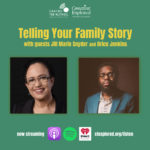 Episode 127. Telling Your Family Story with Jill Marie Snyder and Orice Jenkins
Episode 127. Telling Your Family Story with Jill Marie Snyder and Orice Jenkins
31 minutes. Released October 1, 2021
Are you your family’s historian? If so, this episode is for you! In celebration of National Archives Month, we’re talking to two accomplished family historians.
Mary Donohue, Asst. Publisher of Connecticut Explored, interviews Jill Marie Snyder, author of Dear Mary, Dear Luther, winner of the Afro-American Historical and Genealogical Society Award for Nonfiction Romance/history in 2020. Snyder will be teaching a workshop, “Telling Your Family Story, Putting It All Together,” on Oct 20, 2021 for the Ancient Burying Ground Association and Hartford Public Library. Register for the workshop on the Ancient Burying Ground Association’s Facebook page under events.
Our second guest is well-known Hartford Jazz musician and recording artist Orice Jenkins. He teaches in his hometown of Hartford and tours nationally with the Afro-Semitic Experience. His website features his family history blog Chesta’s Children: a Collection of Stories, People, History, Records and Research.
Read More!
“Family History—Separating Fact from Fiction,” Spring 2019
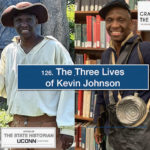 Episode 126. The Three Lives of Kevin Johnson
Episode 126. The Three Lives of Kevin Johnson
51 minutes. Release date: September 15, 2021
History has often been described as the present having a conversation with the past. Meet Kevin Johnson, who makes those conversations both real and personal: as a Technical Assistant in the History and Genealogy unit of the Connecticut State Library in Hartford, as William Webb, a Civil War volunteer in the 29th Connecticut Colored Volunteer Infantry; and as Jordan Freeman, the African American who died a heroe’s death at the Revolutionary War massacre at Fort Griswold. It’s 250 years of history, all through one person: “The Three Lives of Kevin Johnson.” Produced by State Historian Walter W. Woodward.
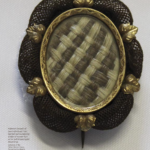
Hairwork brooch of two individuals’ hair (center) surrounded by a tube of woven hair set in leaf-shaped gold mountings.
Collection of the Palmer-Warner House, Connecticut Landmarks
Episode 125. Precious Memories Captured in Hair
21 minutes. Release date: September 1, 2021
Join Mary Donohue, assistant publisher of Connecticut Explored, for a discussion with historian Dr. Helen Sheumaker about Sheumaker’s Fall 2021 issue story about Victorian jewelry and wreaths made from human hair. Dr. Sheumaker is the author of Love Entwined: The Curious History of Human Hair Work. She teaches history and American Studies at Miami University of Ohio. Find out more about this now unfashionable way to remember your loved ones!
This episode was produced by Mary Donohue and engineered by Patrick O’Sullivan. Donohue has documented Connecticut’s built environment and popular culture for over 30 years. Contact her at marydonohue@comcast.net. And our thanks to the Lane Public Library in Oxford, Ohio for providing Dr. Sheumaker with a recording space.
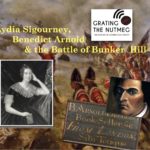 Episode 124. Lydia Sigourney, Benedict Arnold, & The Battle of Bunker Hill
Episode 124. Lydia Sigourney, Benedict Arnold, & The Battle of Bunker Hill
36 minutes. Release date: August 19, 2021
What do the 19th-century author Lydia Sigourney, the 18th-century hero-turned-traitor Benedict Arnold, and the Revolutionary War Battle of Bunker Hill have in common? They all come together in this episode’s story drawn from Sigourney’s 1824 book SKETCH OF CONNECTICUT FORTY YEARS SINCE. Sigourney’s book, written early in her career, is a rare historical treat: a tale by a future-famous writer, written in 1824, reminiscing about life 40 years earlier in 1784. The past remembering the past, in this episode of Grating the Nutmeg.
Episode 123: Connecticut Seen: The Photography of Pablo Delano and Jack Delano
36 minutes. Release date: August 1, 2021
In this episode, join Mary Donohue, assistant publisher of Connecticut Explored, for a discussion with Pablo Delano, visual artist, photographe,r and professor of fine arts at Trinity College — and the artist behind the new book Hartford Seen, published in 2020 by Wesleyan University Press. His work is featured in the photo essay “Visually Breathtaking Hartford Explored” in the Summer 2021 issue of Connecticut Explored magazine. Delano’s father, Jack Delano, was a renown American New Deal-era photographer for the Farm Security Administration who photographed Connecticut in 1940.
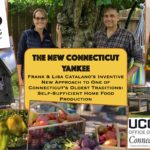 Episode 122: The New Connecticut Yankee
Episode 122: The New Connecticut Yankee
56 minutes. Release date: July 15, 2021
In this episode state historian Walt Woodward visits Frank and Lisa Catalano who, in their 18th-century home garden in Lebanon, are using some very inventive approaches to bring back an old Connecticut tradition—self-sufficient food production. It’s a history show for garden geeks . . . or maybe a garden show for history geeks.
Read more!
“363 Years of Farming at the Dennison Homestead,” Summer 2017
“Saving Historic Family Farms,” Spring 2021
CT History for Kids
Learning Through Places – Family Farms
Rural Town: Lebanon
Episode 121: Rooted in History: Connecticut’s Trees
65 minutes. Release date: June 29, 2021
Dr. Leah Glaser and students from her 2021 Public History class at Central Connecticut State University present stories about the state’s witness trees—a project that evolved out of a semester-long study of local and community history. Trees are central characters , they found, in the state’s history, myths, and legends. Trees witnessed the changing environmental, political, social, economic, and cultural landscape for decades and even centuries. What’s a witness tree, you ask? Find out in this episode of Grating the Nutmeg featuring:
Min. 3:40 — Mashantucket: The Mashantucket Pequots and the Rhododendron by Andy King
Min. 7:53 — Simsbury’s Pinchot Oak by David Prochorena
Min. 11:55 — Hartford: The Witch Tree and the Hartford Witch Trials by Helena Torres Diaz
Min. 15:50 — Coventry: Nathan Hale Pear Tree by Despina Merriman
Min. 19:50 — Easton: Puritans to Patriots, Ye Olde Oak by Gregory Franklin
Min. 22:50 — Torrington: John Brown’s Tree by Cameron Clarke
Min. 26:26 — Farmington: Teddy Roosevelt and the McKinley Tree by Grayson Belisle
Min. 30:22 — Granby: Land Stewardship and the Dewey Oak by Emma Koss
Min. 35:47 — Windham: WWII Patriotism and Arbor Day by Valerie Chase
Min. 39:39 — Hartford: The Old Oak Tree and the Coltsville Labor Strike by Benjamin Johnson
Min. 44:05 — Hartford: Blue Cedars and the Rural Cemetery Movement, Hartford by Kaitlyn Oberndorfer
Min. 48:47 — New Haven: The Cypress Tree Mystery at Edgewood Park by Patricia Wallace
Min. 54:40 — Clinton: The Chestnut Oak and Shipbuilding on the Connecticut Shoreline by Garrett Saranich
Min. 57:22 — Madison: The Black Cherry Tree Oversees Seaport to Coastal Gateway by Ben Haberman
Min. 1:01: 16 — Hartford: Of Hickory and Baseball by Tom Ieronimo
Dr. Glaser wrote “Trees as Memorials and Witnesses to History,” Spring 2021. She is a professor at Central Connecticut State University and Coordinator of the Public History Program. Her 2021 class researched tree stories and each student presented one story on the podcast. Contact her at glaserles@ccsu.edu. This episode was produced by Leah Glaser and Mary Donohue and engineered by Patrick O’Sullivan.
Read More!
“Trees as Memorials and Witnesses to History,” Spring 2021
“Site Lines: Connecticut State Parks at 100,” Summer 2013
“Cherry Trees for Wooster Square,” Winter 2013/2014
“Wickham Park in Manchester,” Spring 2003
“Connecticut’s Historic Rose Gardens,” Winter 2017/2018 and see Episode 115
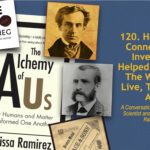 Episode 120: How Four Connecticut Inventors Helped Change the Way We Live, Think, & Act
Episode 120: How Four Connecticut Inventors Helped Change the Way We Live, Think, & Act
34 minutes. Release date: June 15, 2021
State Historian Walt Woodward talks with award-winning author and materials scientists Ainissa Ramirez, author of “Sarah Boone Invents a Better Ironing Board,” Summer 2020, about her award-winning and highly acclaimed book The Alchemy of Us: How Humans and Matter Transformed One Another. On virtually every national Top Science Book of the Year List for 2020, The Alchemy of Us is a wonderfully readable, lively, smart and witty account of the development of eight inventions that have not only transformed the way we live, but have transformed us, too. Not surprisingly, half of those inventions have important Connecticut connections.
Ramirez and Woodward discuss the roles Samuel F Morse, Edwin Land, Ansonia’s William Wallace and New Haven’s George Coy played in creating inventions that have helped the world convey, see, capture and think in new and different ways. It’s a fascinating and surprising story fest with one of the science world’s best story tellers.
Read more!
Read all of our stories about products made and invented in Connecticut on our Made in Connecticut TOPICS page
“Sarah Boone Invents a Better Ironing Board,” Summer 2020
“Coy Brings the Telephone to the Masses,” Winter 2020/2021
Episode 119: Uncovering Connecticut’s LGBTQ History
34 minutes. Release date: June 1, 2021
Lives of the state’s LGBTQ citizens have moved from being hidden and solitary to claiming visible, powerful, valuable, and contributing places in society. In this episode, Mary Donohue, asst. publisher of Connecticut Explored, interviews CCSU Assistant Professor of History William J. Mann about when and how the LGBTQ movement started in Connecticut, what legislative goals and strategies drove the movement, and what the current goals are for the LGBTQ movement. Mann discusses the impact of AIDS and the ways that the LGBTQ community supported its members. He describes how his students helped to research and uncover the people and events highlighted in the online exhibition, “Historic Timeline of Connecticut’s LGBTQ Community.” Mann wrote CT Explored’s “A Brief History of Connecticut’s Gay Media.”
Mann teaches LGBTQ history, film history, and the history of AIDS. He is the director of CCSU’s LGBTQ Center. From 1989-1995, he was the editor and later publisher of Metroline, the state’s LGBTQ newsmagazine, and coordinator of Your Turf, the first LGBTQ youth group in the state. In 1989, along with Terri Reid, William founded the long-running queer film festival known today as Out Film CT. He is author of 12 books, many on American film history.
Find the LGBTQ Timeline at https://chs.org/lgbtq/. It is a partnership between Central Connecticut State University and the Connecticut Historical Society, and is based on the work of Richard Nelson, CCSU 403 students in 2019, and will continue to grow.
This episode was produced by Mary Donohue, Assistant Publisher of Connecticut Explored, the magazine of Connecticut history and mixed by Patrick O’Sullivan. Mary Donohue has documented Connecticut’s architecture, built environment and popular culture for over 30 years. Contact her at marydonohue@comcast.net
Read more!
Ann Stanback, Love Makes a Family, in “Women Who Changed the World,” Summer 2011
“An Early Advocate for Connecticut’s Gay Community,” Summer 2014
“Site Lines: A Love Story at the Palmer-Warner House,” Fall 2019
“Philip Johnson’s 50-Year Experiment in Architecture and Landscape,” Winter 2019-202, and “Philip Johnson in his Own Words,” Winter 2009-2010
“Stonington: Poet James Merrill’s House,” Summer 2016
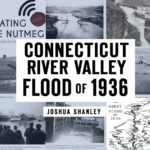 Episode 118: The Connecticut River Valley Flood of 1936
Episode 118: The Connecticut River Valley Flood of 1936
47 minutes. Release date: May 15, 2021
Josh Shanley—firefighter, paramedic, and Emergency Management Director for Northampton, Massachusetts—talks about the Great Connecticut River Flood of 1936, its devastating effects, long-term consequences, and the message it has for a world in climate change. Based on his new book, Connecticut River Valley Flood of 1936 (History Press).
Read more!
“Eyewitness Account of the Flood of 1936,” Fall 2002
“What a Disaster!” Fall 2011
“The Great White Hurricane of 1888,” Winter 2019-2020
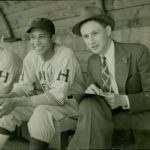
Johnny “Schoolboy” Taylor and Savitt Gems business manager Bernie Ellovich, 1930s-40s. Connecticut Historical Society
Episode 117: Before 42: Ball Players of Color in Connecticut
30 minutes. Release date: May 1, 2021
Connecticut Historical Society’s Natalie Belanger talks with labor historian Steve Thornton of The Shoeleather History Project about Black baseball in Connecticut. Thornton is the author of Connecticut Explored’s “African American Greats in Connecticut Baseball,” Summer 2018.
Read or watch for more!
To learn more about the Negro Leagues, check out this recent talk at the CT Historical Society by Bob Kendrick, President of the Negro Leagues Baseball Museum in Kansas City.
This episode was produced by Natalie Belanger and and engineered by Patrick O’Sullivan.
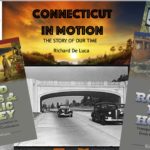 Episode 116: Connecticut In Motion: The Story of Our Time
Episode 116: Connecticut In Motion: The Story of Our Time
55 minutes. Release date: April 15, 2021
In a lecture for Cheshire Public Library promoting his second book about Connecticut transportation history, Paved Roads and Public Money (Wesleyan University Press), historian, civil engineer, and highway and transportation planner Richard DeLuca underscores the inseparable relationships between population, technology, and the environment.
Read more!
“Litchfield’s Fortunes Hitched to the Stagecoach,” Spring 2008
“The Ill-Fated Farmington Canal,” Spring 2008
“Traveling Hartford-Area Turnpikes—Then, Now, or Never?,” Spring 2008
Episode 115: America’s First Public Rose Garden – Elizabeth Park
30 minutes. Release date: April 3, 2021
Visitors have been enchanted by the thousands of soft and fragrant rose petals in Elizabeth Park’s Rose Garden since it opened in 1904. Climbing roses intertwined in overhead garlands, hybrid tea roses and heritage roses in every color symbolize romance, friendship and passion.
Elizabeth Park, on the Hartford-West Hartford border, is home to the country’s oldest public rose garden. Visitors by the thousands come to stroll in the rose garden and sit in the vine-covered gazebo. Generations of prom goers and wedding parties have had their photos taken there.
But how did Elizabeth Park become the public park it is today? Find out how Frederick Law Olmsted, the father of landscape architecture, a contested will, and a beloved wife are all part of the story.
Mary Donohue interviews Elizabeth Park’s rosarian Stephen Scanniello about all things roses. Donohue has documented Connecticut’s architecture, built environment and popular culture for over 30 years.
This episode was produced by Mary Donohue, Assistant Publisher of Connecticut Explored, the magazine of Connecticut history and engineered by Patrick O’Sullivan.
Read more!
Transcript of the episode
“Connecticut’s Historic Rose Gardens,” Winter 2017-2018
“Off the Streets & Into the Parks,” Spring 2003
Episode 114: Part II — Archaeologist Nick Bellantoni: When Tombs Are Also Crime Scenes
37 minutes. Release date: March 15, 2021
Sometimes tombs become crime scenes. State Archaeologist Emeritus Nick Bellantoni talks with Walt Woodward about two such cases in which he was called in to do forensic archaeology, and the process of doing historic detective work in pursuit of justice. He also provides the latest developments concerning the discovery of revolutionary war skeletons in a basement in Ridgefield in December 2019. Go to episode 112 for part I.
Read more!
“Nick Bellantoni: 30 Years of Great Finds,” Summer 2014
“Rediscovering Albert Afraid of Hawk,” Summer 2014
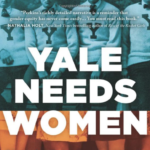 Episode 113: Yale Needs Women
Episode 113: Yale Needs Women
43 minutes. Release date: March 1, 2021
In 1969, women were finally allowed entry to undergraduate study at Yale University in New Haven. Their experience was not the same as their male peers enjoyed. Isolated from one another, singled out as oddities and sexual objects, and barred from many of the school’s privileges, the young women nonetheless met the challenge of being first and changed Yale in ways it had never anticipated.
Mary Donohue interviews historian and Yale alumna Anne Gardiner Perkins, author of Yale Needs Women: How the First Group of Girls Rewrote the Rules of an Ivy League Giant, and New Haven leader Constance Royster, one of Yale’s first women undergrads. Perkins is an award-winning historian and higher education expert. Yale Needs Women won the 2020 Connecticut Book Award. Royster holds a J.D. from Rutgers University Law School – Newark, and a B.A. cum laude from Yale University.
This episode was produced by Mary Donohue, Assistant Publisher of Connecticut Explored, the magazine of Connecticut history and engineered by Patrick O’Sullivan.
Read more!
“UConn Law: The Trailblazing Bessye Bennett,” Spring 2014
“Yale’s Grace Murray Hopper College,” Fall 2017
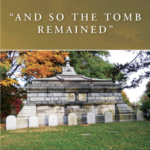 Episode 112: Archaeologist Nick Bellantoni on His New Book—”And So the Tomb Remained”
Episode 112: Archaeologist Nick Bellantoni on His New Book—”And So the Tomb Remained”
58 minutes. Release date: February 15, 2021
What secrets about the past can an ancient tomb reveal? The answers, as State Archaeologist emeritus Nick Bellantoni explains, are many, surprising, and incredibly interesting. In this conversation about Bellantoni’s new book, “And So the Tomb Remained”: Exploring Archaeology and Forensic Science in Connecticut’s Historical Family Mausolea, State Historian Walt Woodward explores how Bellantoni, in his 30 plus years as state archaeologist, entered more tombs that any other archeologist and his experiences doing restoration, recovery work, and criminal investigations in the tombs of some of Connecticut’s oldest and most powerful families.
Read more!
“30 Years of Great Finds,” Summer 2014
“Rediscovering Albert Afraid of Hawk,” Summer 2014
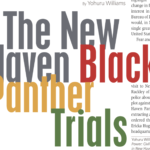 Episode 111: The New Haven Black Panther Trials
Episode 111: The New Haven Black Panther Trials
21 minutes. Release date: February 1, 2021
Fifty years ago, Ericka Huggins and Bobby Seale of the Black Panthers were on trial for their lives in New Haven. In this episode, Natalie Belanger of the Connecticut Historical Society takes a look back at the New Haven Black Panther trials, using some of the many primary sources available.
Natalie Belanger is the Adult Programs Manager at the Connecticut Historical Society. You can contact her at natalie_belanger@chs.org. Produced by Natalie Belanger and engineered by Patrick O’Sullivan.
Read more!
“The New Haven Black Panther Trials,” Winter 2019-2020
“The Hartford Chapter of the Black Panthers: Interview with Butch Lewis,” Fall 2004
Online Exhibit
“Bulldog and Panther: The 1970 May Day Rally and Yale,” Yale University Library, covers the events leading up to the May Rally, and its aftermath.
Robert Templeton’s courtroom sketches of the Black Panther Trials: here.
The trial transcripts are available digitally through Yale Law School’s Lillian Goldman Law Library.
The recording of Alex Rackely’s interrogation can be heard via Youtube through this link to the New Haven Independent’s reporting of its discovery. Editor Paul Bass co-wrote, with Douglas W. Rae, Murder in the Model City: The Black Panthers, Yale, and the Redemption of a Killer.
Episode 110: A Jewish Child’s Survival in World War II
53 minutes. Release date: January 18, 2021
Join Mary Donohue, Asst. Publisher of Connecticut Explored, to learn more about Polish-Jewish history and how our guest Dr. Leon Chameides (center, back row with dark hair) survived the Nazi occupation of Poland as a child. Despite the fact that many American Jews trace their family to Poland, there are many misconceptions about Polish history and the history of Polish-Jewish relations. Dr. Leon Chameides was born in Poland in 1935 and spent the war years hidden in a Ukrainian Greek-Catholic monastery. He went to England in 1946 and came to the United States in 1949. He was Director of Pediatrics at Hartford Hospital for 10 years.
To read more about Dr. Chameide’s life and family, read his story in the Fall 2020 issue, and look for his book Strangers in Many Lands, available on Amazon books. For more information about Hartford’s Jewish history, visit the website of the Jewish Historical Society of Greater Hartford at https://jhsgh.org/, and for more about Connecticut’s connection to the Holocaust, visit the website of Voices of Hope at http://ctvoicesofhope.org/.
Mary M. Donohue is the Asst. Publisher of Connecticut Explored. She has documented Connecticut’s architecture, built environment and popular culture for over 30 years. Contact her at https://www.granthousect.com/. This episode was produced by Mary Donohue, Assistant Publisher of Connecticut Explored and engineered by Patrick O’Sullivan.
Read more!
“A Jewish Child’s Experience of War,” Fall 2020
For more about Connecticut in World War II, visit our Connecticut at War TOPICS page.
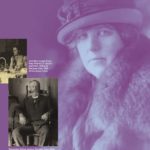
Theodate Pope, Bachrach Studio, c. 1915. Hill-Stead Museum Archives; (inset) Philosopher William James at Theodate Pope’s home, The O’Rourkery, 13 High Street, Farmington, August 1907. photo: Theodate Pope. Hill-Stead Museum Archives
Episode 109: Communicating with the Spirits with Theodate Pope Riddle
31 minutes. Release date: January 1, 2021
In 1938 pioneering female architect and founder of the Hill-Stead Museum, Theodate Pope Riddle of Farmington enjoyed an excursion through Europe. While in London she participated in three sittings with trance mediums, continuing an avocational interest in spiritualism that lasted 34 years. Hear more about Riddle’s efforts to scientifically prove the ability to communicate with the deceased in this episode hosted by Mary Donohue, Assistant Publisher of Connecticut Explored and Melanie Bourbeau, Curator and Director of Interpretation and Programs at Hill-Stead Museum in Farmington.
This episode was produced by Mary M. Donohue and engineered by Patrick O’Sullivan. Mary M. Donohue is the Assistant Publisher of Connecticut Explored. She has documented Connecticut’s architecture, built environment and popular culture for over 30 years.
Read more!
“Communicating with the Spirits,” Winter 2020-2021
“Isabella Beecher Hooker and The Spirit of Reform,” Winter 2008/2009
“The Pine Grove Spiritualist Camp,” Spring 2020
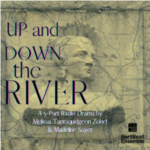 Episode 108: Up and Down the River with Melissa Tantaquidgeon Zobel
Episode 108: Up and Down the River with Melissa Tantaquidgeon Zobel
55 minutes. Release date: December 15, 2020
Mohegan Medicine Woman, tribal historian, and award-winning playwright and screenwriter Melissa Tantaquidgeon Zobel sits down with state historian Walt Woodward to talk about the radio drama Up and Down the River she and her equally accomplished daughter Madeline Sayet recently wrote, produced, and directed for Hartford’s Heartbeat Ensemble. The five short plays provide a unique and important window into key moments in Mohegan history and culture. Zobel provides both a writer’s and a people’s perspective on the stories, and tells how everyone can—through 12/31/20–hear the radio drama for free on the Heartbeat Ensemble website.
Read more!
Explore stories about Native Americans in Connecticut on our Explore by TOPIC page.
Find a short-cut to all of our GTN podcasts about Native Americans HERE,
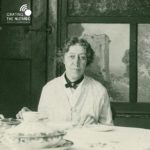 Episode 107: Miss Florence’s Boardinghouse and American Impressionism
Episode 107: Miss Florence’s Boardinghouse and American Impressionism
31 minutes. Release date: December 6, 2020
Mary Donohue, assistant publisher of Connecticut Explored, talks to Florence Griswold Museum curator Amy Kurtz Lansing about one of the most beautiful places to visit in Connecticut: the Florence Griswold Museum in Old Lyme. Did Old Lyme become the home to an art colony because of the good food at Miss Florence’s boardinghouse or because of the soft, lovely light on the salt marshes along the Lieutenant River? The episode uncovers the roots of the Old Lyme Art Colony and two new exhibitions on view now: Celebrating 20 Years of the Hartford Steam Boiler Collection, an exhibition that marks the arrival of 190 works of art in 2001 and a gift that transformed the museum, and The Centennial of the Lyme Art Association Gallery, about the museum’s neighbor that partially recreates its 1921 inaugural exhibition in the shingle style building designed by society architect Charles A. Platt, designer of the Freer Art Gallery in Washington, DC and the Lyman Allyn Museum in New London. Florence Griswold was inducted into the Connecticut Women’s Hall of Fame in 2002. This episode was produced by Mary M. Donohue and engineered by Patrick O’Sullivan.
Help us continue to produce Grating the Nutmeg! Please make a gift to Friends of Connecticut Explored and use coupon code Gratingthenutmeg to have your gift support the podcast. All gifts with this coupon code will be shared with the Office of the State Historian to support its outreach efforts. Go to ctexplored.org to make your donation.
Read more!
“The Spirit of Miss Florence Restored,” Winter 2005/2006
“‘Only waiting to be painted’: The Inspirational Landscape of Old Lyme,” Summer 2006
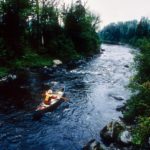 Episode 106: Part 1 – Steve Grant’s Legendary 1991 Source-to-Sea Connecticut River Journey
Episode 106: Part 1 – Steve Grant’s Legendary 1991 Source-to-Sea Connecticut River Journey
62 minutes. Release date: November 16, 2020
Episode 106: Part II – Steve Grant’s Legendary 1991 Source-to-
Sea Connecticut River Journey
60 minutes. Release date: November 16, 2020
In the summer of 1991, reporter and environmentalist Steve Grant traveled the entire 410 miles of the Connecticut River from its source near the Canadian border in New Hampshire to the Long Island Sound by self-paddled canoe. Throughout the 33-day journey, Grant reported on his voyage in stories for The Hartford Courant. His every-other-day tales made Grant a celebrity and his journey a legend. Twenty-nine years after that life-changing trip, State Historian Walt Woodward met Grant on the banks of the Connecticut River in Hartford to talk about the journey, the man, and the river in another time.
Read more!
“The Connecticut River: First National Blueway Runs Through Connecticut,” Spring 2014
“Connecticut River Legends,” Spring 2019
“Pleasure Boating on the Connecticut River,” Summer 2018
Read all of our stories about Connecticut’s landscape and environment on our TOPICS page.
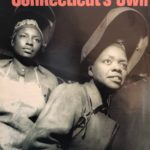
Women welders at the Landers, Frary and Clark plant in New Britain, June 1943. photo: Gordon Parks, Library of Congress
Episode 105: Connecticut’s Rosie the Riveter: Working Women in WWII
38 Minutes. Release date: November 1, 2020
In this episode, Natalie Belanger of the Connecticut Historical Society takes a look at the iconic Rosie the Riveter character. To get the scoop on what it was like to be a real-life “Rosie” in CT during WWII, she speaks to Gretchen Caulfield, President of the American Rosie the Riveter Association. (https://rosietheriveter.net/) Visit CHS’s two exhibitions marking the 75th anniversary of the end of World War II: “Manufacturing for Victory: The Arsenal of Democracy,” and “Fighting on the Homefront: Propaganda Posters of WWII,” on view through January 2, 2021.
This episode was produced by Natalie Belanger and engineered by Patrick O’Sullivan.
Read more!
“Connecticut’s Own Rosie the Riveters,” Fall 2003
Read more stories about Connecticut at War on our TOPICS page.
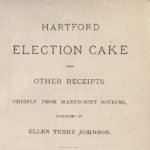 Episode 104: Great Traditions: The Connecticut Election Cake
Episode 104: Great Traditions: The Connecticut Election Cake
47 Minutes. Release date: October 15, 2020
With the elections coming up, we’re celebrating one of Connecticut’s oldest — and for centuries best known — traditions: the Connecticut Election cake. In this conversation with Allie Kyff of the Connecticut Democracy Center at Connecticut’s Old State House, state Historian Walt Woodward discusses the fascinating history of this delicious tradition. Read Walt’s story for CT Explored: “Sweet Democracy: The History of the Connecticut Election Cake,” Summer 2017
Read more stories about Connecticut food history on our TOPICS page.
And look below for Walt’s other podcasts about food history.
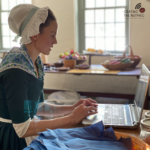 Episode 103: Cannonballs and Skyscrapers — Keeler Tavern Museum
Episode 103: Cannonballs and Skyscrapers — Keeler Tavern Museum
39 Minutes. Release date: October 1, 2020
Owned by the same family for its first 200 years and then purchased by star architect Cass Gilbert in 1907 for his summer home, the Keeler Tavern was smack in the middle of the American Revolution’s Battle of Ridgefield and has a cannonball embedded in the façade to prove it. New York City architect Cass Gilbert, designer of early skyscrapers like the Woolworth Building in New York City, kept all of the home’s colonial charm and added to it! Cass Gilbert had a big impact on Connecticut’s architecture in Hartford, Waterbury, Waterford, and New Haven. But there’s more to the Keeler Tavern than a pretty place! New research is enhancing the museum’s ability to tell women’s and African American history in programming for adults and children. The pandemic pushed many museums to reach out to their audience using new technologies. Hear more about how the Keeler Tavern Museum and History Center’s dynamic staff is telling their story and finding new audiences in 2020 with architectural historian Mary Donohue.
Thank our guests Hildi Grob, Executive Director, Catherine Prescott, Chief Curator, and Melissa Houston, Educational Director from the Keeler Tavern Museum and History Center. See more at https://keelertavernmuseum.org/
Find a photo album for this episode HERE.
Our mid-reel sponsor is the Wilton Historical Society at http://wiltonhistorical.org/.
Mentioned in the episode: Historical Interpreter-Cheyney McKnight at NotYourMommasHistory
Playwrights: Joanne Hudson, Redding, CT and Royal Shiree, Lynchburg, VA
This episode was produced by Mary Donohue, Assistant Publisher of Connecticut Explored, and engineered by Patrick O’Sullivan. Music by Hyde.
Read more
“Benedict Arnold and the Battle of Ridgefield”
Cass Gilbert-designer buildings:
“Glamour and Purpose in New Haven’s Union Station”
“Longer Lasting Than Brass: Waterbury’s City Hall Restored”
“Seaside”
 Episode 102: Archimedes, Silk Worms, Vanderbilt & The Perfect Screw
Episode 102: Archimedes, Silk Worms, Vanderbilt & The Perfect Screw
33 Minutes. Release date: September 17, 2020
In this podcast from the memoir of Ellsworth S. Grant, one of the state’s great historians, Walt Woodward tells us about the invention of the world’s best fastening device. It’s a story that begins with Archimedes, and that came to fruition because of silk worms, Cornelius Vanderbilt, an entrepreneur named Dimoch, and an Irish inventor who gave this unique tool its name. It’s a story for anyone who ever put together a piece of IKEA furniture — the story of the recessed hexagonal screw and the Allen wrench!
Read more!
“Iconic Connecticut Brands,” Winter 2015-2016
Episode 101: Sophie Tucker, Hartford’s Red Hot Mama
20 Minutes. Release date: September 1, 2020
Sophie Tucker was one of the 20th century’s most successful and highest paid performers. A singer and humorist, she transitioned successfully through vaudeville, recordings, Broadway, radio, movies, nightclubs, and finally television. Born into a Jewish family that emigrated from Eastern Europe, her parents ran a kosher restaurant in Hartford’s Front Street district. Many of the threads that run through her life resonant with women now — including body positivity, female agency, an artist’s control of their own work and career, as well as a rags to riches immigrant success story. This episode includes snippets from three of her most famous songs: “One of These Days” by African American composer Sheldon Brooks, “I’m the Last of the Red Hot Mama’s” by Milton Agar and Jack Yellen, and “My Yiddishe Momme” by Jack Yellen. Tucker never forgot Hartford and contributed to numerous local charities—see our story and link below for photos. She left almost 400 scrapbooks documenting her full career to the New York Public Library. She was inducted into the Connecticut Women’s Hall of Fame in 1999. This episode was produced by Mary Donohue and engineered by Patrick O’Sullivan.
Read More!
“Sophie Tucker: Last of the Red Hot Mamas,” Fall 2006
Read about Tucker’s mother and Jewish philanthropy: “The Handkerchief Brigade,” Fall 2015
The Jewish Historical Society of Greater Hartford’s online exhibition: Red Hot Momma: The Life of Sophie Tucker
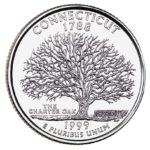 Episode 100: The Unlikely Legend—and History—of the Charter Oak
Episode 100: The Unlikely Legend—and History—of the Charter Oak
44 Minutes. Release date: August 19, 2020
For our 100th episode, a revealing new look at Connecticut’s oldest and most iconic legend: the Charter Oak. State historian Walt Woodward dug deep into this time-honored tale, and offers a new, true, and sometimes amusing look into the history behind this foundational legend.
Read More
“Exploiting the Legend of the Charter Oak,” WINTER 2007/08
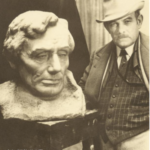 Episode 99: Connecticut’s Mount Rushmore Connection
Episode 99: Connecticut’s Mount Rushmore Connection
21 Minutes. Release date: August 1, 2020
Mary Donohue, Assistant Publisher of Connecticut Explored, reveals Connecticut’s connection to Gutzon Borglum, the sculptor of Mount Rushmore, and the run up to his most contentious project, the Mount Rushmore National Monument in South Dakota.
Perhaps the largest outdoor sculpture in the country, Mount Rushmore has been controversial since it was proposed. Where it’s located, who it commemorates, and its sculptor are all part of the national conversation right now. Built on Native American land, featuring the faces of four American presidents–two of whom were slaveholders (Washington and Jefferson) and two of whom were involved in efforts to uproot Western Native American tribes (Lincoln and Roosevelt). And the sculptor behind the design, Connecticut resident Gutzon Borglum? He was someone who, according to New York Times article “How Mount Rushmore became Mount Rushmore” (July 1, 2020), formed great bonds with leaders of the Ku Klux Klan and participated in their meetings to secure funding for the Stone Mountain project in Georgia. Borglum also espoused white supremacist and anti-Semitic ideas.
This episode was produced by Mary Donohue and engineered by Patrick O’Sullivan.
Read more
Connecticut’s Mount Rushmore Connection, Spring 2015
To read more about his career, visit this post on Stamford Museum and Nature Center’s site.
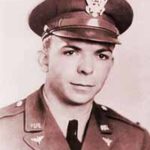 Episode 98: Connecticut’s First World War II Hero; Dependable Engines
Episode 98: Connecticut’s First World War II Hero; Dependable Engines
21 Minutes. Release date: July 15, 2020
State historian Walt Woodward presents two stories he wrote for the Fall 2020 special issue of CT Explored commemorating the 75th anniversary of World War II. The first tells how Pratt & Whitney Aircraft prepared for the coming crisis and the second tells the story of Gordon H. Stirling of West Hartford, Connecticut’s first World War II hero.
Read more
“Connecticut’s First World War II Hero,” Fall 2020
75th Anniversary of World War II, Fall 2020
Read all of our stories about Connecticut at War on our TOPICS page.
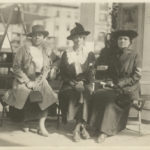
Mary A. Johnson (center), Elizabeth R. Morris (left), and Rosa J. Fisher (right) representing Hartford’s Colored Women’s Liberty Loan Committee, 1918. Photo: Edward M. Crocker, Connecticut State Library
Episode 97: Uncovering African American Women’s Fight for Suffrage
35 Minutes. Release date: July 9, 2020
In this episode, Natalie Belanger of the Connecticut Historical Society talks to historians Brittney Yancy and Karen Li Miller about their ongoing project to uncover the suffrage work of women of color in Connecticut. African American women rallied for the woman’s suffrage cause, determined to ensure black women’s inclusion and electoral self-representation.
if you’d like to learn more about this topic, visit the CHS’s website at CHS.org/wocvotes. For a broader look at the woman’s suffrage movement in CT, you can see the exhibit “A Vote of Her Own: The Long Fight for Woman Suffrage” on view at the CHS in fall 2020. And don’t forget to order your copy of the Summer issue of CT Explored at ctexplored.org with the article “Uncovering African American Women’s Fight for Suffrage” by Karen Li Miller, available at ctexplored.org/shop.
Thank you to our guests. This episode was produced by Natalie Belanger and engineered by Patrick O’Sullivan. Photo credit:
Read more
Summer 2020
“Audacious Alliances: Mary Townsend Seymour,” Summer 2003
100th Anniversary of Women’s Suffrage—stories from back issue
Episode 96: Rough Justice for Nathan Hale
33 Minutes. Release date: June 15, 2020
State historian Walt Woodward takes a new look at the actions surrounding the Revolutionary War execution of state hero Nathan Hale and finds there are still some burning questions left to be answered about this hasty and irregular event. It’s a story from Woodward’s new book Creating Connecticut: Critical Moments That Shaped a Great State, just out from Globe Pequot Press. As you’ll soon hear, when looking for answers about the rough justice handed out to Nathan Hale by the British in New York in 1776, where there’s smoke, there’s fire.
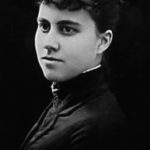 Episode 95: “Beware of the Sea, for it is a Wide, Wide Love”
Episode 95: “Beware of the Sea, for it is a Wide, Wide Love”
27 Minutes. Release date: May 26, 2020
In this episode CT Explored publisher Elizabeth Normen draws inspiration from the haunting words of her great-great grandmother, the wife of a sea captain during the Great Age of Sail. Her ancestor was one of hundreds of women in the 19th century who made the difficult choice to leave all they knew and those they loved for the uncertainly of a life at sea. What were the joys and hardships for women who made that choice? Find out in this episode of Grating the Nutmeg.
Find more stories about brave women in our Summer 2020 issue commemorating the 100th Anniversary of Women’s Suffrage, including important stories about Native American and African American women and the right to vote. Please support us by subscribing at ctexplored.org.
This episode was produced by Elizabeth Normen and Patrick O’Sullivan. Thanks for Moira O’Sullivan for narrating portions of the story.
Read More!
For more stories about Connecticut’s maritime history, see the Spring 2009 issue.
Episode 94: Connecticut’s Jewish Farmers
33 Minutes. Release date: May 3, 2020
Mary Donohue, assistant publisher of Connecticut Explored and co-author of A Life of the Land: Connecticut’s Jewish Farmers, explores the story of Connecticut’s Jewish farmers in the last century. Surprised that there were Jewish farmers in Connecticut? Many people are, but scores of newly arrived Jewish immigrants were assisted in making their lives in poultry and dairy farming throughout the state. Some farms developed into resorts catering to vacationing urbanites seeking a bigotry-free, relaxing vacation in the countryside.
This episode was produced by Mary Donohue, assistant publisher of Connecticut Explored, and engineered by Patrick O’Sullivan. It features the voices of Moira O’Sullivan and Patrick O’Sullivan. Music by New Town Klezmer.
Read More!
“Hebrew Tillers of the Soil,” Spring 2006 issue
“The Connecticut Catskills, ”Summer 2018
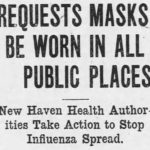 Episode 93: Connecticut and the Pandemic of 1918
Episode 93: Connecticut and the Pandemic of 1918
31 Minutes. Release date: April 16, 2020
State historian Walt Woodward explores the deadliest disease to ever hit the state–one that, like COVID-19, stopped life-as-people-knew-it in its tracks. Where did the Spanish flu come from? How did it spread? Who did it affect? Woodward asks the questions we’re asking about today’s pandemic to the pandemic of a century ago, and found history, as always, to be an important reference point.
READ MORE!
“Spanish Flu: 90 Days that Sickened Connecticut,” Spring 2007
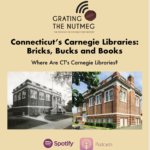 Episode 92: Connecticut’s Carnegie Libraries: Bricks, Bucks, and Books
Episode 92: Connecticut’s Carnegie Libraries: Bricks, Bucks, and Books
28 Minutes. Release date: April 1, 2020
Architectural historian and CT Explored assistant publisher Mary Donohue digs deep to uncover which local libraries in Connecticut were funded by robber baron, steel tycoon, and philanthropist Andrew Carnegie at the beginning of the 20th century. Why did the City of New Haven turn down a generous $300,000 gift from Carnegie in 1903 to build a large public library? How did communities apply for library construction grants from Carnegie and what were the requirements? What were the strings attached to accepting the money?
And, what has become of these well-built landmarks in Connecticut? Find out from guest Robert Kinney, Outreach Services Librarian at the Connecticut State Library and Pastor of Mount Hope Temple Church in New Haven what it takes to adaptively reuse an almost 100-year-old library building for a new purpose.
This episode was produced by Mary Donohue, Assistant Publisher of Connecticut Explored, and engineered by Patrick O’Sullivan.
READ MORE!
“Connecticut’s Carnegie Libraries,” Fall 2015
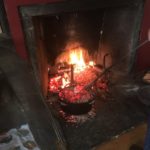 Episode 91: Cooking the Colonial Way with Tom Linskey
Episode 91: Cooking the Colonial Way with Tom Linskey
51 Minutes. Release date: March 15, 2020
Twice a year, restoration carpenter Tom Linskey and his wife Sally Irons host a heart-cooked colonial feast in their historic 18th-century Portland home as a benefit for their favorite charities. For those events Chef Tom Linskey spends an entire week prepping, preparing, and cooking a totally hearth-cooked panoply of colonial dishes to serve for the benefits’ guests. In February 2020, State Historian Walt Woodward stopped in to see Tom throughout the week to learn about hearth-cooking and feasting in the colonial era. The result was a delicious and wonderfully informative encounter with hearth-cooking and colonial foodways.
You can view photos of the hearth cooking experience and some of the items in the Linsky’s colonial tavern room on the Connecticut State Historian’s Facebook page.
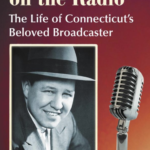 Episode 90: Bob Steele: the Voice of Connecticut Radio
Episode 90: Bob Steele: the Voice of Connecticut Radio
31 Minutes. Release date: March 1, 2020
For more than sixty years, Bob Steele was the voice of Southern New England, entertaining listeners of WTIC AM with his wit and humor. Connecticut author Paul Hensler has written the first-ever biography of Steele, chronicling his hardscrabble beginnings in the Midwest, his early career as a boxer, and his almost accidental hiring as an announcer at WTIC in the midst of the Great Depression. In this episode, recorded at the Connecticut Historical Society with Natalie Belanger, Hensler provides a look into Steele’s life and work.
Paul Hensler’s book, Bob Steele on the Radio: The Life of Connecticut’s Beloved Broadcaster, is published by McFarland. We wish to thank Natalie Belanger and author Paul Hensler. This episode was produced by Natalie Belanger and engineered by Patrick O’Sullivan.
READ MORE!
“Howdy Men: Bob Steele,” Nov/Dec/Jan 2004, Vol 2/No 1
 Episode 89: Why Teaching African American History in Connecticut Matters
Episode 89: Why Teaching African American History in Connecticut Matters
37 Minutes. Release date: February 15, 2020
We wish to thank Dr. Benjamin Foster and Representative Bobby Gibson and Carmen Arace Middle School for hosting us. This episode was produced by Elizabeth Normen and engineered by Patrick O’Sullivan.
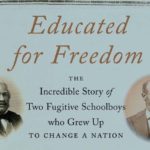 Episode 88: Educated for Freedom
Episode 88: Educated for Freedom
66 Minutes. Release date: February 1, 2020
UConn English professor Anna Mae Duane has written an amazing new book about James McCune Smith and Henry Garnet, two African American boys who met as young students at the New York African Free School on Mulberry street. Their intertwined, but very different lives of antebellum antislavery activism helped define the possibilities for black people in American Society. State historian Walt Woodward interviews Duane about Educated for Freedom and the inspiring and informative example Smith and Garnet provided for their generation, and ours.
Episode recorded by Walt Woodward. Edited, mixed, and assembled by Matt Berky at Massive Productions.
 Episode 87: Time Capsule: Dirt Floor Studio and Connecticut Music
Episode 87: Time Capsule: Dirt Floor Studio and Connecticut Music
25 Minutes. Release date: January 15, 2020
In the Winter 2019 issue of Connecticut Explored, museum curator Dave Corrigan tackles the obsolescence of everyday objects like typewriters that were replaced by personal computers. With the advent of digital recording, CDs and streaming music services, no industry has experienced more rapid change in the last 20 years than the music industry. But as historians, we know that some people value doing things in the traditional way.
In today’s episode, Assistant Publisher Mary Donohue and podcast engineer Patrick O’Sullivan visit Connecticut’s legendary Dirt Floor Recording and Production Studios to talk to musician and Dirt Floor producer Eric Lichter. Connecticut Public Radio’s John Dankowsky calls Dirt Floor “the Music Sanctuary of Connecticut.” Hear more about how Lichter uses old fashioned, hands-on musical instruments and recording methods to produce some of Connecticut’s most popular new musicians.
We wish to thank our guests Eric Michael Lichter and musician Angela Luna. To learn more about Dirt Floor Recording and Production Studios, go to dirtfloorrecordingstudio.com and for more about Angela Luna, go to her Facebook page at Luna & the Lost Souls. Our thanks to Luna for the music in the episode.
This episode was produced by Mary Donohue, Assistant Publisher of Connecticut Explored, and engineered by Patrick O’Sullivan.
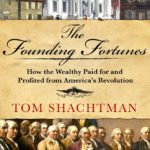 Episode 86: Who Paid for the American Revolution? The Founding Fortunes
Episode 86: Who Paid for the American Revolution? The Founding Fortunes
58 Minutes. Release date: January 2, 2020
In our first episode of 2020, state historian Walt Woodward interviews author and historian Tom Shachtman about his just released book, The Founding Fortunes: How America’s Wealthy Paid for and Profited From America’s Revolution (Macmillan, 2020). In this fascinating economic history covering the years from the birth of the Republic to the end of the War of 1812, Shachtman asks an important question most historians don’t consider: Who paid for the war for independence? The answers come with some profound insights that still resonate in the present. Shachtman also helps us understand the national significance of a number of famous Revolutionary Connecticans, including Jeremiah Wadsworth, SIlas Deane, Eli Whitney, John Fitch, and Oliver Wolcott, Jr.
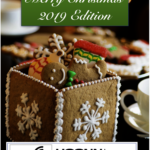 Bonus Episode 85: Connecticut Christmas Stories & Song
Bonus Episode 85: Connecticut Christmas Stories & Song
37 Minutes. Release date: December 21, 2019
For your holiday enjoyment, State Historian Walt Woodward gathered and presents three historic Connecticut Christmas stories, and a Christmas song: Francis S. Parsons’s “The Christmas Party” (1923), Louise Chandler Moulton’s “What Came to Olive Haygarth” (1867), Abby Allin’s “Old Santa Claus (1850), and Walt Woodward’s own “A Children’s Christmas.” Happy Holidays From the Grating the Nutmeg Team.
More Holiday Episodes!
Episode 62: Three Centuries of Christmas at the Webb-Deane-Stevens Museum
Episode 21: Holiday Episode 2: A Connecticut Christmas Story
Episode 20: Holiday Episode 1: Soup and Stories
READ MORE:
“Christmas in Connecticut,” Winter 2010/2011
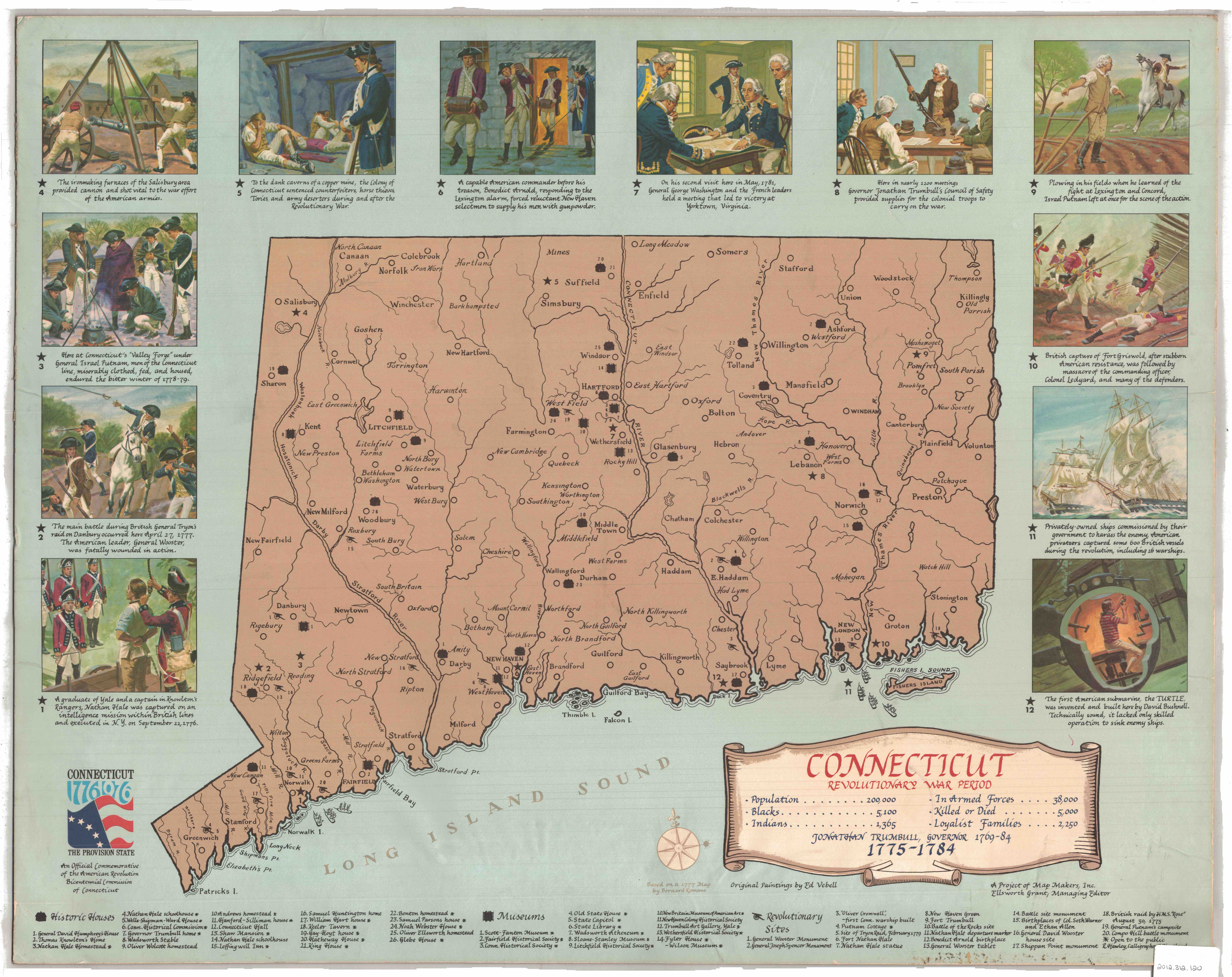 Episode 84: War, Maps & Mystery
Episode 84: War, Maps & Mystery
36 Minutes. Release date: December 16, 2019
Maps tell stories. In this episode of Grating the Nutmeg, Natalie Belanger and Ben Gammell of the Connecticut Historical Society uncover the little-known story of 18th-century cartographer Bernard Romans. A new exhibition of his maps at the CHS pieces together the life story of a bold, talented, and adventurous immigrant to Connecticut who put his considerable skills to work for the American cause and may have paid the ultimate price for it.
“War, Maps, Mystery: Dutch Mapmaker Bernard Romans and the American Revolution” is on view at the Connecticut Historical Society until May 2, 2020. To learn more, visit chs.org.
This episode was produced by Mary Donohue, Asst. Publisher of Connecticut Explored, and engineered by Patrick O’Sullivan.
Read More!
For more great stories about maps, order the Spring 2012 issue, “There’s a Map for That!”
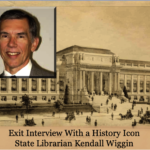 Episode 83: Exit Interview with a History Icon: Kendall Wiggin, State Librarian
Episode 83: Exit Interview with a History Icon: Kendall Wiggin, State Librarian
46 Minutes. Release date: December 1, 2019
For more than a generation, Kendall F. Wiggin has been one of the most influential champions of history issues and institutions in Connecticut. At the end of 2019, Ken is retiring after 21 years as Connecticut’s State Librarian. In a revealing interview, State Historian Walter Woodward sat down with Ken for a wide-ranging discussion about the state library’s complex role in preserving the state’s past, the effect of the Internet on historical research and libraries, the role of Connecticut history in public education, his successes and regrets, some advice for his successor, and more.
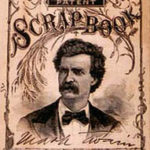 Episode 82: Writing with Scissors: Mark Twain, Harriet Beecher Stowe, and American Scrapbooks
Episode 82: Writing with Scissors: Mark Twain, Harriet Beecher Stowe, and American Scrapbooks
50 Minutes. Release date: November 19, 2019
What was life like before Google and Instagram? It’s hard to imagine! But people like Mark Twain, Abraham Lincoln, Frederick Douglass, and Susan B. Anthony used scrapbooks to collect information about all kinds of things! Twain (a.k.a. Samuel Clemens) used scrapbooks to fight unscrupulous publishers who reprinted his work without paying him. Abolitionists, suffragettes, and African Americans use scrapbooks to document and tell their stories. In this episode, Dr. Ellen Gruber Garvey, professor of English at New Jersey City University, explores how Americans from all walks of life created scrapbooks to document, store, critique, and participate in a rapidly changing world of information overload. This episode was recorded as a lecture at the Harriet Beecher Stowe Center. You’ll have to use your imagination a little to picture some of the types of scrapbooks that Dr. Garvey refers to but you’ll be fascinated by impact they’ve had on American history.
We wish to thank our guest Dr. Ellen Gruber Garvey, and the Harriet Beecher Stowe Center. Read more in Dr. Garvey’s book Writing with Scissors: American Scrapbooks from the Civil War to the Harlem Renaissance published by Oxford University Press.
This episode was produced by Mary Donohue and engineered by Patrick O’Sullivan.
Subscribe to Connecticut Explored and get the upcoming Winter issue with stories about events or inventions that disrupted history. Subscribe, buy back issues and collections—at ctexplored.org.
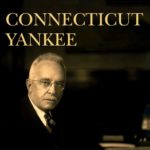 Episode 81: Wilbur Cross, Connecticut Yankee
Episode 81: Wilbur Cross, Connecticut Yankee
57 Minutes. Release date: November 1, 2019
Say the name Wilbur Cross and most Connecticans think of a parkway. Wilbur Cross the man, however, was a Connectican of extraordinary accomplishment, says state historian Walter Woodward. Born in 1862 in the factory village of Gurleyville, he became a world-class scholar, author, educational reformer, founding Dean of the Yale Graduate school, and, starting at age 68, a popular four-term governor who guided Connecticut through the worst years of the Great Depression. In this episode, Woodward sits down at the New Haven Museum with poet and publisher David Wilk, whose City Point Press recently reissued Cross’s 1943 autobiography Connecticut Yankee: An Autobiography of Wilber L. Cross, to discuss Cross’s remarkable 19th and 20th century life. As a bonus, the episode includes a reading by David Wilk of Wilber Cross’s 1936 Thanksgiving Proclamation, an eloquent invitation to thankful reflection.
Episode 80: Novelist Ann Petry and Exploring the Family Tree
38 Minutes. Release date: October 18, 2019
Elisabeth Petry is a journalist. She knows how to uncover a clue, follow a lead, and tell a good story. Her mother was bestselling novelist Ann Petry, whose 1946 debut novel The Street became the first novel by an African American to sell more than a million copies. In this episode based on her story in the Fall 2019 issue and a forthcoming documentary, Liz tells us more about her family tree—the James and Lane Families—four generations of strivers and achievers descended from self-emancipated slaves, who settled in New Haven, Hartford, and Old Saybrook, Connecticut. Four hundred family letters survive, many of which contained stories that were fodder for Ann Petry’s novels. Hear more about how Liz and two of her cousins are taking the family’s story to the screen. We join Steve Courtney at the Mark Twain House & Museum as he introduces the lecture from which this podcast was recorded.
We wish to thank Elisabeth Petry and the host for the lecture, the Mark Twain House & Museum. Read more about Liz’s search for her family history in the Fall 2019 issue of Connecticut Explored where you’ll also find Martha Hall Kelly’s story about Caroline Ferriday. You can listen to our podcast with Kelly in episode 34 and to hear more about Barbara Beeching’s research on the black middle class in Hartford, listen to Episode 53 of Grating the Nutmeg. For more information on the James Family project and documentary go to https://www.jamesfamilyletters.com/
This episode was produced by Mary Donohue, Assistant Publisher of Connecticut Explored, and engineered by Patrick O’Sullivan.
Read More!
Anna Louise James and the “James Pharmacy,” Summer 2007
Episode 79: Governor Ned Lamont on “100 Years of Fake News & Real and Fake Wars”
42 Minutes. Release date: September 23, 2019
Every governor of our state makes history, but there have been very few who know their history as well as Connecticut’s current governor Edward M. “Ned” Lamont. In this very special episode, GTN co-hosts Mary Donohue of CT Explored and State Historian Walt Woodward talk with Governor Lamont about a topic he’s passionate about. In an era when Americans are challenged to separate fact from fiction in a myriad of different media, the governor’s message is a kind of cautionary tale for all of us. And, as you’ll see, it reflects some keen and insightful thinking from a governor who takes his history seriously.
With special thanks to Governor Ned Lamont, Rob Blanchard, and Elizabeth Normen. This episode was recorded and engineered by Patrick O’Sullivan.
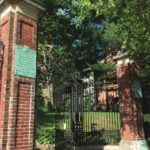 Episode 78: Uncovering African and Native American Lives in 17th – 18th Century Hartford
Episode 78: Uncovering African and Native American Lives in 17th – 18th Century Hartford
30 Minutes. Release date: September 1, 2019
Four hundred years ago, in August 1619, more than 20 kidnapped enslaved African people were sold to the Virginia colonists. Slavery was well established in the early Connecticut Colony too. Traded, sold, given as gifts, and subjected to beatings, as documents attest, the enslaved people of Hartford suffered no less than enslaved people anywhere. In today’s episode, Connecticut Explored’s Mary Donohue finds out about an innovative, model project that uses fine-grained scholarship to uncover the lives of almost 500 African, African American, and Native Americans buried between 1640 and 1815 in Hartford’s oldest historic site, the Ancient Burying Ground. She talks with Dr. Kathy Hermes, professor at Central Connecticut State University, about the project, sponsored by the Ancient Burying Ground Association and about the new website that makes all this research available with a click of a mouse.
For more information, visit www.africannativeburialsct.org. Join us on Sept 12, 2019 at 6 p.m. at the Hartford History Center, Hartford Public Library, 500 Main Street, Hartford for a free lecture by Dr. Hermes, “Uncovering Their History: African, African American and Native Americans Buried in Hartford’s Ancient Burying Ground, 1640-1815” that will launch the website. To learn more about how to research Hartford’s early black community, join Dr. Hermes for a workshop at the Hartford History Center on October 5, 2019 at 11 a.m., which is also free to the public. And come view the exhibition at the Hartford History Center Uncovering the Ancient Burying Ground an exhibition featuring historic photos, maps, drawings, and postcards.
This episode was produced by Mary Donohue, Assistant Publisher of Connecticut Explored, and engineered by Patrick O’Sullivan. Visual art by coramarshall.com.
Read More!
Fall 2019 issue: “Unburying Hartford’s Native and African Family Histories” by Katherine A. Hermes
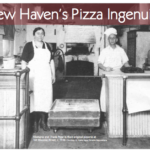
Filomena and Frank Pepe in their original pizzeria at 163 Wooster Street, c. 1930. Courtesy of Frank Pepe Pizzeria Napoletana
Episode 77: The Delicious History of Pizza in New Haven
52 Minutes. Release date: August 15, 2019
Food historian and author of Pizza in New Haven Colin M. Caplin tells State Historian Walt Woodward and co-host Betsy Golden Kellem the fascinating story of the creation and rise to world-class celebrity of New Haven Pizza. Join them at Modern Apizza in New Haven for a lunch-time food and information feast you won’t want to miss.
And at the end, you’ll hear about a special offer that might have you joining Walt, Betsy, and Colin for another podcast lunch and another slice of New Haven Pizza.
Read More!
“New Haven’s Pizza Ingenuity” by Colin Caplin, Summer 2017
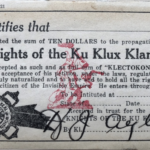 Episode 76: The Rise of the Ku Klux Klan in Connecticut in the 1920s
Episode 76: The Rise of the Ku Klux Klan in Connecticut in the 1920s
19 Minutes. Release date: August 1, 2019
Natalie Belanger of the Connecticut Historical Society takes a walk through the museum’s archival collection of documents related to the Ku Klux Klan. You’ll learn about the Klan’s sudden rise, and rapid fall, in 1920s Connecticut, a dark time when Connecticut was torn by disagreements over immigration policy and the changing demographics of United States.
To learn more, visit CHS’s current exhibition, Black Citizenship in the Age of Jim Crow, on view through September 14, 2019 and join Natalie at the Connecticut Historical Society on September 14, 2019 for a gallery program related to this topic, or visit the CHS’s Research Center anytime to view the Ku Klux Klan documents yourself.
This episode was produced by Natalie Belanger and engineered by Patrick O’Sullivan.
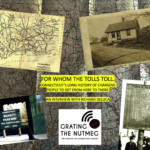 Episode 75: For Whom the Tolls Toll–The History of Toll Roads in Connecticut
Episode 75: For Whom the Tolls Toll–The History of Toll Roads in Connecticut
72 Minutes. Release date: July 15, 2019
State historian Walt Woodward talks with transportation historian Richard DeLuca who takes us on an expert’s tour of Connecticut’s long history of charging people to get from here to there. From turnpikes to bicycle roads, the state highway system to the parkways and toll roads Connecticut got rid of in the 1980s, DeLuca provides the background you need to make good decisions about The Toll Question in Connecticut.DeLuca is the author of POST ROADS AND IRON HORSES and PAVED ROADS AND PUBLIC MONEY, forthcoming from Wesleyan University Press.
Read More!
SPRING 2008 From racetracks to bridges to nowhere, read this issue’s story about Connecticut’s transportation history, including the Meritt Parkway, rollercoasters, ballooning, canals, and more!
Traveling Hartford’s Turnpikes–Then, Now, or Never? A short history of the highway in Connecticut
A Hip Road Trip
Episode 74: 1949 Travel Diary of Beatrice Auerbach with Congresswoman Chase Woodhouse
41 Minutes. Release date: July 1, 2019
Two of Connecticut’s most influential women in the mid-20th century, Beatrice Fox Auerbach, owner of G. Fox, the then-largest privately-owned department store in the United States, and U.S. Congresswoman (second district) Chase Going Woodhouse, a Connecticut College economy professor and the second woman to be elected to the U.S. Congress from Connecticut, spent seven weeks traveling through 10 countries in the Middle East and Europe in 1949. Just four years after the end of WWII and one year after the founding of the new nation of Israel, Auerbach and Woodhouse saw battlefields, refugee camps, and the ruins of German cities. Auerbach’s diary entries reveal what she saw and experienced–civil war in Greece, Arab refugee camps in Transjordan, the value of using Hebrew in Israel, and the fear of rising anti-Semitism and communism in Germany. In this episode, edited from a lecture at the Jewish Historical Society of Greater Hartford, Dr. Tracey Wilson, town historian for West Hartford, comments on Auerbach and Woodhouse’s contribution to the development of women in leadership roles in Connecticut and reads from Auerbach’s travel diaries. Both women are in the Connecticut Women’s Hall of Fame.
Auerbach’s diaries are in the collection of the Connecticut Historical Society, and the papers of Chase Going Woodhouse are in the collection of the Dodd Center, University of Connecticut at Storrs. To hear more about G. Fox Dept Store, listen to Episode 73 of Grating the Nutmeg, “Department Stores, G. Fox and the Black Freedom Movement.”
This episode was produced by Mary Donohue and engineered by Patrick O’Sullivan.
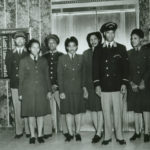 Episode 73: Department Stores, G. Fox, and the Black Freedom Movement
Episode 73: Department Stores, G. Fox, and the Black Freedom Movement
36 minutes. Release Date: June 15, 2019
The Connecticut Historical Society’s summer 2019 exhibition Black Citizenship in the Age of Jim Crow, organized by the New-York Historical Society, explores the struggle for full citizenship and racial equality after the Civil War. Even though northern states like Connecticut did not institute Jim Crow segregation by law, discrimination and segregation were the norm in many public spaces including elegant department stores like New York City’s Macy’s, Bloomingdales, and Hartford’s G. Fox. In this episode UMass professor Dr. Traci Parker, author of Department Stores and the Black Freedom Movement: Workers, Consumers, and Civil Rights from the 1930s to the 1980s (University of North Carolina Press), and host Natalie Belanger talk about what department stores like G. Fox meant to consumers and retail workers alike, and how those stores become sites of struggle in the civil rights movement.
This episode was produced by Natalie Belanger and engineered by Patrick O’Sullivan.
Episode 72: Samson Occom–the Man
58 minutes. Release Date: June 1, 2019
In part two of our commemoration of the 250th Anniversary of the founding of Dartmouth College and its roots in the town of Columbia, Mohegan Elder Beth Regan tells the story of Samson Occom. Occom, a Mohegan who converted to Christianity, was educated by Rev. Eleazar Wheelock, became a teacher and minister, raised much of the money used to establish Dartmouth College, and went on to found the utopian native Christian community of Brothertown, New York. Occom’s story as told by Mohegan elder Regan provides an important perspective on Dartmouth’s founding.
This episode is dedicated to Mohegan Nonner Faith Damon Davison with whom Regan was to give her talk. She was prevented by the onset of an illness that led to her passing a few weeks later. A wise and wonderful person, Davison will be missed by all of us who knew her. –Walter Woodward
Episode 71: Eleazar Wheelock, The Great Awakening, Samson Occom, and the Indian School
1 Hour 12 Minutes. Release Date: May 15, 2019
Recently, alumni of Dartmouth College, members of the Mohegan Nation, the Columbia Historical Society, and state and local officials gathered in the quiet corner town of Columbia to commemorate the 250th anniversary of the founding of that Ivy League institution. Why Columbia? That is where the Great Awakening minister Eleazar Wheelock, inspired by the educational achievements of Mohegan student Samson Occom, founded Moor’s Indian Charity School, the training school for indigenous missionaries that led directly to Wheelock’s founding of Dartmouth College in 1769.
In this episode, following Elder Beth Regan’s Mohegan-language conference invocation, state historian Walt Woodward describes Eleazar Wheelock’s life as a local minister and Great Awakening evangelist, his relationship with Samson Occom, and life at Moor’s Indian Charity School.
Read More!
“A Little Town Begets a Small College,” Summer 2016
 Episode 70: Anni and Josef Albers in Connecticut
Episode 70: Anni and Josef Albers in Connecticut
34 Minutes. Release Date: May 1, 2019
This episode celebrates the 100th anniversary of the most influential design school of the 20th century, the Bauhaus, and Connecticut’s connection to it. Connecticut Explored’s Assistant Publisher Mary Donohue and conceptual artist, photographer and frequent Connecticut Explored contributor Bob Gregson talk about pioneering Modern artists Anni and Josef Albers, who escaped Nazi Germany in the 1930s and made New Haven their home in 1950. It’s a remarkable story. Josef was associated with the Bauhaus for longer than any other artist and Anni was the last surviving teacher from the Bauhaus. Both had independent careers as world famous, influential teachers and artists. Read Bob’s story from the Winter 2017-2019 issue.
We wish to thank Bob Gregson. This episode was hosted and produced by Mary Donohue and engineered by Patrick O’Sullivan.
SPECIAL OFFER FOR GTN LISTENERS! Through May 31, 2019, for just $20, you’ll receive 6 issues for the price of 4 with coupon code GTNSpring19. That’s 2 free issues added to a one-year subscription with coupon code GTNSpring19 when you subscribe by May 31, 2019 at ctexplored.org/shop.
Read More!
“Josef & Anni Albers in Connecticut,” by Robert Gregson, Winter 2018-2019
Episode 69: The Breach: Voices Haunting a New England Mill Town
45 Minutes. Release Date: April 15, 2019
It’s not very often that a historian interviews a poet for a history podcast, but in this episode state historian Walt Woodward interviews award-winning poet, novelist, essayist, environmentalist, and former Deputy Commission of the Connecticut Department of Environmental Protection David K. Leff about his new verse novel, The Breach: Voices Haunting a New England Mill Town (Homebound Books, 2019). The Breach is a fascinating study of decline in a New England factory village caught in the throes of both an economic and an environmental crisis. And – plus, plus, plus – it’s a story told mostly by historical objects. Leff talks about his book, the reasons he lets objects tell the story, and reads some of the entries, too. Warning: Leff’s readings contain a bit of profanity, one violent episode, and a hint of sex.
 Episode 68: Fort Trumbull’s Three Lives
Episode 68: Fort Trumbull’s Three Lives
22 Minutes. Release Date: March 29, 2019
In this podcast cross-over episode, Johnna Kaplan, author of Connecticut Explored’s spring 2019 story about Fort Trumbull in New London, Connecticut is joined by her Going/Steady podcast co-host Kerri Provost. Listen as they dive into the history of Fort Trumbull, a Connecticut state park that’s seen a devastating Revolutionary War battle, witnessed Prohibition-era high-speed boat chases, and housed a top-secret military research facility. Today Fort Trumbull is one of New London’s must-visit attractions, part of the new Thames River Heritage Park.
Thanks to the co-hosts of Going/Steady, Kerri Provost of Real Hartford and Johnna Kaplan of The Size of Connecticut. Listen to Going/Steady podcast at goingsteadyct.com and on iTunes. For more information about the fort, visit ct.gov/deep and fortfriends.org. For more about the summer water taxi and historic attractions go to thamesriverheritagepark.org. This episode was produced by Mary Donohue and engineered by Patrick O’Sullivan.
SPECIAL OFFER FOR GTN LISTENERS! Through May 31, 2019, for just $20, you’ll receive 6 issues for the price of 4 with coupon code GTNSpring19. That’s 2 free issues added to a one-year subscription with coupon code GTNSpring19 when you subscribe by May 31, 2019 at ctexplored.org/shop.
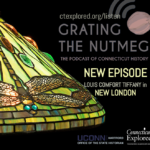 Episode 67: Louis Comfort Tiffany in New London
Episode 67: Louis Comfort Tiffany in New London
38 Minutes. Release Date: March 1, 2019
The story behind this episode started with the high-profile heist in 1991 of a stained-glass window from the 19th century mausoleum of a New London industrialist. The window was designed by world-famous artist Louis Comfort Tiffany. But the thieves hadn’t counted on a persistent detective. Tiffany, best known for his brilliant innovations in glass, had deep Connecticut roots. A new permanent exhibition about his work, including 100 fine- and decorative-arts objects, is now on view at the Lyman Allyn Art Museum in New London. Join host Mary Donohue and curator Tanya Pohrt and museum director Sam Quigley to discover more about Tiffany’s career, his family ties to New London, and his life-long pursuit of beauty.
Read our story about Louis Comfort Tiffany in the Winter 2018-2019 issue online at ctexplored.org. For more information about the Lyman Allyn’s exhibition “Louis Comfort Tiffany in New London” and the Lyman Allyn Art Museum visit lymanallyn.org. To see a fantastic interior designed by Louis Comfort Tiffany and his firm Associated Artists, visit the Mark Twain House & Museum in Hartford.
This episode was hosted and produced by Mary Donohue and engineered by Patrick O’Sullivan with music by Miles Elliot.
SPECIAL OFFER FOR GTN LISTENERS! Through May 31, 2019, for just $20, you’ll receive 6 issues for the price of 4 with coupon code GTNSpring19. That’s 2 free issues added to a one-year subscription with coupon code GTNSpring19 when you subscribe by May 31, 2019 at ctexplored.org/shop.
Episode 66: Sharon Cures–One Small Town of Medical Marvels
38 Minutes. Release Date: February 15, 2019
Recently U.S. News and World report ranked Connecticut 4th best among the 50 states in the quality of our healthcare. We have great research universities and teaching hospitals, and pharma, biotech, and medical engineering companies most states envy. That’s what makes this podcast so surprising. This is the story of how the little Litchfield County hill town of Sharon – with a population of 2,700 people – has produced some of our state’s leading medical innovators. And it’s been doing so for centuries.
Join State Historian Walt Woodward on a visit to the Sharon Historical Society where co-curators Susan Shepard and Marge Smith tell us about the breakthroughs in innoculation, immunotherapy, and gender equity in the medical field pioneered by Sharon residents. It’s part of their exhibition “Sharon Cures: Centuries of Medicine in One Small Town,” on view through April 28, 2019. For more information visit http://sharonhist.org and view images from the exhibition on the Connecticut State Historian’s Facebook Page.
Read More!
More stories about Connecticut’s medical history in
Spring 2004: “An Apple a Day”
Spring 2007 “Bite the Bullet”
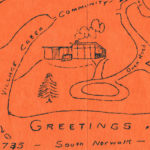 Episode 65: Norwalk’s Village Creek, Ahead of its Time
Episode 65: Norwalk’s Village Creek, Ahead of its Time
30 Minutes. Release Date: February 1, 2019
After World War II, one Connecticut community made a conscious effort to reject racial segregation. The founders of Village Creek in Norwalk created a cooperative neighborhood which promised not to discriminate based on “race, color, creed or politics.” Over the next decades, the Villagers faced criticism from many quarters, but the community survived and thrives today. In this episode, Natalie Belanger and Melica Bloom of the Connecticut Historical Society take a look at the founding of Village Creek, and some of the challenges it faced over the decades.
If you’d like to learn more about the Village Creek Association, visit the Connecticut Historical Society’s Research Center. And visit their special exhibition, “Patios, Pools and the Invention of the American Backyard,” a travelling exhibition by the Smithsonian Institution, on view through February 23, 2019. Find out more at chs.org.
And for more great Connecticut stories, subscribe to Connecticut Explored, the magazine of Connecticut history. The current issue is about our creative history and the upcoming spring issue explores in a surprising variety of stories how important water is to Connecticut’s story. Find out more at ctexplored.org.
We wish to thank Natalie Belanger, CHS Adult Programs Manager, and CHS Exhibit Developer Melica Bloom. This episode was produced by Natalie Belanger and Patrick O’Sullivan. Music on this episode by Miles Elliot @miles_aheadmusic.
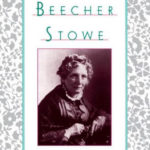 Episode 64: Best Winter History Reads
Episode 64: Best Winter History Reads
58 Minutes. Release Date: January 13, 2019
State Historian Walt Woodward asked five of Connecticut’s leading voices from the history community what their favorite winter history reads are this year. Briann Greenfield of the Harriet Beecher Stowe Center, State Librarian Ken Wiggin, Sally Whipple of the Old State House, Jason Mancini of CTHumanities, and Christina Volpe of the Connecticut League of History Organizations shared the books that are providing them a fascinating escape from bleak midwinter, the 2019 edition.
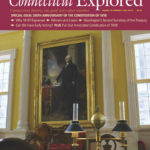 Episode 63: Why the Constitution of 1818 Matters Today
Episode 63: Why the Constitution of 1818 Matters Today
30 Minutes. Release Date: December 18, 2018
This is the fifth in our series of talks presented by Connecticut’s Old State House commemorating the 200th anniversary of Connecticut’s first state constitution.
In this episode judges Henry Cohn and Jon Blue wrap up our discussion of the state’s first constitution in “Why the Constitution of 1818 Matters Today.”
This has been a great series pairing historians and legal scholars. In the first in the series, episode 45, state historian Walt Woodward provides the historian’s view of the broader cultural context that brought us to a state constitutional convention. In this episode, Judge Blue gives us the legal perspective. And in episode 55, Wesleyan University professor emeritus Richard Buel does a deep dive into the political history that led to the constitution.
Also in this episode, Judge Cohn gives a judge’s perspective on the constitution’s Declaration of Rights– in particular what it has to say about our right to a jury trial, freedom of religion, and right to an education. For the historian’s perspective on religion and the constitution, listen to Professor Robert Imholt in episode 59. Finally, legal scholar Wesley Horton describes the constitutional debates in episode 56.
For the whole series, listen to episodes 45, 55, 56, 59, and 63 (see descriptions below).
This episode was produced by Elizabeth Normen and Patrick O’Sullivan.This episode is sponsored by Attorney Peter Bowman. Find out more at bowman.legal.
Read More
Fall 2018 Special Issue: The 200th Anniversary of the Constitution of 1818
Find a list of other related articles HERE
Episode 62: Three Centuries of Christmas at the Webb-Deane-Stevens Museum
30 Minutes. Release Date: December 3, 2019
Charles Lyle, executive director of the Webb-Deane-Stevens Museum in Wethersfield, whets your appetite for a visit to the Webb, Stevens, and Deane houses to see how the holidays were celebrated in three eras: c. 1770, c. 1830, and c. 1930. Find out how, in the 1800s, Clement C. Moore and Thomas Nast created Santa Claus, and the origin of the New Year’s resolution–all in this episode of Grating the Nutmeg!
This episode is sponsored by attorney Peter Bowman, holding distracted drivers accountable for their actions. Find out more at bowman.legal
For more great holiday listening, listen to episode 21 “A Connecticut Christmas Story by Harriet Beecher Stowe,” and episode 11 to learn more about the Webb-Deane-Stevens Museum. This episode was produced by Elizabeth Normen, and Patrick O’Sullivan.
Read more!
“Christmas in Connecticut“, Winter 2010-2011
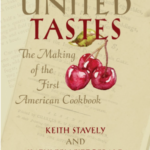 Episode 61:Feasts, Facts, & Fictions: Cooking REAL New England Holiday Foods
Episode 61:Feasts, Facts, & Fictions: Cooking REAL New England Holiday Foods
47 Minutes. Release Date: November 17, 2019
Food historians Keith Staveley and Kathleen Fitzgerald join state historian Walt Woodward at his dinner table in Columbia for a talk about traditional New England holiday foods–authentic and not-so-authentic–and the stories behind them. PLUS, Keith and Kathy brought along 9 truly historic and delicious New England food recipes, translated into modern cooking instructions kitchen–tested for authentic flavor. Whether you want to wow your holiday dinner guests with some astonishing food facts, or cook up a dish or two they’ll be talking about all year, this is your podcast.
AND listen to the special bonus add-on: a live reading of Gov. Samuel Huntington’s 1786 Thanksgiving meditation, recorded at the special Thanksgiving dinner at the Samuel Huntington homestead in Scotland, Connecticut on November 10, 2018. This episode was produced by Walter Woodward.
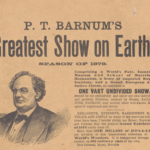 Episode 60: Special CPTV Audio Documentary: The P T Barnum You Never Knew
Episode 60: Special CPTV Audio Documentary: The P T Barnum You Never Knew
46 Minutes. Release Date: November 2, 2018
In this special Connecticut Public Television audio documentary, we tell the story almost no one knows about the other side of PT Barnum. Almost everyone is familiar with Barnum’s extraordinary career as a showman, entrepreneur, and creator of The Greatest Show on Earth, but “Barnum’s Connecticut”, which host Walt Woodward wrote and produced as a companion to CPTV’s broadcast of the American Experience documentary “The Circus” CPTV.org/thecircus shows a side of this world-changing impresario that will challenge anything you think about him right now. Featuring Kathy Maher of Bridgeport’s Barnum Museum and Sally Whipple of Connecticut’s Old State House in Hartford, this is an episode you don’t want to miss.
And to hear the companion episode “Barnum’s Circus” visit the Connecticut Public Television “The Circus” webpage. This episode was produced by Walter Woodward.
 Episode 59: Constitution of 1818 Part 4: Milestone in Church State Relations?
Episode 59: Constitution of 1818 Part 4: Milestone in Church State Relations?
40 Minutes. Release Date: October 15, 2018
This episode, the fourth in our 6-part series commemorating the Constitution of 1818, explores one of the main accomplishments of the state’s first constitution: the separation of church and state. Professor Robert Imholt challenges that assertion, though, arguing that the process to disentangle religion from the state began much earlier. Still, find out how deep our Puritan roots were as the state finally convened to write a state constitution in this episode of Grating the Nutmeg.
This episode was produced by Elizabeth Normen. Thanks to Robert Imholt and Connecticut’s Old State House. This episode is sponsored by Attorney Peter Bowman. Find out more at bowman.legal.
Listen to episodes 45, 55, and 56 for parts 1, 2, and 3 in our 6-part series about the Constitution of 1818.
 Episode 58: Keeping it Clean in World War I
Episode 58: Keeping it Clean in World War I
31 Minutes. Release Date: October 1, 2018
In the 1910s a group of Connecticut reformers formed a society aimed at solving a growing crisis – the spread of venereal diseases. The United States’s entry into WWI provided this so-called “social hygienist” movement with an unprecedented opportunity to influence the sexual mores of Americans. In this episode produced by Connecticut Historical Society’s Natalie Belanger, Natalie tells us how that worked out for these well-intentioned reformers—especially one George P. Thayer, a crusader for clean living that saw a little more in France than he’d bargained for.
This episode is sponsored by Attorney Peter Bowman. Find out more at bowman.legal.
Read more!
Connecticut in World War I at ctexplored.org in the Spring 2017 and Winter 2014/2015 issues.
Listen to these other episodes about World War I
Episode 33: World War I Reenactors Tell All
Episode 28: Connecticut in World War I: Letters from the Front
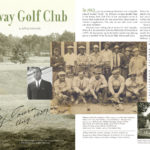 Episode 57: Breaking Golf’s Color Line in Hartford
Episode 57: Breaking Golf’s Color Line in Hartford
34 Minutes. Release Date: September 15, 2018
Hartford native Gerry Peterson played golf with President Barack Obama and was inducted into the Black Golf Hall of Fame in 2015. Golf has always been a huge part of his life from his start as a kid caddie during the Depression to playing as a young executive at Aetna Life and Casualty. But what did it take for Peterson to become a member of the whites-only Keney Park Golf Club in 1963? Gerry Peterson will tell us, and historian Jeffrey Mainville, author of this summer 2018 issue’s story “The Midway Golf Club,” will reveal Hartford’s part in the national struggle to end racial discrimination at municipal golf courses in America.
This episode was produced by Mary Donohue, Asst. Publisher of Connecticut Explored, and engineered by Patrick O’Sullivan, PDO Films. Subscribe at ctexplored.org.
For more stories of struggle and triumph by Connecticut’s African American community, order your copy of our book African American Connecticut Explored, now in paperback, on Amazon.
This episode was sponsored by attorney Peter Bowman, helping the seriously injured and holding distracted drivers accountable for their action. More at bowman.legal. And Connecticut Humanities, co-publisher of Connecticut Explored, the magazine of Connecticut history. Visit cthumanities.org
Episode 5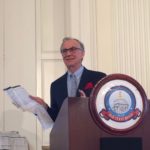 6: Constitution of 1818 Part 3: The Constitution of 1818 Debates
6: Constitution of 1818 Part 3: The Constitution of 1818 Debates
34 Minutes. Release Date: September 1, 2018
Attorney Wesley Horton, president of the Connecticut Supreme Court Historical Society, outlines the main issues of debate as state delegates finally gather to draft a state constitution. What happened inside the convention? How do we know? Find out in this episode of Grating the Nutmeg. This episode was recorded at Connecticut’s Old State House and produced by Elizabeth Normen.
This episode is sponsored by attorney Peter Bowman, holding distracted drivers accountable for their actions. Find out more at bowman.legal. And Connecticut Humanities, co-publisher of Connecticut Explored.
See Episode 45 for Constitution of 1818 Part I: Trouble in the Land of Steady Habits
See Episode 55 for Constitution of 1818 Part 2: The Collapse of Federalist Dominance
Read More!
Buy the special 200th Anniversary of the Constitution of 1818 Fall 2018 issue of Connecticut Explored at ctexplored.org.
Fall 2018: The 200th Anniversary of the Constitution fo 1818
Commemorating the Constitution of 1818: a compendium of resources for exploring this fascinating time in Connecticut history
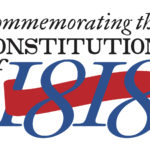 Episode 55: Constitution of 1818 Part 2: The Collapse of the Federalist Dominance
Episode 55: Constitution of 1818 Part 2: The Collapse of the Federalist Dominance
44 Minutes. Release Date: August 29, 2018
Dr. Richard Buel Jr., Professor Emeritus, Wesleyan University, describes the political climate that led to the Constitution of 1818 and how we must look to what was happening in France, and the ongoing conflict between England and France, to understand what was happening here. This episode was produced by Elizabeth Normen.
This episode is sponsored by attorney Peter Bowman, holding distracted drivers accountable for their actions. Find out more at bowman.legal. And Connecticut Humanities, co-publisher of Connecticut Explored.
See Episode 45 for Constitution of 1818 Part I
Read More!
Fall 2018: The 200th Anniversary of the Constitution fo 1818
Commemorating the Constitution of 1818: a compendium of resources for exploring this fascinating time in Connecticut history
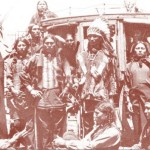 Episode 54 Part I: The Long Journeys Home–Henry ‘Opukaha’ia
Episode 54 Part I: The Long Journeys Home–Henry ‘Opukaha’ia
35 Minutes
Part II: The Long Journeys Home–Albert Afraid-of-Hawk
38 Minutes. Release Date: August 1, 2018
Two young native men: Henry Opukaha’ia, a native of Hawaii, who died in Cornwall, Connecticut in 1818, and Albert Afraid of Hawk, a Lakota Sioux native who died in Danbury in 1900.
Nick Bellantoni was the archaeologist tasked with helping return the remains of each of these men to their homes and families, more than a century after they had died.
Hear him tell their strangely connected and deeply moving stories in this special two part Grating the Nutmeg episode based on Bellantoni’s new Wesleyan University Press book The Long Journeys Home: The Repatriations of Henry ‘Opukaha’ia and Albert Afraid of Hawk.
Read More!
“Rediscovering Albert Afraid-of-Hawk,” Summer 2014
This episode is sponsored by attorney Peter Bowman, holding distracted drivers accountable for their actions. Find out more at bowman.legal. And Connecticut Humanities, copublisher of Connecticut Explored.
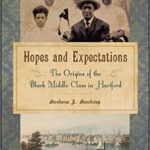 Episode 53: Hopes & Expectations: Creation of a Black Middle Class in Hartford
Episode 53: Hopes & Expectations: Creation of a Black Middle Class in Hartford
1 Hour 5 Minutes. Release Date: July 16, 2018
In an unforgettable interview, historian Dr. Barbara Beeching describes the creation of a black middle class in Hartford – not in the 20th century, but in the 1800s. The story features the Primus family and their letters and other prominent black families. It’s a tale full of insights and surprises – not the least of which is Beeching herself. Beeching’s book, Hopes and Expectations: The Origins of the Black Middle Class in Hartford was published by SUNY Press, 2017.
This episode is sponsored by Attorney Peter Bowman—find out more at bowman.legal, and Connecticut Humanities, co-publisher of Connecticut Explored, visit cthumanities.org.
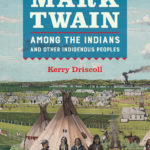 Episode 52: Mark Twain’s Native American Problem
Episode 52: Mark Twain’s Native American Problem
40 Minutes. Release Date: July 1, 2018
In this episode recorded at the Mark Twain House in Hartford, Twain scholar and University of St. Joseph Professor of English Emerita Kerry Driscoll explores one of the last unexamined aspects of American author and humorist Mark Twain. Twain, a resident of Hartford from 1871 to 1891, wrote some of his most beloved works while living in Hartford and was generally known for championing the underdog. But Driscoll unflinchingly reveals here and in her book, Mark Twain Among the Indians and Other Indigenous Peoples, Twain’s blind spot when it came to America’s first peoples.
This episode was produced by Elizabeth Normen. It is sponsored by Attorney Peter Bowman—find out more at bowman.legal, and Connecticut Humanities, co-publisher of Connecticut Explored, visit cthumanities.org.
Episode 51: Greater Hartford’s West Indian Diaspora
63 Minutes. Release Date: June 16, 2018
In 2010, Jamaicans became the largest foreign born population in Connecticut. Jamaicans also have the highest percentage of property ownership in Hartford County of any foreign-born group. How did so many West Indians come to call Connecticut home?
University of Connecticut Associate Professor Fiona Vernal documents this 70-year transformation in her traveling exhibition “Home Away From Home: Greater Hartford’s West Indian Diaspora,” currently on view at Hartford Public Library. HPL’s Jasmin Agusto and I asked Fiona to share this fascinating story. Its a great story told by a natural-born story-teller.
This episode presented by Attorney Peter Bowman, helping the seriously injured and holding distracted drivers accountable for their actions. More at bowman.legal.
And Connecticut Humanities, co-publisher of Connecticut Explored magazine. The episode was produced by Walter Woodward.
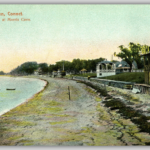 Episode 50: A Seaside Village in the Big City: New Haven’s Morris Cove
Episode 50: A Seaside Village in the Big City: New Haven’s Morris Cove
27 Minutes. Release Date: June 1, 2018
What do you think of when you hear “New Haven?” Yale University’s campus, the New Haven Green, IKEA? In this episode, we’ll take you on a trip to the beach in New Haven! Morris Cove, on the east shore of New Haven Harbor, is a world apart from the rest of New Haven. A sandy beach, an armed attack by the British, a vanished amusement park, and the summer home of the New Haven Museum all come to light in this episode of Grating the Nutmeg.
We’ll hear from Jason Bischoff-Wurstle, director of photo archives and Ed Surato, librarian for the New Haven Museum. They’ll tell you why Morris Cove was called the “Newport of Connecticut.” Learn about one of the most interesting summer day trips in Connecticut, and plan to attend Morris Cove Day on June 9, 2018. Find out more about Morris Cove Day at morriscoveday.wordpress.com For more information about the Pardee-Morris House, visit newhavenmuseum.org.
This episode was hosted and produced by Mary Donohue and engineered by Patrick O’Sullivan. The episode was sponsored by attorney Peter Bowman, helping the seriously injured and holding distracted drivers accountable for their actions. More at bowman.legal. And Connecticut Humanities, co-publisher of Connecticut Explored magazine. Visit cthumanities.org.
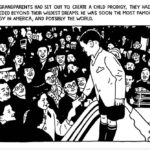 Episode 49: The Professor’s Secret Life
Episode 49: The Professor’s Secret Life
48 Minutes. Release Date: May 15, 2018
All the time Joel Kupperman was a soft spoken, distinguished philosophy professor at the University of Connecticut, he carried a secret he discussed with no one – not even his family. That secret? That he had once been America’s greatest child radio and tv star. He was so popular J. D. Salinger, Philip Roth, Nora Ephron, and the poet William Friedman wrote about him. Now, as he slips into dementia, his son, the award-winning graphic novelist Michael Kupperman, has created a graphic memoir about his father’s hidden past. All the Answers uncovers Joel Kupperman’s life as a Quiz Kid, and the cost that being the most popular child celebrity in America inflicted, not just on Joel, but on his whole family. At the end, we’ll tell you how to enter to win a free copy of the book.
This episode presented by Attorney Peter Bowman, helping the seriously injured and holding distracted drivers accountable for their actions. More at bowman.legal. And Connecticut Humanities, co-publisher of Connecticut Explored magazine. Visit cthumanities.org.
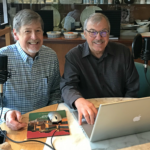 Episode 48: Mid-Century Modern in Connecticut
Episode 48: Mid-Century Modern in Connecticut
38 Minutes. Release Date: May 1, 2018
A group of architects known as the Harvard Five made their mark on New Canaan, Connecticut—a suburb within commuting distance of New York City—designing and building there some of the most influential and significant examples of Mid-century Modern architecture in the country. Today you can visit Philip Johnson’s Glass House, now a museum operated by the National Trust for Historic Preservation.
But stellar Modern architecture can be found in other Connecticut towns, too, commissioned by sophisticated clients including homeowners, mayors, and factory owners. Long-time architecture fans Robert Gregson and Peter Swanson take listeners to Hartford, New Haven, and Litchfield to discover some of the state’s other Modernist landmarks.
Every wonder what that big concrete building in front of Ikea in New Haven was? Find out in this episode. If you thought all there was to Connecticut was Colonial homes, this will change your mind!
See photos that go with the podcast HERE.
This episode presented by Attorney Peter Bowman, helping the seriously injured and holding distracted drivers accountable for their actions. More at bowman.legal.
And Connecticut Humanities, co-publisher of Connecticut Explored magazine. Episode produced by Mary Donohue and engineered by Patrick O’Sullivan. Visit ctexplored.org
Read More!
See Connecticut Explored, Winter 2009-2010
including Bob Gregson’s “Modernism in Connecticut”
“Philip Johnson in His Own Words”
“Jens Risom: The Answer is Risom!” by Mary Dunne
“Modern in Manchester,” by Mary Dunne
“Discovering LaGardo Tackett” By Peter Swanson, Winter 2010-2011
“Destination: Ingalls Rink and the Yale Bowl” By Patrick Pinnell, Fall 2009
Subscribe or buy these back issues at ctexplored.org/shop
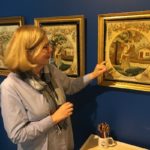 Episode 47: A Field Trip to the Litchfield Historical Society
Episode 47: A Field Trip to the Litchfield Historical Society
38 Minutes. Release Date: April 15, 2018
It was home to America’s first law school and to one of the first schools in which a woman could get a real education. Litchfield today is one of Connecticut’s prettiest towns. Join state historian Walt Woodward on a field trip to the Litchfield Historical Society, where Executive Director Cathy Fields talks about her amazing institution and it’s two brand new exhibits – one about Sarah Pierce’s Litchfield Female Academy and another about expressions of sorrow and mourning in the early 1800s.
This episode was sponsored by attorney Peter Bowman, helping the seriously injured, and holding distracted drivers accountable for their actions. More at bowman.legal.
Listen:
Hear more about Litchfield and the law school in Episode 15
Read:
“The Influence of the Litchfield Law School,” Fall 2016
“Litchfield’s Fortunes Hitched to the Stage Coach,” Spring 2008
“Flying the Banner for Temperance,” Winter 2008
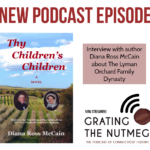 Episode 46: Staying on the Land: Five Generations of Connecticut Pioneers
Episode 46: Staying on the Land: Five Generations of Connecticut Pioneers
31 Minutes. Release Date: April 2, 2018
Political unrest, religious dissension, women’s rights, and mental health–stories from today’s news? All this happens in Thy Children’s Children by historian and first-time novelist Diana McCain. It’s the story of a real family, the Lymans of Middlefield, in the thick of Connecticut and American history for more than a century. Hear how McCain wove decades of research into a compelling historical novel.
Music on this episode by Henrik Andersson. Hosted by Mary Donohue and produced by PDO Media.
This episode was sponsored by attorney Peter Bowman, helping the seriously injured, and holding distracted drivers accountable for their actions. More at bowman.legal.
Listen to Episode 9 for more about the story of the Lyman family: “Lyman Orchards Turns 275”
 Episode 45: Trouble in the Land of Steady Habits
Episode 45: Trouble in the Land of Steady Habits
49 Minutes. Release Date: March 15, 2018
On the 200th anniversary of the creation of the state Constitution of 1818, we remember one of Connecticut’s least well known but most important events. Hear State Historian Walter Woodward’s Old State House talk about what led to the state’s first constitutional convention, and all that the resulting document did and didn’t do.
Read More!
Buy the special 200th Anniversary of the Constitution of 1818 Fall 2018 issue of Connecticut Explored at ctexplored.org.
Fall 2018: The 200th Anniversary of the Constitution fo 1818
Commemorating the Constitution of 1818: a compendium of resources for exploring this fascinating time in Connecticut history
Read stories from our Fall 2012 “Is this the Land of Steady Habits?” issue
The “Notorious Hartford” Convention of late 1814/early 1815
Reflections on the1965 Constitution Convention
Episode 44: The Amazing Story Behind America’s First Cookbook
57 Minutes. Release Date: February 20, 2018
When Hartford History Center’s Brenda Miller suggested Walt Woodward co-host a podcast with the authors of a new book about America’s first cookbook–published in Hartford in 1796, Woodward thought a culinary episode might be a nice change of pace. What they found, though, was that authors Keith Staveley and Kathleen Fitzgerald have not only written an extraordinary history of Amelia Simmons’s American Cookery, they’ve also written one of the best books about Connecticut history in a generation.
Read more:
America’s First Cookbook, Spring 2006. Read more stories about Connecticut food history in the issue and in
Summer 2017: “We Are What We Eat” with stories about oystering, hops growing, New Haven pizza, and more!
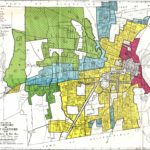 Episode 43:The Challenge of Fair Housing in Connecticut’s Suburbs
Episode 43:The Challenge of Fair Housing in Connecticut’s Suburbs
39 Minutes. Release Date: January 21, 2018
After World War II Americans moved out of the cities and into the suburbs in droves looking for single-family homes. In this episode, we talk with the experts about Connecticut’s history of steering certain people to certain neighborhoods through restrictive covenants, racial and religious discrimination, and federal housing policies—all of which helped determine where African American and Jewish homebuyers could purchase homes.
Using West Hartford as an example, learn what some common real estate terms really mean—“redlining,” steering, and exclusionary zoning—and how they affected West Hartford’s neighborhoods. Please note that this episode contains outdated language used in historical context.
View Trinity College’s Dr. Jack Dougherty’s accompanying presentation at http://bit.ly/2017-11-02 and also visit his online book On The Line: How Schooling, Housing, and Civil Rights Shaped Hartford and its Suburbs at OnTheLine.trincoll.edu.
Get all the historic preservation and architecture stories that matter to you! Get all five historic preservation back issues in a Collection at a special value price! Great reading on a snowy day or on a sunny beach. You can even put together your own collection by choosing the back issues you want to read!
Episode 42: Treasures of the Watkinson
50 Minutes: Release Date: January 2, 2018
It’s a brand new year, and what better way to start 2018 than with a treasure hunt? Join Brenda Miller, Executive Director of the History Center at Hartford Public Library, and State Historian Walt Woodward as they explore the treasures of the Watkinson Library at Trinity College with curator Rick Ring. It’s mission is to be open to all, so listen and then visit!
Episode 41: Have Archaeologists Found Connecticut’s Jamestown?
55 Minutes. Release Date: November 23, 2017
Archaeologists working at Wethersfield’s Webb-Dean-Stevens Museum recently found something completely unexpected: signs of a 17th century palisade adjacent to the historic house where General George Washington met with French Count Rochambeau to plan the campaign that won the American Revolution. Along with evidence of a defensive wall, they also found artifacts dating to the 1637 Pequot War which Connecticut declared after a Wangunk-Pequot attack on Wethersfield left 9 people dead. Is this fort–as archeologist Ross Harper posits–possibly Connecticut’s Jamestown?
Join state historian Walt Woodward and Wethersfield residents at the Webb-Deane Stevens museum as the archaeologists provide a surface-to-paydirt–20th to 17th century–description of what they’ve found so far.
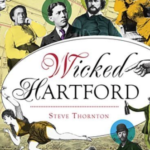 Episode 40: Wicked Hartford
Episode 40: Wicked Hartford
47 Minutes. Release Date: November 10, 2017
Conniving bosses, predatory slumlords, greedy industrialists and political intrigue abound in Steve Thornton’s latest history book, Wicked Hartford—but his take on this universal topic is not quite what you’d expect. Hear Steve tell us about the fascinating stories in “wicked” Hartford history.
Music by Hartford jazz artist Orice Jenkins from the album ‘SOAR’ available on iTunes now.
Connecticut Explored is celebrating its 15th anniversary—and we’ve got a special offer for new subscribers. Subscribe before December 31, 2017 and receive 6 issues for the price of 4. Use coupon code “Nutmeg” when you subscribe at ctexplored.org/shop.
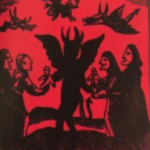 Episode 39 Parts I, II, III: Connecticut–New England’s Other Witch Hunt
Episode 39 Parts I, II, III: Connecticut–New England’s Other Witch Hunt
Release Date: October 26, 2017
Part I 40 min; Part II 42 min; Part III 1 hr. 40 min
Few people know that long before Salem’s witch trials in 1692, Connecticut had its own witch trials. In this special 3-part series, we investigate the surprising story of witchcraft in colonial Connecticut. Why did Connecticut execute New England’s first witch? Why was it early New England’s fiercest prosecutor of witches (Who knew?) And how did European witch-hunting affect the same practice in New England?
Part I: Walt Woodward talks about the European witchcraft tradition from witch Connecticut’s witch hunts were derived.
Part II: Woodward tells the sobering tale of Connecticut’s roll in New England witch-hunting, from executing the first witch, to the Hartford Witch hunts of the 1660s, to the trial of Katherine Harrison, arguably the most important witchcraft trial to take place before Salem.
Part III: Brenda Miller, Executive Director of the Hartford History Center at Hartford Public Library, and Walt Woodward interview historian Richard Ross about his new book, Before Salem: Witch- the Connecticut River Valley 1647-1663. Ross’s historical spadework provides many new insights into one of Connecticut’s most important, and least well known, events.
Read more:
Accused! Fairfield’s Witchcraft Trial–a graphic novel excerpt
Wethersfield’s Witch Trials
Episode 38: Talkin’ About the 9/11 Generation
28 Minutes. Release Date: October 4, 2017
Are you a member of the 9/11 generation? Do you wonder how 9/11 and its aftermath affected kids who witnessed the terrorist attack on the U.S. 16 years ago? In this episode CCSU history professor Matt Warshauer explores the 9/11 generation and wonders about the next generation who will have no emotional connection to it—in 2017 half of high school students were born after 9/11. As Warshauer notes, this is history still in the making.
We thank Matt Warshauer, Diane Smith, Bilal Sekou, Avery Eddy, Patrick O’Sullivan, Avon Public Library, and The Old State house with audio courtesy of CT-N, the Connecticut Network. Episode produced by Elizabeth Normen.
Read More:
Stories about how Connecticut has responded to disasters, including 9/11, published on the 10th anniversary of 9/11. Fall 2011
Watch the Connecticut Old State House’s Conversations at Noon featuring Matt Warshauer, Bilal Sekou, and Christine Pittsley.
Episode 37: A 400-Year Old Boat, A Sea Serpent, & A Murmuration of Swallows
41 Minutes. Release Date: September 18, 2017
Come along with state historian Walt Woodward on a Connecticut River Museum sunset excursion about the Onrust, a replica of Adriaen Block’s ship, the first European boat to enter the Connecticut River, with a teller of tall tales, and some very talented young artists–in search of a few million swallows.
Thanks to the Connecticut River Museum. Sail on the Onrust through October 14 2017 and again in the spring, visit ctrivermuseum.org for more information.
Read related story:
“Why Connecticut Didn’t Go Dutch,” Summer 2014
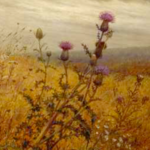 Episode 36: Fidelia Bridges’s Connection to Old Lyme & A Ride on the Air Line Trail
Episode 36: Fidelia Bridges’s Connection to Old Lyme & A Ride on the Air Line Trail
33 Minutes. Release Date: August 30, 2017
Two stories from eastern Connecticut: a Ride on the Air Line State Park Trail, a rail trail with history, and the story of artist Fidelia Bridges and her newly discovered connection to Old Lyme. Featuring Carolyn Wakeman and Jenny Parsons of the Florence Griswold Museum and its summer 2017 exhibition, Flora/Fauna: The Naturalist Impulse in American Art, on view through September 17, 2017.
Read related stories and see images:
“Desination: The Lyman Viaduct,” Summer 2008
Florence Griswold Museum’s History Blog
Thanks to Carolyn Wakeman, Jenny Parsons, and the Florence Griswold Museum.
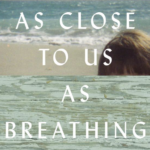 Episode 35: Bagel Beach and Jewish Vacationers at the Connecticut Shore
Episode 35: Bagel Beach and Jewish Vacationers at the Connecticut Shore
31 Minutes. Release Date: August 16, 2017
Listen to a recent book talk by author Elizabeth Poliner whose novel As Close to Us as Breathing (Little, Brown, 2016) takes us to the 1940s when Connecticut’s beach colonies were segregated by ethnicity and religion. Poliner masterfully weaves the story of a multi-generational Jewish family and a fatal accident in 1948, all set in “Bagel Beach,” a real Jewish beach colony in Milford, Connecticut. We also visit the Hebrew Congregation of Woodmont–the state’s only synagogue built as a summer synagogue. You’ll be inspired to read this evocative novel and take a drive along CT’s shoreline to catch a glimpse of its early beach colonies in this episode of Grating the Nutmeg.
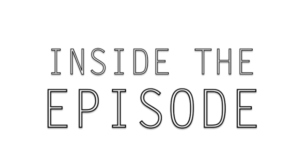 Thanks to author Elizabeth Poliner, the Jewish Historical Society of Greater Hartford, the Bagel Beach Historical Association and the Hebrew Congregation of Woodmont. This episode was produced by Mary Donohue and Patrick O’Sullivan.
Thanks to author Elizabeth Poliner, the Jewish Historical Society of Greater Hartford, the Bagel Beach Historical Association and the Hebrew Congregation of Woodmont. This episode was produced by Mary Donohue and Patrick O’Sullivan.
PLUS Watch INSIDE THE EPISODE Video:
Visit Bagel Beach
Episode 34: Caroline Ferriday Inspires a Bestseller
27 Minutes. Release Date: July 28, 2017
Listen to the compelling story of Caroline Ferriday–and how she inspired a New York Times bestselling historical novel. Ferriday’s summer home, the Bellamy-Ferriday House in Bethlehem, Connecticut, recently hosted hundred of fans who came out to hear Martha Hall Kelly tell how she was inspired by a visit there to write her novel.
You’ll be inspired to put a visit to Connecticut Landmarks’s Bellamy Ferriday House on your bucket list of things to do this summer–in this episode of Grating the Nutmeg.
Thanks to Connecticut Landmarks, Martha Hall Kelly, and Stacey Fitzgerald. This episode was produced by Elizabeth Normen and Patrick O’Sullivan.
READ MORE:
Caroline Ferriday: A Godmother to Ravensbruck Survivors
Episode 33: World War I Reenactors Tell All
45 Minutes. Release Date: July 11, 2017
Hear three extraordinary World War I reenactors talk about what they do, why they do it, and what it all means. You’ll go for a ride in a WWI ambulance, too. And, you’ll meet Gayle Hall, who brought photos of her grandfather and his World War I medals to share with the State Library’s NEH funded World War I digitization project.
View some great images, too, many courtesy of historian/photographer Donald Rogers, from the recent World War I weekend at the historic Waldo House in Scotland, CT (where we recorded these interviews) on the Connecticut State Historian Facebook Page.
READ MORE:
Spring 2017: 100th Anniversary of World War I, Part II
Winter 2014-2015: Connecticut in the Great War, Part I
LISTEN–More Episodes about World War I:
Episode 28: Connecticut in World War I: Letters from the Front
Episode 25: On to Mexico: The Connecticut National Guard
Episode 24: “The Conquest of America,” A WWI Cautionary Tale
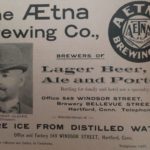 Episode 32: Hops, Beer, and Hartford’s 1902 Brewery Strike
Episode 32: Hops, Beer, and Hartford’s 1902 Brewery Strike
54 Minutes. Release Date: June 27, 2017
Beer–that great cold drink! In 1902, Hartford’s brewers went on strike. Find out what happened, explore the resurgence of hops growing in Connecticut, and visit the Hog River Brewery, one of the state’s newest craft breweries.
We wish to thank Steve Thornton, Dr. James LaMondia, Dr. Katja Mauer, Ben Braddock, and the CT Agricultural Experiment Station. Music courtesy of Klokwize and Angela Luna, on iTunes now. This episode was produced by Mary Donohue and Patrick O’Sullivan.
READ MORE: Summer 2017
PLUS Watch INSIDE THE EPISODE Videos
What Does a Hopyard Look Like?
A Visit to the Hog River Brewery
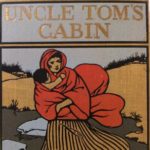 Episode 31: The NEW Harriet Beecher Stowe Center
Episode 31: The NEW Harriet Beecher Stowe Center
27 Minutes. Release Date: June 7, 2017
The Harriet Beecher Stowe Center—one of our nation’s most important historic sites—has a fresh take on the house tour and a freshly renovated interior. Find out why you should visit this summer—plus a stroll through their historic garden and the award-winning plants you’ll find there, including a national champion Paw Paw tree!
We wish to thank Katherine Kane, Judith Lohman, Beth Burgess, and the Harriet Beecher Stowe Center. This episode was produced by Elizabeth Normen and Sarajane Cedrone.
Read more at ctexplored.org where you’ll find several stories on Stowe including “The Most Famous American,” “Lincoln and the Key to ‘Uncle Tom’s Cabin’,” and
READ MORE:
Harriet Beecher Stowe: The Most Famous American by Katherine Kane
Hartford’s Nook Farm: Where Mr. Twain and Mrs. Stowe Built Their Dream Houses by Elizabeth Normen
Lincoln and the Key to ‘Uncle Tom’s Cabin,’ by Katherine Kane
Uncle Tom’s Cabin: Must Read Book’ is 160 Years Old by Walt Woodward
Episode 30: Part I: P. T. Barnum and The Art of Money Getting
30 Minutes. Release Date: May 9, 2017
Part II: P. T. Barnum and The Art of Money Getting–the First 10 (of 20) Rules
43 Minutes. Release Date: May 12, 2017
Part III: P. T. Barnum and the Art of Money Getting–Rules 11 – 20
34 Minutes. Release Date: May 27, 2017
This month, the “Greatest Show on Earth” folds its tent after a run of 146 years. To commemorate, we’re honoring “The Greatest Showman on Earth,” P T Barnum, with a look back at his life, and a full reading of his still so useful book, THE ART OF MONEY GETTING. His 20 rules for achieving success and attaining wealth are still as sound as when he first wrote them back in 1858. And no wonder, because as Kathy Maher, Executive Director of the Barnum Museum in Bridgeport says, Barnum was not only America’s first entertainment mega-mogul, he was the nation’s second millionaire. Consider it a get rich quick theme in three parts, yours for free on Grating the Nutmeg.
 Episode 29: Art, Agency, Legacy: 30 Years of The Amistad Center for Art & Culture
Episode 29: Art, Agency, Legacy: 30 Years of The Amistad Center for Art & Culture
31 Minutes. Release Date: April 24, 2017
The Amistad Center for Art & Culture in Hartford, which documents the history and art of people of African descent in America, celebrates its 30th anniversary this year. Connecticut Explored’s Elizabeth Normen talks with executive director Frank Mitchell about the center’s history and takes you on a tour of its special exhibition “30 for 30: Art, Agency, Legacy” on view at The Amistad Center through the Fall 2017.
The episode features music by Connecticut-based Self Suffice, the RapOet. Find Self Suffice’s music on iTunes and on Facebook.
Watch for Frank’s story in the Fall 2017 issue! We wish to thank Frank Mitchell and The Amistad Center for Art & Culture, and Self Suffice, the RapOet. This episode was produced by Elizabeth Normen and Patrick O’Sullivan.
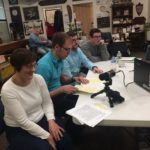 Episode 28: Connecticut in World War I: Letters from the Front
Episode 28: Connecticut in World War I: Letters from the Front
34 Minutes. Release Date: April 5, 2017
With equal doses of wit and bravado, hear the stories of New Britain’s Stanley Works employees serving in France with World War I-era music recorded from the original records in the collection of Henry Arneth.
We wish to thank Karen Hudkins and Andrea Kulak from the New Britain Industrial Museum, Henry Arneth, and CCSU students Jacob Carey, Joe Guerrera, and Ryan Paolino. This episode was produced by Elizabeth Normen and Patrick O’Sullivan.
For more Connecticut in World War I:
Episode 25: On to Mexico: The Connecticut National Guard
Episode 24: “The Conquest of America,” A WWI Cautionary Tale
READ MORE:
Connecticut in World War I, Part II, Spring 2017
Connecticut in the Great War, Winter 2014/2015
 Episode 27: Sam Colt Mines the West
Episode 27: Sam Colt Mines the West
38 Minutes. Release Date: March 21, 2017
Central Connecticut State University history professor Leah Glaser retells the story of Sam Colt’s investment in the Sonora Exploring and Mining Company in the 1850s, a company that was incorporated in Cincinnati, Ohio to exploit silver mines in the new Arizona Territory. Colt never set foot in Arizona but that didn’t mean he didn’t pour energy, money, and firearms into making the venture a success. Unfortunately, the Apache, the Civil War, and myriad other challenges came into play.
Recorded February 28, 2017 at the University of Hartford as part of the Presidents’ College and Connecticut Explored’s “Connecticans in the American West” lecture series. Produced by Elizabeth Normen and Patrick O’Sullivan.
Read the Story: Sam Colt Mines the Arizona Territory
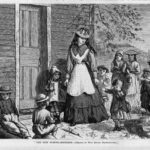 Episode 26: Catharine Beecher Educates the West
Episode 26: Catharine Beecher Educates the West
44 Minutes. Release Date: March 8, 2017
What was it like when a young schoolteacher from Connecticut arrived to teach in a rough frontier school in 1850? Find out in this podcast by Eastern Connecticut State University English professor Allison Speicher. Speicher tells us about why the famous Catharine Beecher, sister of Harriet Beecher Stowe, was so driven to send New England school teachers to the west—and what those teachers found when they arrived.
This talk was recorded February 21, 2017 at the University of Hartford as part of the Presidents’ College and Connecticut Explored’s “Connecticans in the American West” lecture series. The episode was produced by Elizabeth Normen and Patrick O’Sullivan.
Read the Story: Catharine Beecher Educates the West
Episode 25: On to Mexico: The Connecticut National Guard
35 Minutes. Release Date: February 24, 2017
Museum of Connecticut History curator Dave Corrigan tells the forgotten story of the Connecticut National Guard’s service on the Mexican border in 1916—the first test of these young soldiers in a hostile environment before they shipped out to France six months later.
Part of our Commemorating World War I coverage. Recorded February 14, 2017 at the University of Hartford, part of the three-part Presidents’ College Lecture Series “Connecticans in the American West,” organized in collaboration with Connecticut Explored’s Winter 2016-2017 issue on that theme. Produced by Elizabeth Normen and Patrick O’Sullivan.
Watch for the other two lectures in that series in future episodes of Grating the Nutmeg.
READ MORE: Spring 2017
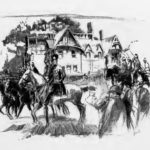
“The Crown Prince occupies the Mark Twain House,” illustration from “The Conquest of America,” Charles Moffatt, 1916
Episode 24: “The Conquest of America,” A WWI Cautionary Tale
40 Minutes. Release Date: February 2, 2017
This spring, Americans will commemorate the 100th anniversary of the United States entry into World War I–including with CT Explored’s Spring 2017 issue. To whet your appetite for some of the surprising stories ahead, state historian Walt Woodward retells war correspondent Cleveland Moffett’s cautionary tale from 1915 of an imagined “German invasion of Connecticut.” It was serialized in the national magazine McClure’s, and released in book form as The Conquest of America in 1916.
See illustrations from the book here, and download the entire book in .pdf form here.
Episode 23: The Great American Road Trip!
35 Minutes. Release Date: January 12, 2017
A celebration of the adventure, fun, and excitement of a road trip along the byways and back roads of America. Featuring the stories of the diners, motels, gas stations, and roadside amusements that are featured in Road Trip!, the New Haven Museum’s exhibition on view through June 15, 2017.
Visit ctexplored.org/shack-attack/ for photos and more information on Connecticut’s roadside eateries, and listen to episode 10, “Poets & Patriots in Stonington,” for our visit to the Sea Swirl in Mystic.
This historic preservation story is supported in part by Connecticut Humanities.
READ MORE:
A Hip Road Trip, Winter 2009/2010
Lunch Wagon to Space Age Diner: Connecticut’s First Fast Food Emporiums, Spring 2006
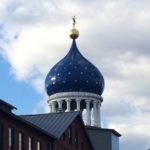 Episode 22: The Smithsonian’s Eric Hintz–Hartford as a Place of Invention
Episode 22: The Smithsonian’s Eric Hintz–Hartford as a Place of Invention
37 Minutes. Release Date: December 27, 2016
The Smithsonian’s Eric Hintz reveals why he featured Hartford as one of six places of invention in a special exhibition at the National Museum of American History in Washington D.C. Find out how Samuel Colt, Elisha Root, and Mark Twain figure into the story and the ingredients he’s discovered that mark Connecticut as a standout place of invention in the late-19th century. Thank you to Eric Hintz and the Smithsonian’s Lemelson Center for the Study of Invention and Innovation, and Jody Blankenship and the Connecticut Historical Society. This episode was produced by Elizabeth Normen and Patrick O’Sullivan.
PLUS: Episode 19’s interview with Connecticut Historical Society curator Ilene Frank about “Connecticut Innovates!,” on view through March 25, 2017.
READ MORE:
Sikorsky: Still Revolutionary, Spring 2014
Pepperidge Farm, Winter 2015/2016
Peter Paul, Spring 2010
Bigelow Tea, Winter 2015/2016
Pratt & Whitney, Spring 2005
Kaman, Fall 2008
International Silver, Winter 2015/2016
“The Miracle on Capital Avenue” Spring 2004
Buy “The Connecticut Brand” Collection: 6 issues full of stories on Connecticut’s history of innovation, just $35. Makes a great gift!
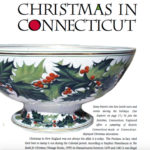 Episode 21: Holiday Episode 2: A Connecticut Christmas Story
Episode 21: Holiday Episode 2: A Connecticut Christmas Story
33 Minutes. Release Date: December 1, 2016
Celebrate Christmas in Connecticut with two stories: from Harriet Beecher Stowe and the Mark Twain House. Featuring music from Duke Ellington’s Suite from the Nutcracker Ballet performed by the New England Jazz Ensemble.
Our preservation story about the restoration of the Mark Twain House’s Mahogany Suite is brought to you by Connecticut Humanities. Special thanks to Beth Burgess of the Harriet Beecher Stowe Center, Tracy Brindle of the Mark Twain House, and the New England Jazz Ensemble. For more information on the New England Jazz Ensemble, visit neje.org.
READ MORE:
“Christmas in Connecticut,” Winter 2010/2011
Episode 20: Holiday Episode 1: Soup and Stories
52 Minutes. Release Date: November 26, 2016
What do the Shroud of Turin, a beer-drinking donkey, a walking catfish, Farmall tractors, the Blizzard of 1888, spooky houses, and the songs from the Wizard of Oz have to do with the little towns of Lebanon and Columbia? In this, the first of 2 special holiday episodes, we celebrate one of the best things about the holiday season–the stories people share with each other. We journey to Connecticut’s Quiet Corner, where residents of the towns of Columbia and Lebanon met together on an evening in early November to share soup, dessert, and stories.
Thanks to Donna Baron, Justin Holbrook, Rick Kane, Andrea Stannard, Alicia Lamb, Marge Nicholls, Ed Tillman, Belle Robinson, and ALL the amazing story tellers who made this night so fun and memorable.
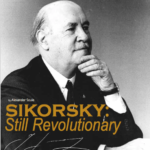 Episode 19: Connecticut Innovates!
Episode 19: Connecticut Innovates!
20 Minutes. Release Date: November 16, 2016
What does it take to be considered innovative? What is Connecticut’s history of innovation? Find out with this interview with Connecticut Historical Society curator Ilene Frank and exhibit designer Jordan Klein about their new exhibition “Connecticut Innovates!” on view November 11, 2016 to March 25, 2017.
READ MORE:
Sikorsky: Still Revolutionary, Spring 2014
Pepperidge Farm, Winter 2015/2016
Peter Paul, Spring 2010
Bigelow Tea, Winter 2015/2016
Pratt & Whitney, Spring 2005
Kaman, Fall 2008
International Silver, Winter 2015/2016
“The Miracle on Capital Avenue” Spring 2004
Buy “The Connecticut Brand” Collection: 6 issues full of stories on Connecticut’s history of innovation, just $35. Makes a great gift!
Episode 18: Governor John Dempsey, Son of Cahir
43 Minutes. Release Date: November 2, 2016
John Dempsey, governor from 1961 to 1971, was one of the most popular–and effective–governors Connecticut ever had, according to state historian Walt Woodward. Born in Ireland in 1916, he was the first immigrant governor of Connecticut since the colonial era. During his administration Connecticut was completely transformed from one of the most tight-fisted American states to one of the most socially responsible. Based on a talk Woodward gave in Ireland in 2015, Dempsey’s remarkable achievements, and how both his character and his policies were shaped by his boyhood in Cahir, Ireland, are revealed.
A Grating the Nutmeg First:
Click here to watch on Youtube with slides
READ MORE:
Dempsey was executive secretary and lieutenant governor to Governor Abraham Ribicoff and then succeeded him in office. Read more about Ribicoff and Connecticut political history:
“Abraham Ribicoff Turns Connecticut Blue,” Spring 2016
Spring 2016 and Fall 2004: stories of Connecticut’s political history
Episode 17: A Pirate’s Tale and Visit to Old New-Gate Prison
47 Minutes. Release Date: October 14, 2016
Hear about Ruth Duncan’s shocking discovery of her great great grandfather’s connection to the notorious pirate William Gibbs and about who’s clamored to get into—and escape from—Old New-Gate Prison over the last 240 years. After six years of a stabilization project, the popular historic site is on the verge of reopening to the public with an open house on October 22, 2016.
Featuring: Ruth Duncan, Christopher Shields of the Greenwich Historical Society, Jack Shannahan, Rep. Tami Zawistowski, Sophie Huget.
READ MORE:
“The Pirate’s Pericardium?,” Fall 2016
“Escape from New-Gate Prison,” Summer 2006
Episode 16: Drinking in History at the Noah Webster House
21 Minutes. Release Date: October 4, 2016
Some people say that young people these days just aren’t that interested in history museums. Don’t tell that to the Noah Webster House in West Hartford, which has found a way to attract hundreds of twenty-and-thirty-somethings to drink in history at the birthplace of the man who helped define early America.
See also Episode 4: Winter 2015-2016–Connecticut Clocks and American Words (below)
Episode 15: What’s It All About: The Law and Order Edition!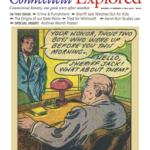 34 Minutes. Release Date: September 15, 2016
34 Minutes. Release Date: September 15, 2016
Was the oldest person executed under Connecticut’s now-abolished capital punishment law given a fair trial? Where did an enterprising young man find the best law school in the early years of the new nation? (hint: it wasn’t New Haven) Find out about these and others stories about crime and punishment in Connecticut from the Fall 2016 issue of Connecticut Explored.
Guests: Johnna Kaplan, author of “The Mysterious Case of Gershom Marx,” and Cathy Fields, executive director of the Litchfield Historical Society: Hosts: Elizabeth Normen and Jennifer LaRue
Get the issue! Fall 2016
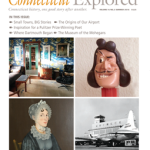 Episode 14: Before BDL: Bradley Field and Eugene Bradley
Episode 14: Before BDL: Bradley Field and Eugene Bradley
41 Minutes. Release Date: September 6, 2016
What’s the history of Bradley International Airport and why is it named for someone from Oklahoma? Is it time to change the name? On the 75th anniversary of Bradley Field (almost to the day) CT Explored’s Elizabeth Normen spoke with Jerry Roberts of the New England Air Museum about the past, present, and future of Connecticut’s international airport and air museum. The last of our episodes from the Summer 2016 issue “Small Towns, BIG Stories.”
READ MORE:
Windsor Locks: Bradley International Airport
Preserving Connecticut’s Aeronautical History
Sikorsky: Still Revolutionary
Frederick Rentschler: The Sky’s the Limit
The Rise and Fall of Balloonist Silas Brooks
Episode 13: Discovery: Connecticut’s Most Important Dig Ever
42 Minutes. Release Date: August 23, 2016
Take an earwitness journey to the 1659 John Hollister homesite on the Connecticut River in ancient Wethersfield, and join the archaeologists, graduate students, and volunteers from many walks of life as they uncover one of the richest early colonial sites ever found in Connecticut.
Accompany State historian Walter Woodward on the last day of the dig for a first-hand account of what they’re finding, and what it means for understanding our early history. Hear from State archeologist Brian Jones, Lori Kissel, Scot Brady, Glenda Rose, Dick Hughes, Fiona Jones, Mandy Ranslow (president of FOSA – Friends of the Office of State Archaeology) and others about their epic archeological adventure.
SEE PHOTOS HERE
READ MORE:
Summer 2014: History Underground
“Waste Not, Want Not: What a Colonial Midden Can Tell Us” by Ross Harper, Fall 2012
Episode 12: Great Finds: Inside and Out
34 Minutes. Release Date: August 2, 2016
The Great Find!
A pair of 18th century portraits comes up for auction. Should the Connecticut Historical Society make a bid? This is a behind-the-scenes story in more ways than one! Host: Elizabeth Normen, CT Explored. Featuring: Ilene Frank, Connecticut Historical Society.
Pleasant Valley Drive In
Did you go to the drive-in movies when you were a kid? You still can! Join Jennifer LaRue for another segment inspired by the “Small Towns, BIG Stories” theme of the Summer 2016 issue of Connecticut Explored. Host: Jennifer LaRue, Connecticut Explored.
Growing Up in Connecticut
Are you a millennial, Gen Xer, Baby Boomer, or member of the Silent Generation? Relive your childhood with the Connecticut Historical Society’s special exhibition “Growing Up in Connecticut.” Host: Elizabeth Normen, Connecticut Explored. Featuring: Ben Gammell, Connecticut Historical Society
Read More:
“In Search of the Great Find: Nathan Liverant and Sons”
“Shack Attack: Connecticut’s Roadside Eateries” and listen to Episode 10 “Shack Attack”
“A Hip Road Trip: The History of the Berlin Turnpike”
“Lunch Wagon to Spage-Age Diner: Connecticut’s First Fast Food Emporiums”
Episode 11: Wallace Nutting and the Webb-Deane-Stevens Museum
39 Minutes. Release Date: July 13, 2016
Most people know the Webb-Deane-Stevens Museum as the place where George Washington and the comte de Rochambeau planned the campaign that won the American victory in the Revolutionary War. This year, a special exhibition commemorates another important event, one that happened there 100 years ago. In 1916, minister, photographer, antiques expert, and marketing entrepreneur Wallace Nutting made Webb-Deane-Stevens one of the very first historic house museums in America. Museum executive director Charles Lyle tells us the amazing story about an amazing man who was the Martha Stewart of his generation and more.
Related Stories:
“The Conference State: Washington and Rochambeau Plan for Victory”
Winter 2011/2012: “Site Line: Silas Deane”
 Episode 10: Poets and Patriots in Stonington & Shack Attack! Summer Eats in Connecticut
Episode 10: Poets and Patriots in Stonington & Shack Attack! Summer Eats in Connecticut
29 minutes. Release Date: June 27, 2016
More stories from “Small Towns, BIG Stories,” the summer 2016 issue of Connecticut Explored.
Poetry and Patriots in Stonington: A visit to an unexpected listing on the National Register of Historic Places: poet James Merrill’s fourth-floor walk-up pied-a-terre in Stonington. Special guest poet-in-residence Noah Warren reads from Merrill’s work and reveals how this place inspired both his and Merrill’s poetry. And Beth Moore of the Stonington Historical Society gives us a highlights tour of historic sites in Stonington.
PLUS–Shack Attack: Summer Eats in Connecticut: Find out where to get great clams, hot dogs, and ice cream at Connecticut’s most iconic roadside food shacks.
“They Came Here as Fishermen”: The Portuguese in Stonington
War of 1812: The Battle of Stonington
War of 1812: Stonington’s Star Spangled Banner
Nathaniel Palmer: Discoverer of Antarctica
Summer 2016: The James Merrill House
Shack Attack! Summer Eats in Connecticut
Episode 9: Small Towns, BIG Stories–Lyman Orchards Turns 275 and What’s It All About
45 minutes. Release date: June 7, 2016
Lyman Orchards in Middlefield celebrates its 275th anniversary and so state historian Walt Woodward sat down with John Lyman III to talk about the history of the 12th oldest family business in America, which also happens to be one of New England’s most popular agri-tourism destinations. 30 minutes
Then, (at minute 30) listen to What’s It All About – Summer Edition, a lively discussion with Bill Hosley and Betsy Fox about their favorite small towns with BIG stories from the summer issue of Connecticut Explored.
Related stories:
“Top 10 Treasures from Small Museums”
“Even with History, Go Local”
Summer 2016 issue
Episode 8: Living History
20 minutes. Release date: May 22, 2016
What if you could tour writer Mark Twain’s house with the maid, getting the juicy inside story? Join Connecticut Explored editor Jennifer LaRue as she tags along on one of the Mark Twain House’s new living history tours. Plus learn about the living history tour offered at the Windsor Historical Society. Then publisher Elizabeth Normen smells the lilacs in the Florence Griswold Museum’s gardens and takes you through their current exhibition celebrating executive director Jeffrey Anderson’s 40th anniversary.
Related stories:
“Saving Mark Twain’s House,” by Steve Courtney, Spring 2013
Episode 7: A Communist’s Arrest in 1950s New Haven
28 minutes. Release date: April 19, 2016
In 1954, 32-year-old Al Marder was arrested in New Haven along with several others under the Smith Act for allegedly working to overthrow the US government. After a lengthy trial, during which he was defended by the celebrated civil rights lawyer Catherine Roraback, he was acquitted. With humor, grace, passion, and optimism, hear Al tell in his own words what he was fighting for and what it feels like when the full power of the state, federal, and local government is aimed at you. Recorded at New Haven Museum on April 14, 2016. An extended version including the entire 1-hour program is available as Episode 7E (Extended).
Read related stories in the Spring 2016 issue, including “A Life of Conviction: Al Marder” by Mary Donohue.
Episode 6: Irish in a Mill Town and Spring 2016–Voting and Protesting
45 minutes. Release date: March 13, 2016
Irish Eyes in a Connecticut Mill Town, 17 minutes. Jamie Eves of the Windham Textile & History Museum in Willimantic talks with state historian Walt Woodward about their new exhibition Irish Eyes: The Irish Experience in a Connecticut Mill Town.
What’s It All About, 13 min. The CT Explored editorial team talks about voting, protesting, and religious equality. Features Dave Corrigan on the 1991 income tax protest and Mary Donohue on the 1843 petition by Jews for religious parity in Connecticut.
Theodate’s Suffrage Journey, 12 min. Melanie Anderson Bourbeau, curator of Hill-Stead Museum in Farmington, describes the suffrage journey of Hill-Stead’s architect and last resident Theodate Pope Riddle.
Read related stories in the Spring 2016 issue and
SAMPLE ARTICLE: The Anti-Income Tax Rally of 1991
Connecticut’s Irish Domestics
Episode 5: What Makes Connecticut Connecticut?
52 minutes. Release date: March 3, 2016
A musical lecture by state historian Walter Woodward featuring his Band of Steady Habits. This podcast was inspired by Connecticut Captured: A 21st Century Look at an American Classic, an exhibition of photographs by acclaimed visual documentarian Carol M. Highsmith on view at the Connecticut Historical Society in Hartford through March 12, 2016. This exhibition, based on Woodward and Highsmith’s recently published book Connecticut (Chelsea Publishing, 2015), is an effort to capture in images the character of Connecticut in the 21st century. Read more at https://www.ctexplored.org/state-historian-the-picture-not-taken/
Episode 4: Winter 2015-2016–Connecticut Clocks and American Words
37 minutes. Release date: February 2016
They Keep On Ticking: A Visit to the American Clock & Watch Museum: Clock & Watch Museum executive director Patti Philippon tells us about the Mickey Mouse watch that saved the Timex Company during the Great Depression, and so much more.
Defining the American Language: A Visit to the Noah Webster House: Webster House executive director Jennifer Matos tells out why Webster’s dictionary was so revolutionary.
Read these related stories:
Everyman’s Time: The Rise and Fall of Connecticut Clockmaking
On Noah Webster:
Father of American Copyright Law
A Connecticut Yankee Doodle Dandy
Noah Webster Slept Here and So Did I
And stories from our Winter 2015-2016 issue
Episode 3: History That’s Music to Our Ears
35 minutes. Release date: January 2016
Speed-dating at a History Conference: State historian Walt Woodward takes listeners inside the Fall 2015 Association for the Study of Connecticut History conference.
125 Years of Music: Editor Jennifer LaRue lets us listen in on the music-making of the Musical Club of Hartford, the subject of her Fall 2015 story.
Read related story:
125 Years of Music: The Musical Club of Hartford
Episode 2: Winter 2015-2015–Connecticut’s Iconic Brands
36 minutes. Release date: December 2015
What’s It All About: Editor Jennifer LaRue, publisher Elizabeth Normen, assistant publisher Mary Donohue, and curator of the Museum of Connecticut History Dave Corrigan talk about the big ideas behind their favorite stories in the Winter 2015-2016 issue.
A Birdcall Moment: Historian Rich Malley takes listeners out into the field to demonstrate the subject of his story “The Simple Genius of the Audubon Bird Call.”
It Doesn’t Look Like a Toaster: Editorial assistant Sarajane Cedrone takes listeners on a tour of the New Britain Industrial Museum, the subject of her story “Site Lines: Making Places,” with the museum’s executive director Karen Hudkins.
Read related stories in our Winter 2015-2016 issue
Episode 1: Introducing Grating the Nutmeg
19 minutes. Release date: November 2015
What’s It All About: Editor Jennifer LaRue, publisher Elizabeth Normen, and state historian Walter Woodward explain what Grating the Nutmeg is about and how it got its spicy name.
Lebanon’s Quiet Benefactor: Walt Woodward visits Lebanon’s historic green to learn from Ed Tollman about that town’s amazing life-long benefactor Hugh Trumbull Adams.
Read related stories in our Fall 2015 issue

